- THE PRINCESS PASSPORT
- Email Newsletter
- Yacht Walkthroughs
- Destinations
- Electronics
- Boating Safety


Aquila 54 Power Catamaran Review
- By Michael Verdon
- Updated: July 16, 2021
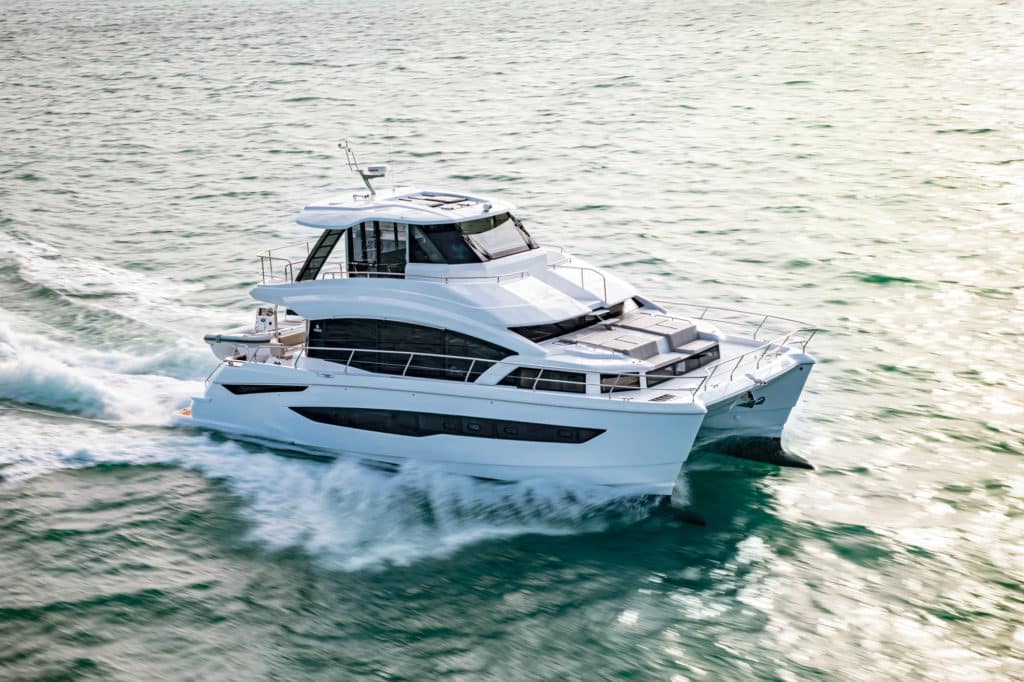
The evolution of the powercat has been steady during the past decade, thanks in part to Aquila Boats . The brand has been around for only nine years, but Aquila has sold more than 360 hulls in that time. I ran its most recent launch, the Aquila 54 Yacht Power Catamaran, in Clearwater, Florida—and learned firsthand why 27 hulls were sold before the boat even launched.
“We’re one of only three companies that design powercats this size,” says Lex Raas, head of Aquila’s product development. “The others come from sailing cats, so size and performance are different.”
Raas, who spent many years overseeing multihull design for France’s Leopard Catamarans, says the Aquila 54 came about because of demand for four- to five-stateroom multihulls that could be owner-operated. “You need that length to create these types of luxurious accommodations, not to mention a flybridge,” he says.
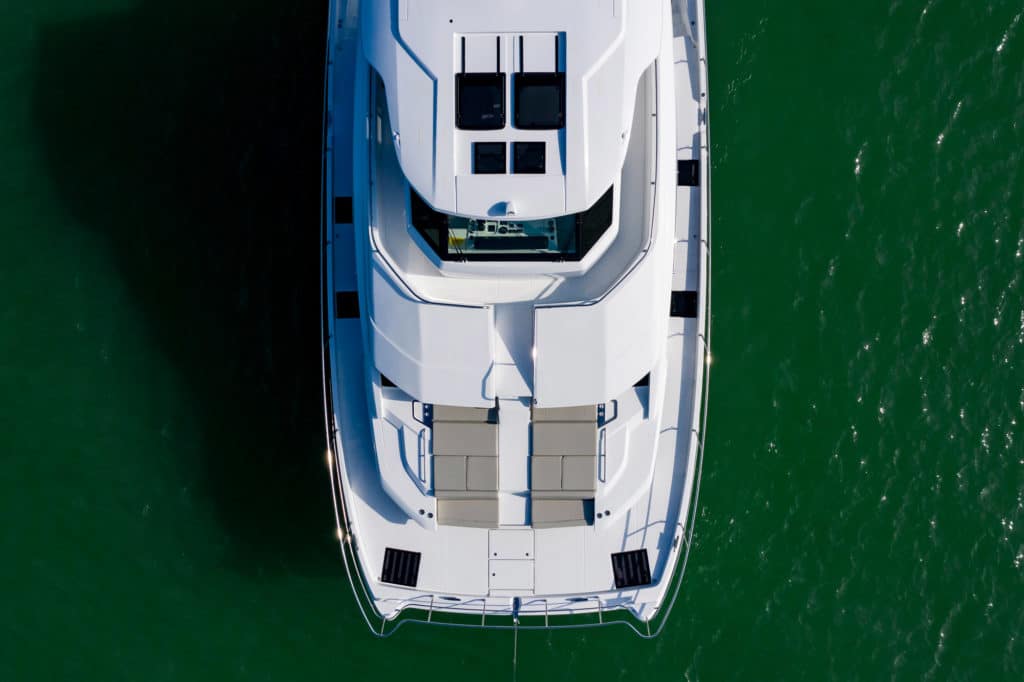
The 54′s interior has square footage that’s roughly the same amount of space as a 68- to 70-foot monohull. It’s also a smartly designed space: The cockpit has a table for alfresco dining, as well as three stools at a bar that connects to the galley inside via an opening window and door. Thanks to the boat’s 25-foot beam, the main deck effectively turns into one vast social area. Add the salon’s seating, 360-degree banks of windows and 6-foot-9-inch headroom, and the area feels more like a waterfront condo than a boat.
Aquila gave this first hull an ash-wood finish (the other choice is dark walnut) for a light, airy feel. The full-beam master stateroom has a queen island berth on centerline, with hullside windows and a few dressers. To starboard, the head (with two sinks, a toilet and a separate shower stall) is down a few steps. To port is enough cabinet stowage for long cruises.
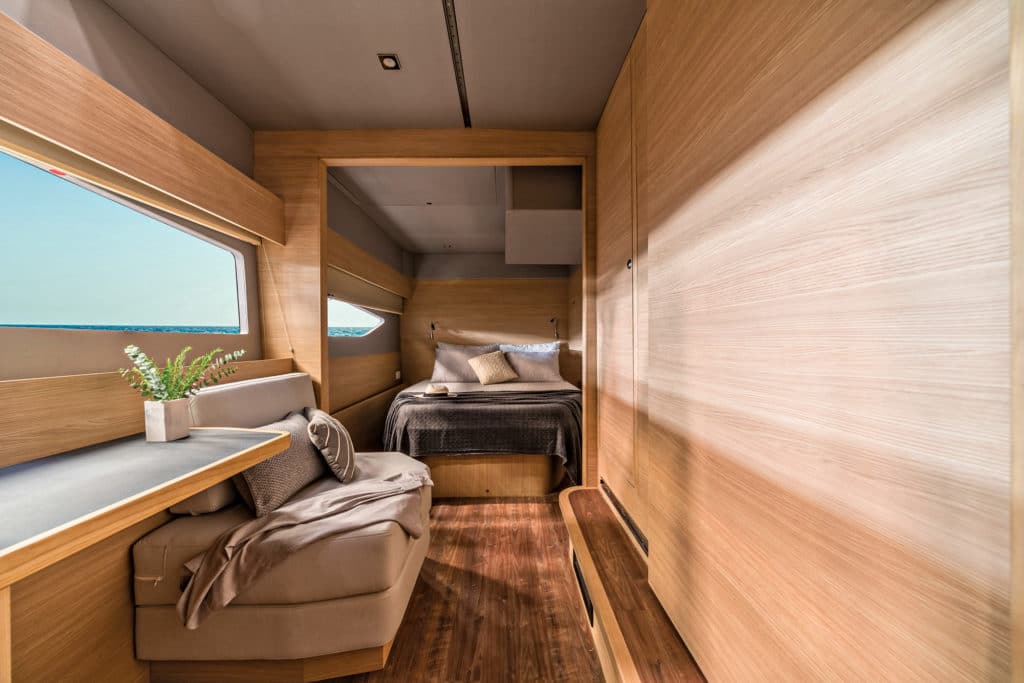
The guest staterooms aft to port and starboard each have a dressing and seating area, as well as a head with an enclosed shower. The fourth stateroom, with twin berths and a separate entrance from the cockpit, can serve as crew quarters or a crash pad for two teenagers. This stateroom’s head also works as a day head.
My favorite part of the 54 was the optional sky lounge. The area can be sealed on rainy days or opened in sunny weather. Visibility from the twin helm seats is unobstructed, while the lounge area abaft those seats is its own ecosystem. Farther aft is a Kenyon grill.
The sky lounge also provides access to the foredeck via a Portuguese bridge and centerline stairs down to the bow. The setup not only makes moving between the bridge and foredeck simple, but it also provides a second route to get around the boat. Lounges on both sides of the stairs forward turn the bow into a private nook.
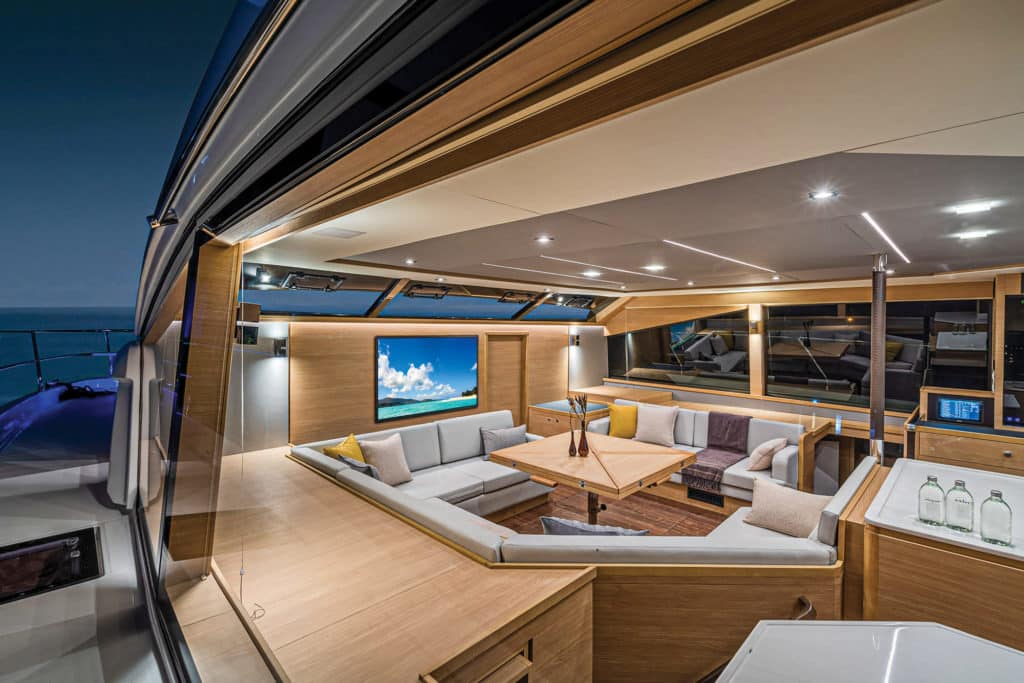
We left Clearwater for a short run along the Intracoastal Waterway and then out into the Gulf of Mexico. There was only a small chop, with 1- to 2-foot rollers, and the 54 felt like it was riding high off the water. One of a multihull’s advantages is minimal roll; pitch was also minimized by the foot-long underwater bulbs on the forward edges of the hulls. Those bulbs provide additional buoyancy and increase speed in displacement mode.
The hulls also plane, and with the upgraded 480 hp Volvo Penta D8 diesel inboards, this 54 reached a top-end speed of 22 knots; cruise speed was 15.5 knots. At 7.8 knots, its range is about 957 nautical miles. (Standard engines are twin 380 hp Volvo Penta D6s, and maximum power is twin 550 hp Cummins QSB6.7 diesels.)
Regarding style, J&J Design helped Aquila to give this power catamaran a yachtlike look, including keeping the profile sleeker than usual. Aquila also used well-known marine brands—many of them from US equipment-makers—throughout the yacht. Besides the Volvo Penta powerplants, the 54 has Kohler generators, Raymarine chart plotters and autopilot, SeaStar steering, a CZone system, Fireboy fire suppression, a Fusion stereo, and more. Raas says Aquila wanted owners to be assured they could service their boats in the United States.
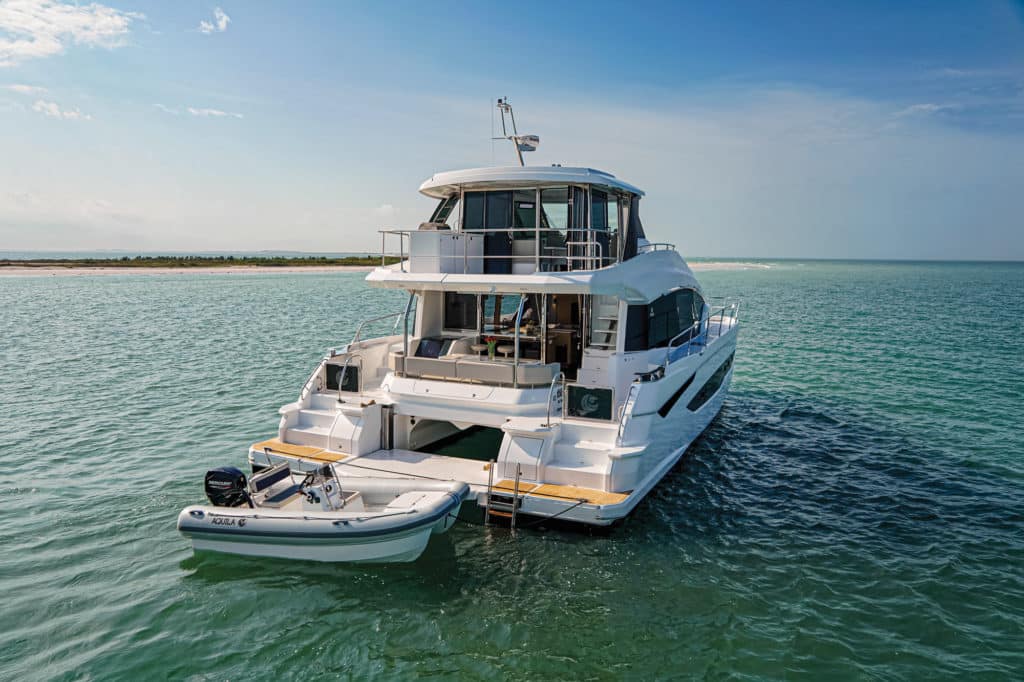
Ironically, in that context, many of the 27 Aquila 54s that have been pre-sold are going to the Mediterranean, Asia and the Caribbean. “We hit all the right targets with this yacht,” Raas says, adding that pricing ranges from $1.5 million to $2.5 million.
What’s next for Aquila? According to Raas, potentially even bigger models. “We’re going to see the cat market explode,” he says. “Already, we’re seeing foils being adapted to catamarans, and other builders are coming up with innovative outboard versions.”
Take the next step: aquilaboats.com
- More: aquila , Aquila Boats , Catamarans , May 2021 , Power Catamarans , Powercats , Reviewed , Yacht Reviews , Yachts
- More Yachts

Compass’ New Luxury Limo Tender

Nauta Reveals Details of the XP75

Two Sirena Yachts Are Better Than One

Custom Line 140′ Launches

Valo’s Foiling PWC

Palm Beach Motor Yachts 45 Sedan For Sale

- Digital Edition
- Customer Service
- Privacy Policy
- Email Newsletters
- Cruising World
- Sailing World
- Salt Water Sportsman
- Sport Fishing
- Wakeboarding
- Apply for Vendor
- Vendors List
- Delivery & Payments

Aquila 54 Review
topRik team talks about their experience testing the Aquila 54 motor catamaran from the Aquila shipyard Power Catamarans - a joint brainchild of the Chinese company Sino Eagle Yachts and American MarineMax.
- FEATURES OF AQUILA 54
- MAXIMUM SPEED AND FUEL CONSUMPTION
At the Transom
Inside the cockpit, checking out the saloon, in the cabins, at the bow deck, on the flybridge.
- ADVANTAGES OF AQUILA 54
- REVIEWS OF AQUILA 54 FROM PROFESSIONALS
- VIDEO REVIEWS OF AQUILA 54
The review is accompanied by photographs, layout plans and videos, we also traditionally present the opinion of famous yachting media about this Multihull of the Year 2021 winner with links to reviews from leading yachting journalists.
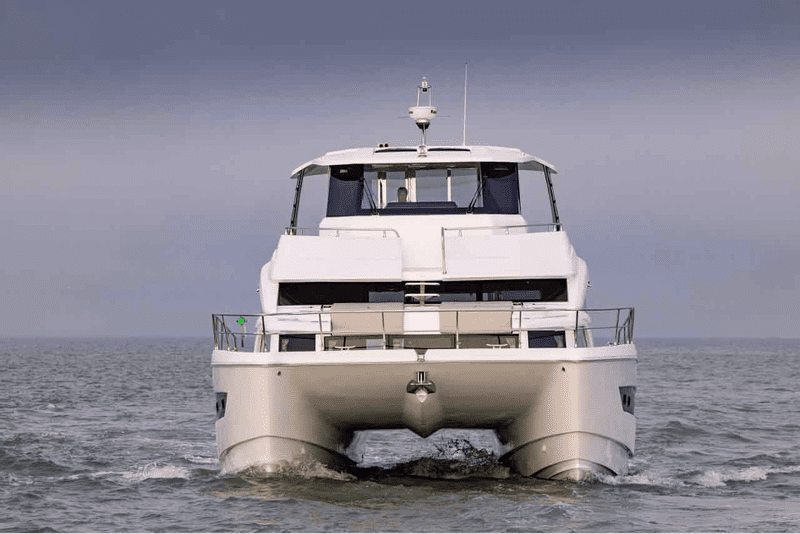
Yes, we remember: some representatives of the European and American maritime community laughed at the flowery statements of the new Chinese-American shipyard Aquila Power Catamarans. But very soon these chuckles about the shipyard’s “world leadership in the mass production of motor catamarans” began to fade as sales grew and the victories of Aquila catamarans in international competitions became more frequent.
The world premiere of the motor cat Aquila 54 was a triumph - it won the recently held Multihull of the Year 2021 competition. This confirms the predictions of experts that multihull yachts are becoming increasingly in demand, since a separate competition has been organized for them, and that Aquila Power Catamarans unmistakably chose the main direction of production. It should be added that the judges in this new competition were any interested sailors, including the owners of the nominated boats. 8,300 votes were cast for the nominees and winners of 2021, making the victory of the hero of our review more convincing.
But motor catamarans are also produced by more famous shipyards. Why was the prize given to Aquila 54? The secret was revealed by representatives of the shipyard, explaining that this success was due to demand studies and painstaking work to improve performance. Research conducted by shipyard marketers showed that catamaran owners and potential buyers of monohulls are dissatisfied with the fact that these boats are too... boxy. Well, something that was constantly mentioned by topRik experts, who compared flybridge catamarans with floating houses of the Victorian era. The sailors wanted the boat (especially the large one) to look not like Aunt Paulie’s cottage, but like a superyacht. And Aquila Power Catamarans gave them that aesthetic.
The gradually tapering silhouette of the Aquila 54 ends with a flybridge closed on all sides, which looks like the second deck of a superyacht. This effect is enhanced by the Portuguese bridge, the ladder from it to the main deck in the bow and, of course, the solid bow deck.
A distinctive feature of superyachts is the maximum of enclosed deck space, and the developers of Aquila Power Catamarans followed this principle when creating the Aquila 54's exterior.
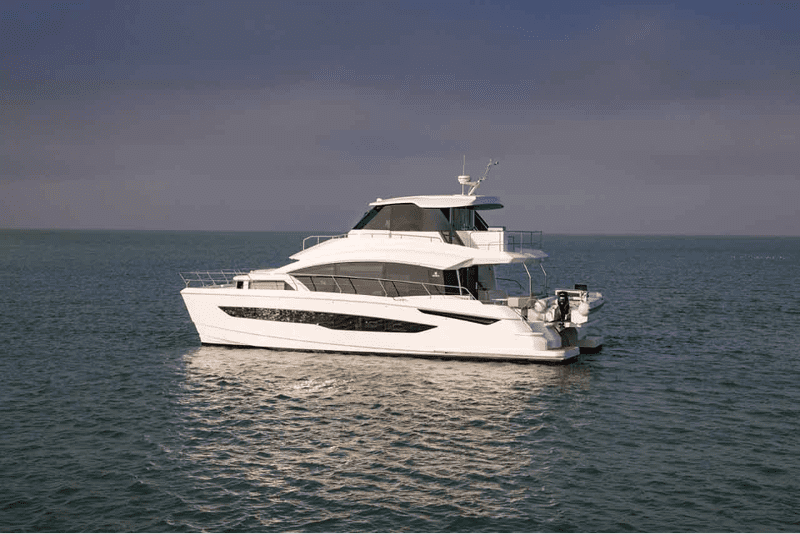
But the aesthetics of a vessel, especially a motor vessel, is not the most important thing for a yachtsman. And the Aquila 54 received their recognition not only for its appearance, but also for its innovations, which significantly improved the performance of the yacht. Actually, the classic inclined stem, bulbous bow and sprayers on each hull are not exactly innovative. These are well-known methods of combating the resistance of the water mass. But at a time when most of the cats from well-known manufacturers switched to a reverse stem, and bulbous bow was considered useless for use on boats less than 20-30 meters in length, the combination of these engineering solutions can be considered an innovation. After all, the main thing is the result, and it is impressive: the maximum cruising speed of the Aquila 54 is 21 knots. Not bad for a cat of this size weighing more than 23 tons (unladen and without passengers). Let’s add: it’s not a sports cat and it is mass-produced.
In our review of the Aquila 42, we already discussed that a significant part of the overall balance of water resistance to the movement of the boat and the engine power consumed is the energy spent on creating waves. These costs can be reduced by transferring the vessel to qualitatively new modes of motion: planing, hydrofoils or air cushion. In such modes of motion, wave resistance is practically absent: the waves that appear as a result of the action of the hydrodynamic pressure field under the bottom of the glider or hovercraft are usually small and the power spent on overcoming pressure resistance is much less than the power required to overcome friction forces and air resistance. However, to transfer the vessel to a new mode of motion, a sufficiently large engine power is required, which is selected at the rate of 1 HP for every 25-30 kg of vessel weight. At the same time, a number of complex design problems must be solved.
The main reserve for reducing the wave resistance of a displacement vessel is to reduce the height and mass of the bow wave that occurs in the zone of increased hydrodynamic pressure when the moving hull meets an undisturbed mass of water. The height of this wave and its profile depend on the distribution of hydrodynamic pressure near the stem and displacement along the length of the hull, on the sharpness of the contours of the bow end of the vessel.
Let us compare, for example, the wave formation during the movement of a tugboat and a work boat of the same displacement. When a tugboat with full bow contours moves, a very steep and high wave arises, the bow shaft moves outward from the sides, and the entire vessel appears to be positioned, at bow and stern, on two crests.
The mass of the wave at the stem, which has a strongly pointed bow, is noticeably less than that of a tugboat. We can confidently say that with equal engine power, such a boat can reach higher speeds than a tugboat. Thus, by changing the bow contours of the hull, the designer can reduce the power required to create a bow wave system.
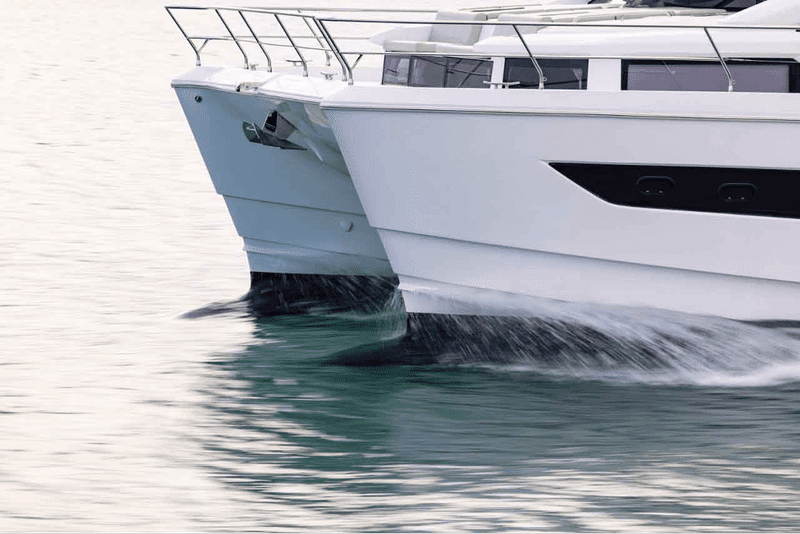
The height of the bow breaker on a boat with a sharp entry waterline can be reduced by installing splash guards or sprayers on the sides above the waterline. It is necessary to identify areas of the sides that are wetted with water while moving, and attach the pads to them. A slight inclination of the spray deflectors is needed so that when meeting a wave they do not “stick” into the water and do not “drown” the bow. Correctly placed pads help the boat overcome the oncoming wave and cut off the water, preventing it from rising to the deck.
The characteristic impedance can be reduced by using the principle of interference - the superposition of two successive wave systems in such a way that they cancel each other out. One of the constructive solutions to this problem is to use bulbous contours of the bow end of the vessel.
Bulb, which is a well-streamlined body moving underwater in front of the ship's stem, forms its own wave. The stream of water running down from the bulb approaches the point where the crest of the bow wave rises with low pressure (if there were no ship's hull, a depression would form here on the surface of the water). The trough of the wave from the bulb is superimposed on the crest of the wave from the stem. As a result, the bow wave “settles”, and the height of transverse waves along the entire length of the vessel also decreases. Studies have shown the possibility of reducing the overall resistance of the vessel as a result of using a bulb up to 18%, which gives an increase in speed with the same engine power of up to 4-5%.
And since the catamaran is not a planing vessel, but a displacement vessel, the developers also used bulbous bow, splitters, and a few more tricks to improve the performance of the Aquila 54.
The increased clearance of the tunnel between the hulls of the catamaran is noticeable to the naked eye when compared with models of the same size from other manufacturers. This prevents even a strong wave from reaching the solid bow deck, which is used on this skate instead of traditional nets (trampolines). In addition, the wave divider running through the center of this tunnel also reduces the force of the oncoming flow.
Now let’s see how all of this works in practice!
Features of Aquila 54
- Brand: Aquila
- Hull type: Catamaran
- Overall length, m: 16.5
- Overall length, ft: 54
- Width, m: 7.68
- Draft, m: 1.37
- Displacement, t: 23.3
- Water tanks, l: 1000
- CE Certification: A - 12 pax, B - 12 pax, C - 20 pax, D - 30 pax
- Engines: 2x D6 380 HP Volvo Penta Inboard Diesel
- Engine quantity: 2
- Power, HP: 2 x 380
- Option engine: 2 x D6 480 HP Volvo Penta Inboard Diesel / 2 x 550 HP Cummins QSB6.7 Inboard Diesel
- Fuel tanks, l: 2200
- Propeller type: 4 Blade
Maximum Speed and Fuel Consumption
Review of aquila 54 by toprik team.
topRik experts expressed their first impression of the Aquila 54 catamaran in the introductory part of the article, perhaps overusing technical details a little. We will begin our study of the boat right from the transom. Keep up!
There is a lot to see and admire here. This is what this part of the catamaran looks like when fully assembled while moving. Both gates leading to the cockpit are closed, the middle part of the platform is raised.
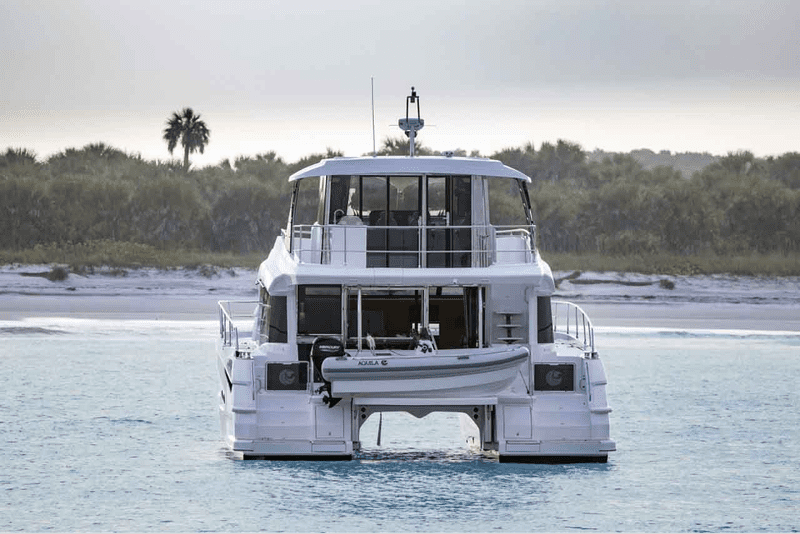
The RIB placed on it is supported by a pulley system assembled on a special dinghy beam.
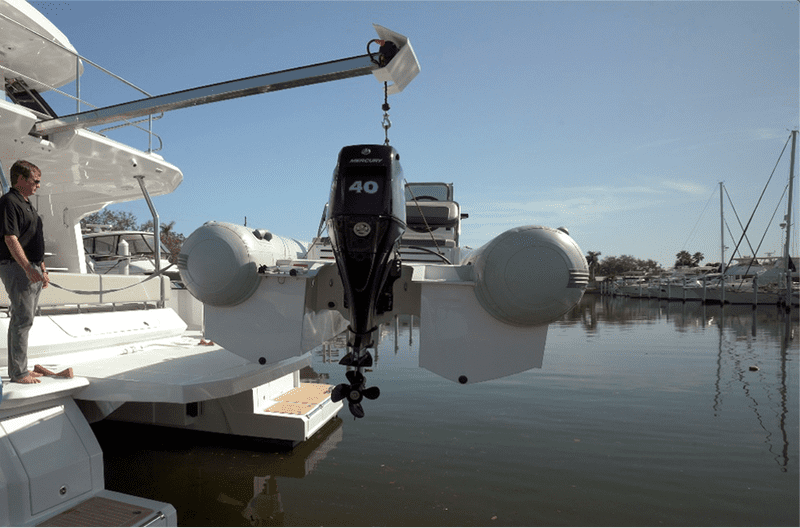
But if you are going to make a stop at sea or ocean (the design of the Aquila 54 is CE certified for access to the ocean, provided there are no more than 12 passengers on board), then this part of the catamaran will become a private beach for passengers at their own recreation center.
The platform descends to the level of the lowest steps of the ladder, and you get a huge “coastline” without stones, pebbles, shells and uneven terrain. You can use the outboard ladder to go down into the water and from the platform to switch to other floating devices from a set of various water toys.
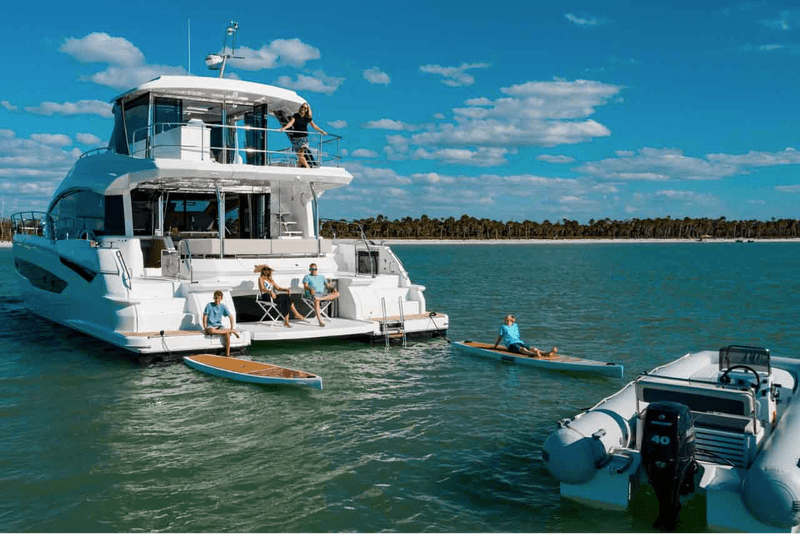
The middle can be used as a terrace for a beach cafe. Moreover, you don’t have to go far for drinks and ice cream - they are in the refrigerators of the saloon and flybridge... But it seems that we are getting ahead of ourselves. For now, we only have to climb into the cockpit through any of the gates located on both sides.
Oh no, this cockpit is not “just” an area. This is a fairly spacious space with a large aft C -shaped sofa from gate to gate. It is deployed into the cockpit and goes around a large table on 3 sides. There is enough room on the fourth side of the table to place additional chairs if a large group gathers for lunch.
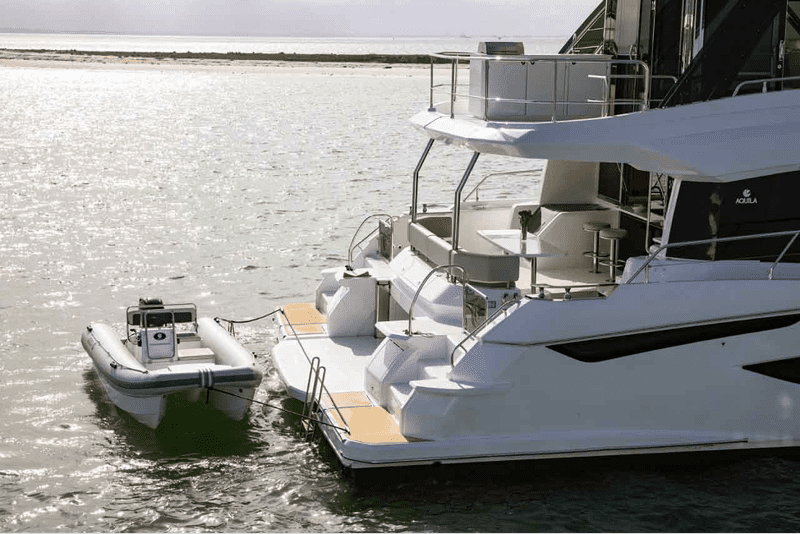
If there is not enough space for someone at the table, they can sit on stools in front of the bar counter, the role of which is played by one of the galley tables located in the saloon. In order to organize a bar in the cockpit, you just need to raise part of the partition between the cockpit and the saloon.
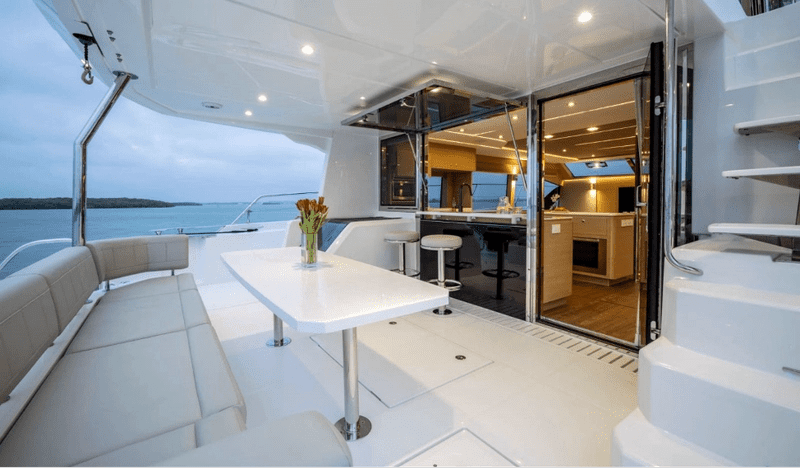
On the left side there is an entrance to one of the passenger cabins and a ladder to the side deck, on the right there is a ladder to the side deck.
The transparent shaded partition between the saloon and cockpit consists of several parts, including a large door and opening windows. In case of bad weather and during a cruise in cold seas, the cabin can be tightly “battened down” and the heating system can be turned on.
But since the saloon door is hospitably open, let’s go there next! But first (albeit with some delay) we suggest that you familiarize yourself with the layout of the main deck. We have already passed some of its zones, but we still have a lot left, so the layout plan will help to locate the objects and zones, which we will talk about later.
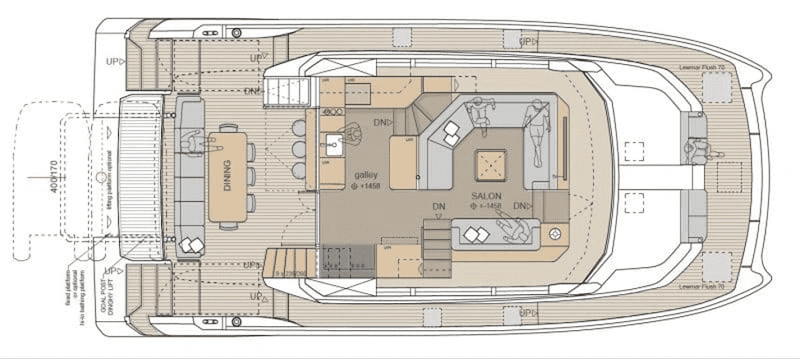
It is difficult to fit the entire huge interior in one photo, so we will explore it in parts. To the port side, as you may have guessed, there is a full-fledged galley, or rather, a well-equipped home kitchen. A table with a large work surface is located near the window overlooking the cockpit.
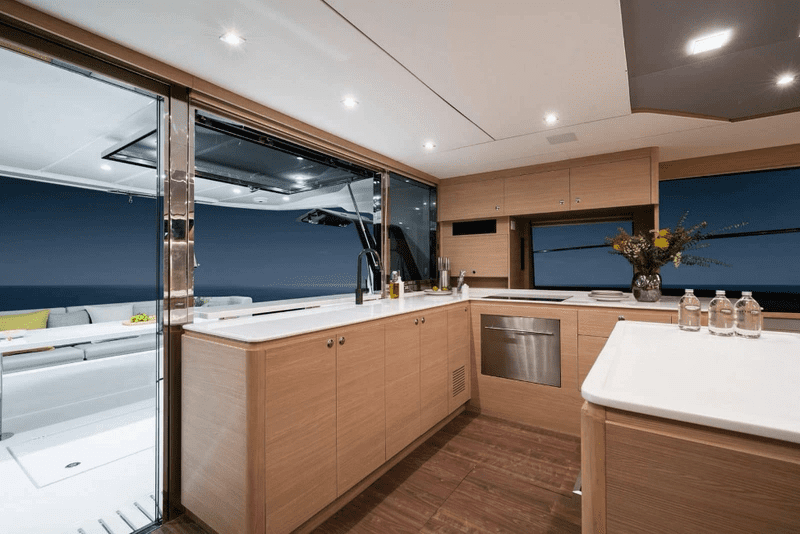
The owner can fill all other tables, cabinets, shelves and niches with any kitchen equipment he needs from the standard and optional list, kitchen utensils, dishes and products of different shelf life, including in a large refrigerator or freezer. The owner can choose the version of the stove (induction, gas, electric, etc.), oven, grill (plancha), dishwasher and other kitchen equipment.
Some of the refrigeration and freezing equipment (for wine, in particular) is located in the island cabinet, which separates the galley from the saloon, and its work surface serves as another bar counter for serving dishes from the galley to the saloon dining area.
But the largest refrigerator is located on the opposite side along with additional storage space. And the other part with an electrical panel and indicators that record the vital activity of all cat systems can be used as a chart table - there is also a drawer for storing paper maps. Of course, this is more of a tribute to tradition, and the fully equipped and secure helm station is located on the flybridge.
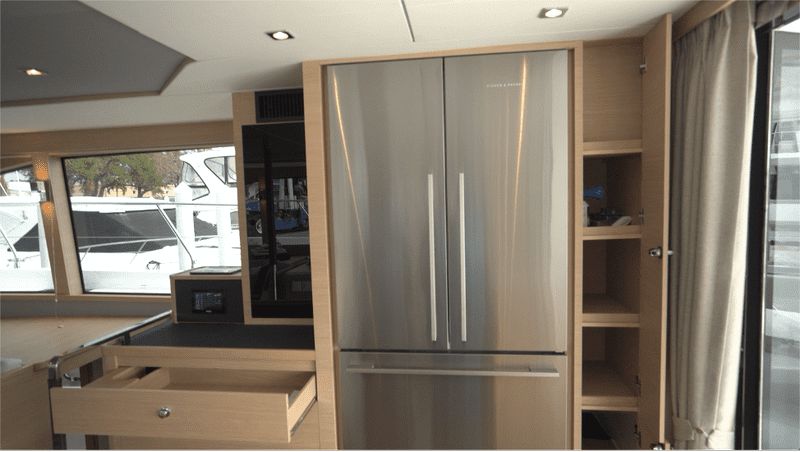
Another version of the Aquila 54 layout is available, in which the galley is located below, in place of one of the cabins of the 5-cabin version in the starboard hull. Then the space on the main deck that was intended for the galley will be occupied by soft, comfortable armchairs or a sofa near the cocktail (coffee) table.
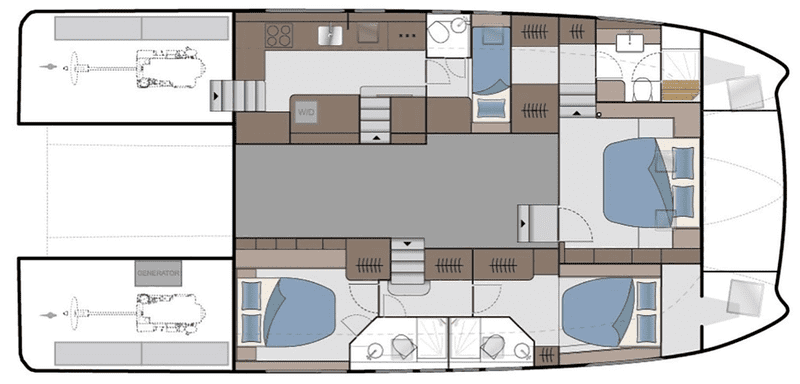
A significantly larger part of the saloon is dedicated to the “dining room,” or a place where all the inhabitants of the catamaran can gather for lunch, an evening cocktail, a friendly conversation or a party, what is called the wardroom on superyachts.
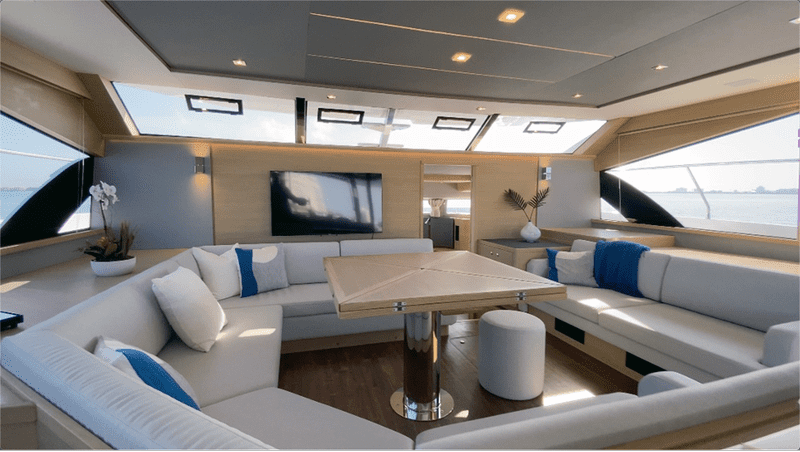
A large sofa in the shape of a pentagon without one side, where you can place poufs and a comfortable sofa along the starboard side, and in the middle - just a huge folding table - it can easily accommodate up to 20 people.
Well, as is usual with modular furniture on Aquila boats, this dining area, if necessary, can turn into a large sleeping area if you lower the tabletop and cover it with mattresses. What if unexpected guests have to spend the night on the yacht - anything can happen on cruises.
And of course, all conditions have been created for overnight accommodation for the yacht’s passengers and crew. In order to be convinced of this, you need to go down to the cabins: some from the deck, and some directly from the saloon.
In the owner's version of the Aquila 54 the master cabin does not change its location across the entire width of the catamaran's bow - in versions with 3, 4 and 5 cabins, as well as when equipped with crew cabins in the forepeaks.
The diagrams below show the 4- and 5-cabin versions. The 3-cabin version is easy to imagine without a separate layout: a master cabin in the bow and one cabin in each float.
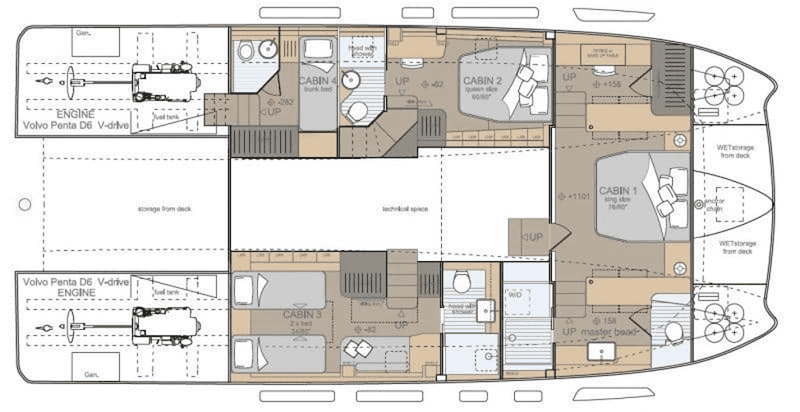
The master cabin is similar in comfort to a luxury hotel room, with a living room, a bedroom, and a separate bathroom with an isolated shower. The bathroom is located one floor below.
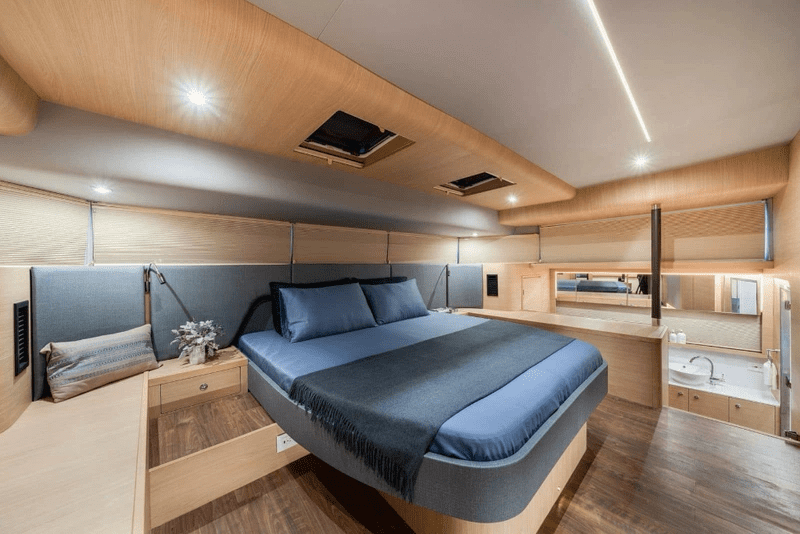
In the photo above, guests have gotten ready for bed and drawn the curtains, but if you open them, you will see that there is plenty of natural light, as well as fresh air coming through the skylights.
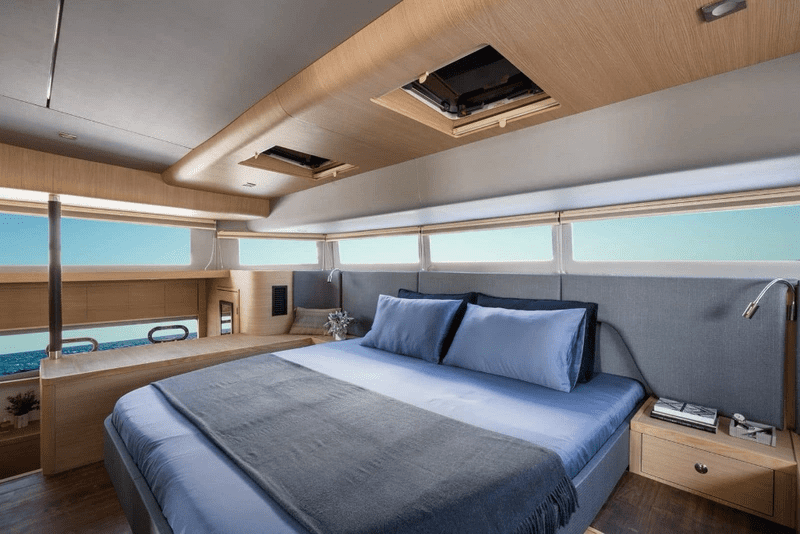
As in the cabins, which are located in the right and left floats. There is also a living room with a sofa and dressing table.
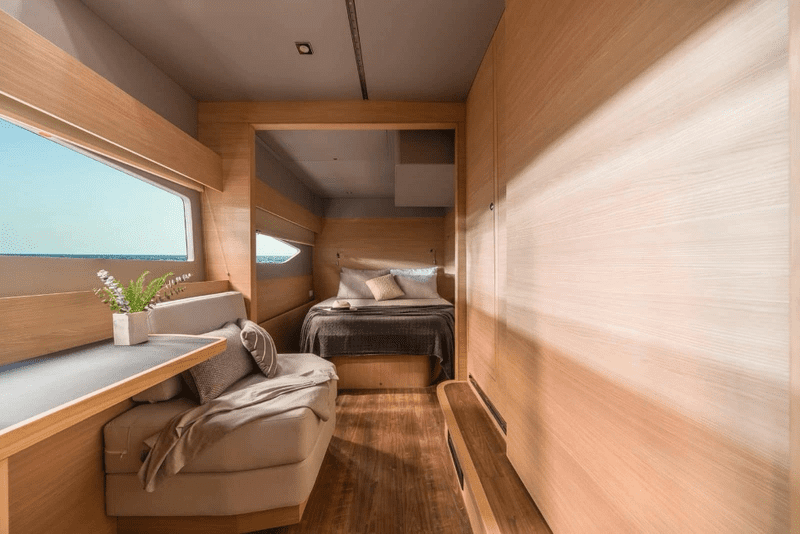
All cabins are equipped with separate bathrooms with everything necessary for hygiene procedures: washbasins, showers, toilets, mirrors, cabinets for storing toiletries.
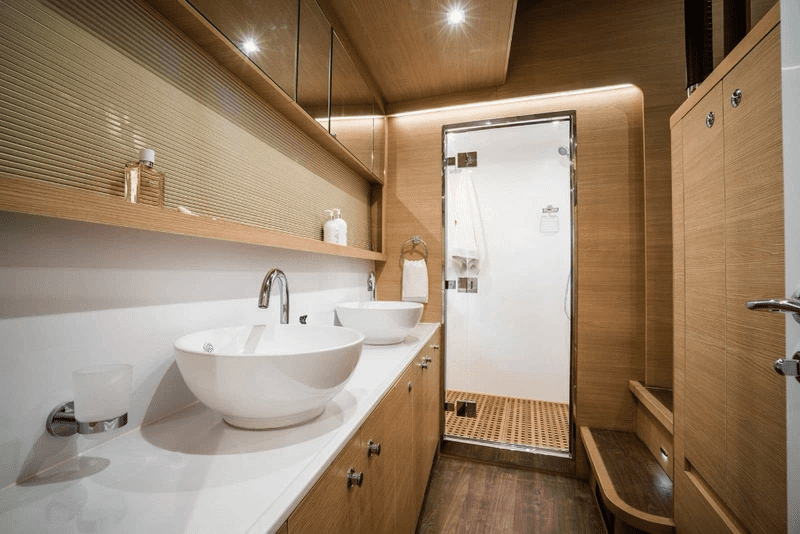
Why do we go from the saloon to the foredeck, and not up to the flybridge? Because in the version we tested, there is no ladder from the saloon or cockpit, and we can only get to the flybridge via a ladder that leads there from the foredeck.
If you plan to permanently stay on the Aquila 54 in regions with a warm climate and lack of stormy weather, then the absence of an internal ladder is not particularly important. But in colder climates or in regions with frequent adverse weather conditions, it is still better to use the option of a ladder from the saloon so as not to go outside during a storm or cold.
The bow deck of the catamaran is another confirmation that we are dealing with a pleasure yacht: it is completely dedicated to an area with sun loungers, mattresses, pillows and sunbeds for every taste.
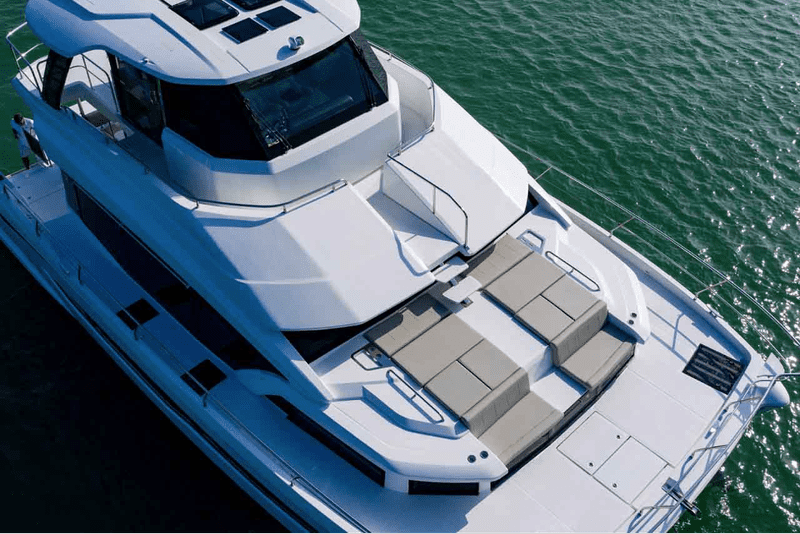
In the center of the bow there is a chain box with an anchor installation, and in the bow of each hull there is a hatch leading to the forepeak, which can be equipped as a crew cabin or an additional storage compartment.
A gangway between two rows of sun loungers leads to the flybridge.
Traditionally, we suggest that you familiarize yourself with the layout plan of this zone before learning more about it.
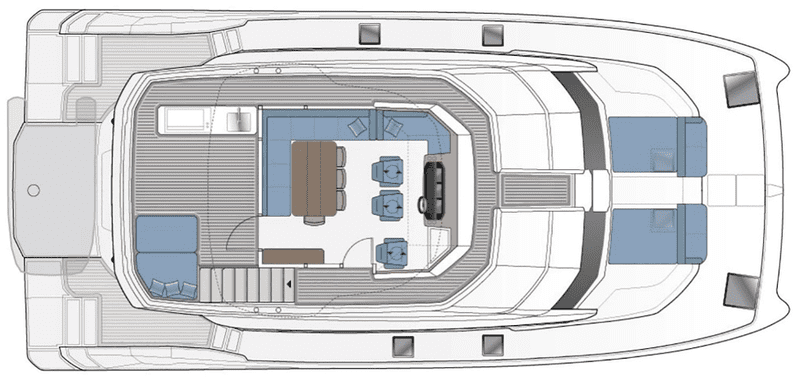
As can be seen from the plan, a large area of the flybridge is also given over to the social area, which includes a sunbathing area, galley and dining area.
The work area is a small area under the helm station with a helm panel and a row of seats, which, at the owner’s request, can be individual for the skipper, assistant and observer, or can be paired for the helmsman and assistant.
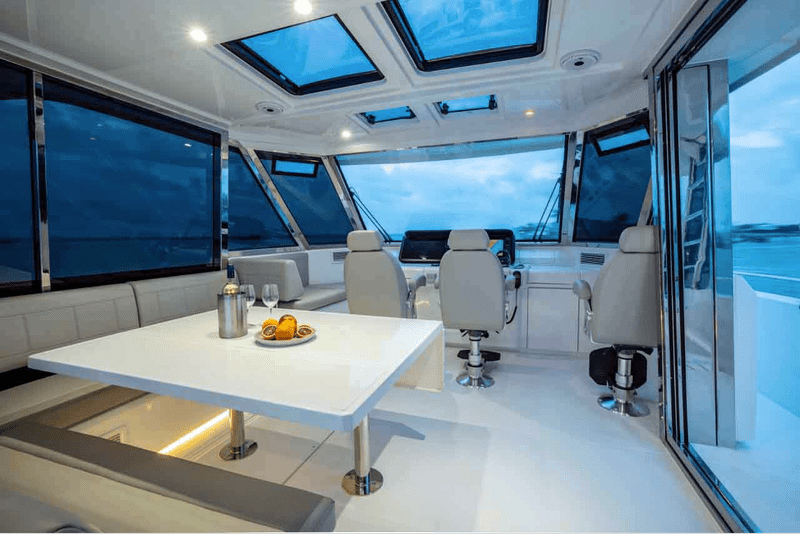
The well-equipped helm panel is intuitive even for beginners. In addition to the standard list, the owner is given the opportunity to supplement the panel with all the necessary equipment that he cannot do without on a cruise, including an additional display and indicators.
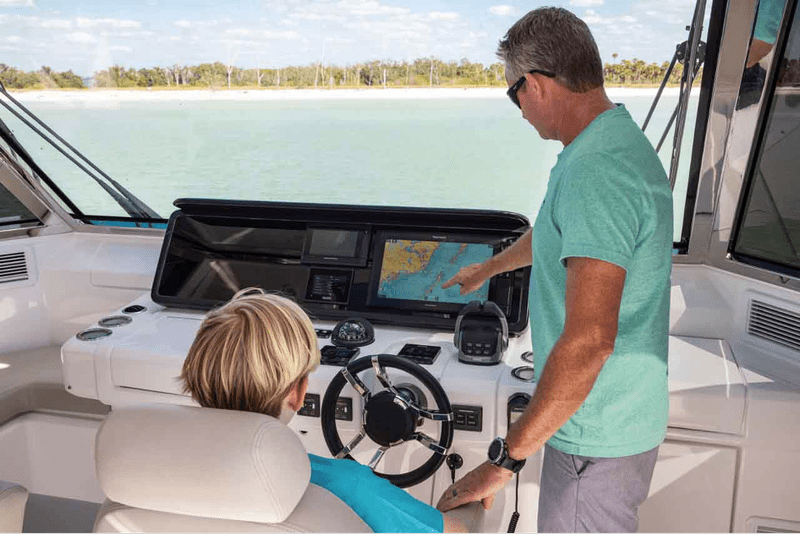
Almost all of these partitions, windows and hatches overhead can be opened if there is no need for climate control. Lots of air, lots of light and excellent all-round visibility from such a height... The flybridge is definitely a favorite place for the inhabitants of Aquila 54, especially considering that there is both a grill and refrigeration units.
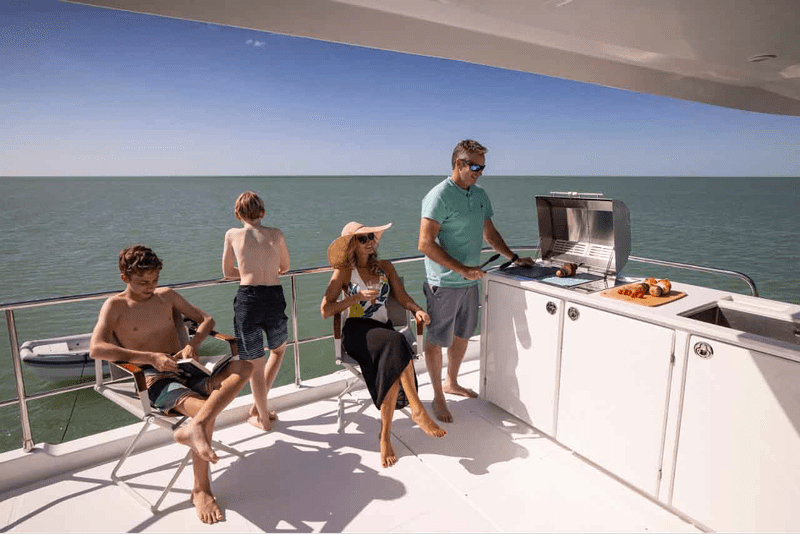
topRik experts were able to quickly verify that the stated maximum speed was even slightly underestimated. The catamaran that the topRik team tested was equipped with a pair of Volvos Penta D6, 480 HP. Therefore, at 3600 rpm we reached a maximum speed of 21 knots, and at 3650 rpm the speed indicator approached 22 knots.
Well, let's stop at the fact that the maximum cruising speed is 21 knots with a fuel consumption of about 185 l/h. topRik experts considered a speed of 17 knots with a fuel consumption of 127 l/h to be comfortable. If you need to enter an efficiency mode, but still move faster than a sailboat, then pay attention to the speed of 11-12 knots with fuel consumption of 77 and 95.5 l/h respectively.
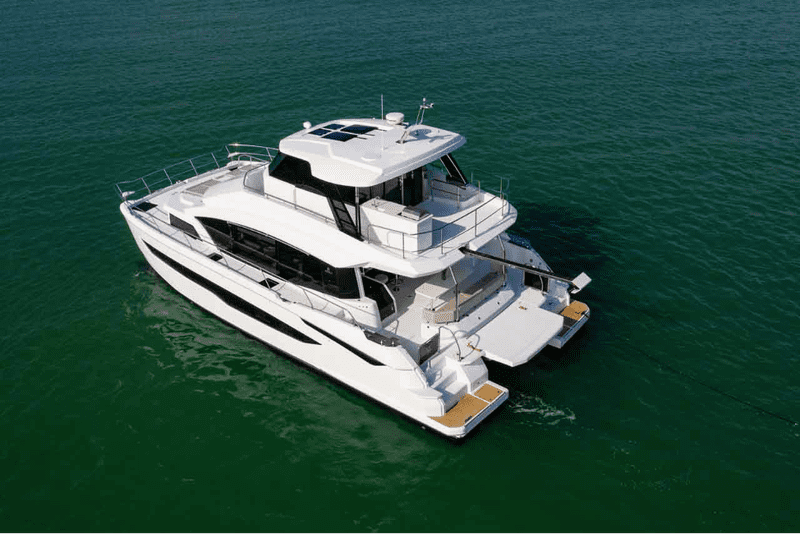
Advantages of Aquila 54
Since we are accustomed to starting this section with shortcomings, one of our crew members complained that the railing of the bow gangway doesn’t continue go for all its length. For an experienced sailor or trained passenger this is not a problem, but the boat can be purchased for a family with elderly people and small children. The team supported this claim and arguments.
In all other respects, the Aquila 54 motor catamaran is impeccable: from ease of driving to performance, from comfort for passengers and helmsman (crew) to huge areas for recreation.
Unusually comfortable, if the owner wishes, it is a luxury yacht, close in spirit and appearance to superyachts. At the same time, it has excellent driving characteristics - decent cruising speed, efficient fuel consumption, simple controls and responsiveness to steering.
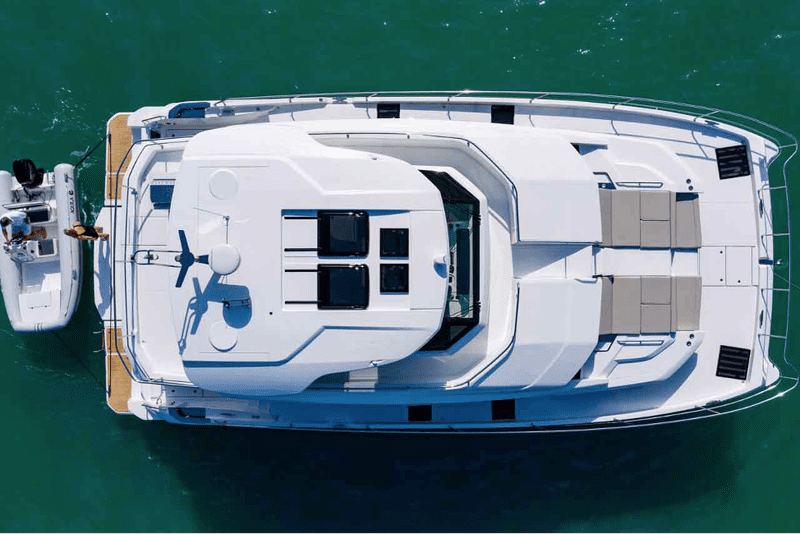
Reviews of Aquila 54 from Professionals
Yacht Style magazine, which positions myself as Asia's leading yachting lifestyle media, posted review dedicated to Aquila 54 by Dominic Salandre.
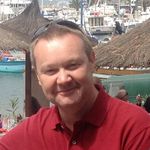
Dominic did not leave the summary for the last paragraphs of his review and immediately stated that the global sales of the Aquila 54 in the Asian market are facilitated by its exterior, interior and driving characteristics.
The author did not fail to refer to the history of the brand’s creation, mentioning the merits of Lex Raas in the rapprochement of Chinese Sino Eagle and the American MarineMax, which resulted in the emergence of a new brand of motor catamarans, which, according to the observer, has quickly gone through the process of formation since 2012, and some models, including the 54th, occupy leading positions in sales not only in Asia.
Dominic noted the customization of the Aquila 54, which allows each owner to configure the catamaran to their own taste. He described in detail all the features of the interior and the capabilities of the modular system, as well as the choice of configuration options for cabins, galley, etc., which are provided by the developers for future owners.
He especially noted the comfortable conditions on board and described the motor catamaran as a solid cruiser, paying special attention to manufacturing features and design innovations.
In conclusion, the author focused on the speed characteristics of the Aquila 54.
Video Reviews of Aquila 54
Time to see how this yacht looks in motion. We gathered best videos on this model that we could find.
First, short and informative review by the Boat Show:
Next, video from the Aquila Boats themselves:
Another review from Aquila Boats, but this one lasts for 25 minutes and has tons of information:
Unique experience of this yacht’s owner from his own perspective:
Short teaser showcasing main features in case you want to check out basics only:
It is impossible to name a category of lovers of comfortable and safe cruises, including the ocean crossings, who would not be suitable for this boat.
From the father of a family to a romantic couple, from lovers of cruises in a large group of friends to those who like to spend holidays in a small group, from beginners in sailing to experienced sailors who want to take a break from the sails - Aquila 54 is a long-awaited dream for everyone. Which, by the way, can easily be turned into reality through the topRik marketplace. Based on our own experience, our experts unanimously stated that the catamaran will also be in demand among charter companies.
Where to Buy Aquila 54 at a Bargain Price
If you want to buy this incredible yacht at a good price, the topRik team is at your service. You can entrust us with the entire process - from negotiations with the manufacturer about a favorable price for you and to the delivery of the yacht to the location you specify. In this case, we will take care of the paperwork and control of the equipment at the place of production or shipment of the catamaran.
All preliminary consultations are free, the virtual configurator is free also.
Or we can provide ongoing purchase support so that you do not make any mistakes at any stage.
Call our experts using the phone number above, use the website feedback form, or send a message to [email protected] .
No posts found
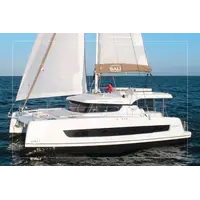
- Glossary of Nautical Terms
- Law & Rules

- Profile details
- Comparison list
- Gift certificates
- Terms of Use
- Privacy Policy
- Refund Policy
- Tallinn, Ehitajate tee 110
- +37253060890
- Mon-Sun 10.00 - 18.00
- [email protected]
- View on map
- Leave feedback

Aquila 54 is Open for Inspection
Saturday 17th to friday 30th, december.
We invite you to inspect the Award-winning Aquila 54 on the Gold Coast for a limited time.
Viewings are by appointed only, so register your interest below to inspect this incredible vessel.
Spectrum Marine Runaway Bay Marina
Shop 1A, 251 Bayview Street, Hollywell, Gold Coast
The award-winning A54.

Yacht Power Catamaran
The Aquila A54 is a game changer. Crowned the Multihull of the Year, the options are endless. Select from three, four or five cabin layouts. Enclose the flybridge or leave it open for a sporty feel. With the A54, the choice is yours.

INSPECT THE A54 ON THE GOLD COAST
Register your interest and preferred day to inspect the A54 and we’ll be in touch to confirm an inspection time.
what tense is a research proposal written in
Have a language expert improve your writing.
Run a free plagiarism check in 10 minutes, generate accurate citations for free.
- Knowledge Base
- Verb Tenses in Academic Writing | Rules, Differences & Examples
Verb Tenses in Academic Writing | Rules, Differences & Examples
Published on September 22, 2014 by Shane Bryson . Revised on September 18, 2023.
Tense communicates an event’s location in time. The different tenses are identified by their associated verb forms. There are three main verb tenses: past , present , and future .
In English, each of these tenses can take four main aspects: simple , perfect , continuous (also known as progressive ), and perfect continuous . The perfect aspect is formed using the verb to have , while the continuous aspect is formed using the verb to be .
In academic writing , the most commonly used tenses are the present simple , the past simple , and the present perfect .
Table of contents
Tenses and their functions, when to use the present simple, when to use the past simple, when to use the present perfect, when to use other tenses.
The table below gives an overview of some of the basic functions of tenses and aspects. Tenses locate an event in time, while aspects communicate durations and relationships between events that happen at different times.
It can be difficult to pick the right verb tenses and use them consistently. If you struggle with verb tenses in your thesis or dissertation , you could consider using a thesis proofreading service .
Check for common mistakes
Use the best grammar checker available to check for common mistakes in your text.
Fix mistakes for free
The present simple is the most commonly used tense in academic writing, so if in doubt, this should be your default choice of tense. There are two main situations where you always need to use the present tense.
Describing facts, generalizations, and explanations
Facts that are always true do not need to be located in a specific time, so they are stated in the present simple. You might state these types of facts when giving background information in your introduction .
- The Eiffel tower is in Paris.
- Light travels faster than sound.
Similarly, theories and generalizations based on facts are expressed in the present simple.
- Average income differs by race and gender.
- Older people express less concern about the environment than younger people.
Explanations of terms, theories, and ideas should also be written in the present simple.
- Photosynthesis refers to the process by which plants convert sunlight into chemical energy.
- According to Piketty (2013), inequality grows over time in capitalist economies.
Describing the content of a text
Things that happen within the space of a text should be treated similarly to facts and generalizations.
This applies to fictional narratives in books, films, plays, etc. Use the present simple to describe the events or actions that are your main focus; other tenses can be used to mark different times within the text itself.
- In the first novel, Harry learns he is a wizard and travels to Hogwarts for the first time, finally escaping the constraints of the family that raised him.
The events in the first part of the sentence are the writer’s main focus, so they are described in the present tense. The second part uses the past tense to add extra information about something that happened prior to those events within the book.
When discussing and analyzing nonfiction, similarly, use the present simple to describe what the author does within the pages of the text ( argues , explains , demonstrates , etc).
- In The History of Sexuality , Foucault asserts that sexual identity is a modern invention.
- Paglia (1993) critiques Foucault’s theory.
This rule also applies when you are describing what you do in your own text. When summarizing the research in your abstract , describing your objectives, or giving an overview of the dissertation structure in your introduction, the present simple is the best choice of tense.
- This research aims to synthesize the two theories.
- Chapter 3 explains the methodology and discusses ethical issues.
- The paper concludes with recommendations for further research.
The past simple should be used to describe completed actions and events, including steps in the research process and historical background information.
Reporting research steps
Whether you are referring to your own research or someone else’s, use the past simple to report specific steps in the research process that have been completed.
- Olden (2017) recruited 17 participants for the study.
- We transcribed and coded the interviews before analyzing the results.
The past simple is also the most appropriate choice for reporting the results of your research.
- All of the focus group participants agreed that the new version was an improvement.
- We found a positive correlation between the variables, but it was not as strong as we hypothesized .
Describing historical events
Background information about events that took place in the past should also be described in the past simple tense.
- James Joyce pioneered the modernist use of stream of consciousness.
- Donald Trump’s election in 2016 contradicted the predictions of commentators.
The present perfect is used mainly to describe past research that took place over an unspecified time period. You can also use it to create a connection between the findings of past research and your own work.
Summarizing previous work
When summarizing a whole body of research or describing the history of an ongoing debate, use the present perfect.
- Many researchers have investigated the effects of poverty on health.
- Studies have shown a link between cancer and red meat consumption.
- Identity politics has been a topic of heated debate since the 1960s.
- The problem of free will has vexed philosophers for centuries.
Similarly, when mentioning research that took place over an unspecified time period in the past (as opposed to a specific step or outcome of that research), use the present perfect instead of the past tense.
- Green et al. have conducted extensive research on the ecological effects of wolf reintroduction.
Emphasizing the present relevance of previous work
When describing the outcomes of past research with verbs like fi nd , discover or demonstrate , you can use either the past simple or the present perfect.
The present perfect is a good choice to emphasize the continuing relevance of a piece of research and its consequences for your own work. It implies that the current research will build on, follow from, or respond to what previous researchers have done.
- Smith (2015) has found that younger drivers are involved in more traffic accidents than older drivers, but more research is required to make effective policy recommendations.
- As Monbiot (2013) has shown , ecological change is closely linked to social and political processes.
Note, however, that the facts and generalizations that emerge from past research are reported in the present simple.
While the above are the most commonly used tenses in academic writing, there are many cases where you’ll use other tenses to make distinctions between times.
Future simple
The future simple is used for making predictions or stating intentions. You can use it in a research proposal to describe what you intend to do.
It is also sometimes used for making predictions and stating hypotheses . Take care, though, to avoid making statements about the future that imply a high level of certainty. It’s often a better choice to use other verbs like expect , predict, and assume to make more cautious statements.
- There will be a strong positive correlation.
- We expect to find a strong positive correlation.
- H1 predicts a strong positive correlation.
Similarly, when discussing the future implications of your research, rather than making statements with will, try to use other verbs or modal verbs that imply possibility ( can , could , may , might ).
- These findings will influence future approaches to the topic.
- These findings could influence future approaches to the topic.
Present, past, and future continuous
The continuous aspect is not commonly used in academic writing. It tends to convey an informal tone, and in most cases, the present simple or present perfect is a better choice.
- Some scholars are suggesting that mainstream economic paradigms are no longer adequate.
- Some scholars suggest that mainstream economic paradigms are no longer adequate.
- Some scholars have suggested that mainstream economic paradigms are no longer adequate.
However, in certain types of academic writing, such as literary and historical studies, the continuous aspect might be used in narrative descriptions or accounts of past events. It is often useful for positioning events in relation to one another.
- While Harry is traveling to Hogwarts for the first time, he meets many of the characters who will become central to the narrative.
- The country was still recovering from the recession when Donald Trump was elected.
Past perfect
Similarly, the past perfect is not commonly used, except in disciplines that require making fine distinctions between different points in the past or different points in a narrative’s plot.
Sources in this article
We strongly encourage students to use sources in their work. You can cite our article (APA Style) or take a deep dive into the articles below.
Bryson, S. (2023, September 18). Verb Tenses in Academic Writing | Rules, Differences & Examples. Scribbr. Retrieved April 11, 2024, from https://www.scribbr.com/verbs/tenses/
Aarts, B. (2011). Oxford modern English grammar . Oxford University Press.
Butterfield, J. (Ed.). (2015). Fowler’s dictionary of modern English usage (4th ed.). Oxford University Press.
Garner, B. A. (2016). Garner’s modern English usage (4th ed.). Oxford University Press.
Is this article helpful?
Shane Bryson
Shane finished his master's degree in English literature in 2013 and has been working as a writing tutor and editor since 2009. He began proofreading and editing essays with Scribbr in early summer, 2014.
Other students also liked
Tense tendencies in academic texts, subject-verb agreement | examples, rules & use, parallel structure & parallelism | definition, use & examples, unlimited academic ai-proofreading.
✔ Document error-free in 5minutes ✔ Unlimited document corrections ✔ Specialized in correcting academic texts

Want to create or adapt books like this? Learn more about how Pressbooks supports open publishing practices.
11.2 Steps in Developing a Research Proposal
Learning objectives.
- Identify the steps in developing a research proposal.
- Choose a topic and formulate a research question and working thesis.
- Develop a research proposal.
Writing a good research paper takes time, thought, and effort. Although this assignment is challenging, it is manageable. Focusing on one step at a time will help you develop a thoughtful, informative, well-supported research paper.
Your first step is to choose a topic and then to develop research questions, a working thesis, and a written research proposal. Set aside adequate time for this part of the process. Fully exploring ideas will help you build a solid foundation for your paper.
Choosing a Topic
When you choose a topic for a research paper, you are making a major commitment. Your choice will help determine whether you enjoy the lengthy process of research and writing—and whether your final paper fulfills the assignment requirements. If you choose your topic hastily, you may later find it difficult to work with your topic. By taking your time and choosing carefully, you can ensure that this assignment is not only challenging but also rewarding.
Writers understand the importance of choosing a topic that fulfills the assignment requirements and fits the assignment’s purpose and audience. (For more information about purpose and audience, see Chapter 6 “Writing Paragraphs: Separating Ideas and Shaping Content” .) Choosing a topic that interests you is also crucial. You instructor may provide a list of suggested topics or ask that you develop a topic on your own. In either case, try to identify topics that genuinely interest you.
After identifying potential topic ideas, you will need to evaluate your ideas and choose one topic to pursue. Will you be able to find enough information about the topic? Can you develop a paper about this topic that presents and supports your original ideas? Is the topic too broad or too narrow for the scope of the assignment? If so, can you modify it so it is more manageable? You will ask these questions during this preliminary phase of the research process.
Identifying Potential Topics
Sometimes, your instructor may provide a list of suggested topics. If so, you may benefit from identifying several possibilities before committing to one idea. It is important to know how to narrow down your ideas into a concise, manageable thesis. You may also use the list as a starting point to help you identify additional, related topics. Discussing your ideas with your instructor will help ensure that you choose a manageable topic that fits the requirements of the assignment.
In this chapter, you will follow a writer named Jorge, who is studying health care administration, as he prepares a research paper. You will also plan, research, and draft your own research paper.
Jorge was assigned to write a research paper on health and the media for an introductory course in health care. Although a general topic was selected for the students, Jorge had to decide which specific issues interested him. He brainstormed a list of possibilities.
If you are writing a research paper for a specialized course, look back through your notes and course activities. Identify reading assignments and class discussions that especially engaged you. Doing so can help you identify topics to pursue.
- Health Maintenance Organizations (HMOs) in the news
- Sexual education programs
- Hollywood and eating disorders
- Americans’ access to public health information
- Media portrayal of health care reform bill
- Depictions of drugs on television
- The effect of the Internet on mental health
- Popularized diets (such as low-carbohydrate diets)
- Fear of pandemics (bird flu, HINI, SARS)
- Electronic entertainment and obesity
- Advertisements for prescription drugs
- Public education and disease prevention
Set a timer for five minutes. Use brainstorming or idea mapping to create a list of topics you would be interested in researching for a paper about the influence of the Internet on social networking. Do you closely follow the media coverage of a particular website, such as Twitter? Would you like to learn more about a certain industry, such as online dating? Which social networking sites do you and your friends use? List as many ideas related to this topic as you can.
Narrowing Your Topic
Once you have a list of potential topics, you will need to choose one as the focus of your essay. You will also need to narrow your topic. Most writers find that the topics they listed during brainstorming or idea mapping are broad—too broad for the scope of the assignment. Working with an overly broad topic, such as sexual education programs or popularized diets, can be frustrating and overwhelming. Each topic has so many facets that it would be impossible to cover them all in a college research paper. However, more specific choices, such as the pros and cons of sexual education in kids’ television programs or the physical effects of the South Beach diet, are specific enough to write about without being too narrow to sustain an entire research paper.
A good research paper provides focused, in-depth information and analysis. If your topic is too broad, you will find it difficult to do more than skim the surface when you research it and write about it. Narrowing your focus is essential to making your topic manageable. To narrow your focus, explore your topic in writing, conduct preliminary research, and discuss both the topic and the research with others.
Exploring Your Topic in Writing
“How am I supposed to narrow my topic when I haven’t even begun researching yet?” In fact, you may already know more than you realize. Review your list and identify your top two or three topics. Set aside some time to explore each one through freewriting. (For more information about freewriting, see Chapter 8 “The Writing Process: How Do I Begin?” .) Simply taking the time to focus on your topic may yield fresh angles.
Jorge knew that he was especially interested in the topic of diet fads, but he also knew that it was much too broad for his assignment. He used freewriting to explore his thoughts so he could narrow his topic. Read Jorge’s ideas.
Conducting Preliminary Research
Another way writers may focus a topic is to conduct preliminary research . Like freewriting, exploratory reading can help you identify interesting angles. Surfing the web and browsing through newspaper and magazine articles are good ways to start. Find out what people are saying about your topic on blogs and online discussion groups. Discussing your topic with others can also inspire you. Talk about your ideas with your classmates, your friends, or your instructor.
Jorge’s freewriting exercise helped him realize that the assigned topic of health and the media intersected with a few of his interests—diet, nutrition, and obesity. Preliminary online research and discussions with his classmates strengthened his impression that many people are confused or misled by media coverage of these subjects.
Jorge decided to focus his paper on a topic that had garnered a great deal of media attention—low-carbohydrate diets. He wanted to find out whether low-carbohydrate diets were as effective as their proponents claimed.
Writing at Work
At work, you may need to research a topic quickly to find general information. This information can be useful in understanding trends in a given industry or generating competition. For example, a company may research a competitor’s prices and use the information when pricing their own product. You may find it useful to skim a variety of reliable sources and take notes on your findings.
The reliability of online sources varies greatly. In this exploratory phase of your research, you do not need to evaluate sources as closely as you will later. However, use common sense as you refine your paper topic. If you read a fascinating blog comment that gives you a new idea for your paper, be sure to check out other, more reliable sources as well to make sure the idea is worth pursuing.
Review the list of topics you created in Note 11.18 “Exercise 1” and identify two or three topics you would like to explore further. For each of these topics, spend five to ten minutes writing about the topic without stopping. Then review your writing to identify possible areas of focus.
Set aside time to conduct preliminary research about your potential topics. Then choose a topic to pursue for your research paper.
Collaboration
Please share your topic list with a classmate. Select one or two topics on his or her list that you would like to learn more about and return it to him or her. Discuss why you found the topics interesting, and learn which of your topics your classmate selected and why.
A Plan for Research
Your freewriting and preliminary research have helped you choose a focused, manageable topic for your research paper. To work with your topic successfully, you will need to determine what exactly you want to learn about it—and later, what you want to say about it. Before you begin conducting in-depth research, you will further define your focus by developing a research question , a working thesis, and a research proposal.
Formulating a Research Question
In forming a research question, you are setting a goal for your research. Your main research question should be substantial enough to form the guiding principle of your paper—but focused enough to guide your research. A strong research question requires you not only to find information but also to put together different pieces of information, interpret and analyze them, and figure out what you think. As you consider potential research questions, ask yourself whether they would be too hard or too easy to answer.
To determine your research question, review the freewriting you completed earlier. Skim through books, articles, and websites and list the questions you have. (You may wish to use the 5WH strategy to help you formulate questions. See Chapter 8 “The Writing Process: How Do I Begin?” for more information about 5WH questions.) Include simple, factual questions and more complex questions that would require analysis and interpretation. Determine your main question—the primary focus of your paper—and several subquestions that you will need to research to answer your main question.
Here are the research questions Jorge will use to focus his research. Notice that his main research question has no obvious, straightforward answer. Jorge will need to research his subquestions, which address narrower topics, to answer his main question.
Using the topic you selected in Note 11.24 “Exercise 2” , write your main research question and at least four to five subquestions. Check that your main research question is appropriately complex for your assignment.
Constructing a Working ThesIs
A working thesis concisely states a writer’s initial answer to the main research question. It does not merely state a fact or present a subjective opinion. Instead, it expresses a debatable idea or claim that you hope to prove through additional research. Your working thesis is called a working thesis for a reason—it is subject to change. As you learn more about your topic, you may change your thinking in light of your research findings. Let your working thesis serve as a guide to your research, but do not be afraid to modify it based on what you learn.
Jorge began his research with a strong point of view based on his preliminary writing and research. Read his working thesis statement, which presents the point he will argue. Notice how it states Jorge’s tentative answer to his research question.
One way to determine your working thesis is to consider how you would complete sentences such as I believe or My opinion is . However, keep in mind that academic writing generally does not use first-person pronouns. These statements are useful starting points, but formal research papers use an objective voice.
Write a working thesis statement that presents your preliminary answer to the research question you wrote in Note 11.27 “Exercise 3” . Check that your working thesis statement presents an idea or claim that could be supported or refuted by evidence from research.
Creating a Research Proposal
A research proposal is a brief document—no more than one typed page—that summarizes the preliminary work you have completed. Your purpose in writing it is to formalize your plan for research and present it to your instructor for feedback. In your research proposal, you will present your main research question, related subquestions, and working thesis. You will also briefly discuss the value of researching this topic and indicate how you plan to gather information.
When Jorge began drafting his research proposal, he realized that he had already created most of the pieces he needed. However, he knew he also had to explain how his research would be relevant to other future health care professionals. In addition, he wanted to form a general plan for doing the research and identifying potentially useful sources. Read Jorge’s research proposal.

Before you begin a new project at work, you may have to develop a project summary document that states the purpose of the project, explains why it would be a wise use of company resources, and briefly outlines the steps involved in completing the project. This type of document is similar to a research proposal. Both documents define and limit a project, explain its value, discuss how to proceed, and identify what resources you will use.
Writing Your Own Research Proposal
Now you may write your own research proposal, if you have not done so already. Follow the guidelines provided in this lesson.
Key Takeaways
- Developing a research proposal involves the following preliminary steps: identifying potential ideas, choosing ideas to explore further, choosing and narrowing a topic, formulating a research question, and developing a working thesis.
- A good topic for a research paper interests the writer and fulfills the requirements of the assignment.
- Defining and narrowing a topic helps writers conduct focused, in-depth research.
- Writers conduct preliminary research to identify possible topics and research questions and to develop a working thesis.
- A good research question interests readers, is neither too broad nor too narrow, and has no obvious answer.
- A good working thesis expresses a debatable idea or claim that can be supported with evidence from research.
- Writers create a research proposal to present their topic, main research question, subquestions, and working thesis to an instructor for approval or feedback.
Writing for Success Copyright © 2015 by University of Minnesota is licensed under a Creative Commons Attribution-NonCommercial-ShareAlike 4.0 International License , except where otherwise noted.

Academic Writing - Education & CCSC students: Tense
- Publication Style
- Assignment Question
- Assignment Genre
- Literature Searches
- Referencing
- Anthropomorphism
Use past tense when reporting research (e.g. writing a literature review). One way to think about this is that the research reports about which you are writing have been written in the past: the research is finished and reported. If you are writing a research proposal, the tense you use will help distinguish between your proposed study and the research literature you draw upon. The APA Manual advises that "the past tense is appropriate when expressing an action or a condition that occurred at a specific, definite time in the past, such as when discussing another researcher's work" (APA, 2020, pp. 117-118).
Examples of verb tense: https://apastyle.apa.org/style-grammar-guidelines/grammar/verb-tense
American Psychological Association. (2020). Publication manual of the American Psychological Association (7th ed.).
American Psychological Association. (2020). Verb tense. Retrieved 26 May, 2020, from https://apastyle.apa.org/style-grammar-guidelines/grammar/verb-tense
- << Previous: Verbs
- Next: Workflow >>
- Last Updated: Sep 5, 2023 11:44 AM
- URL: https://morlingcollege.libguides.com/academic-writing
Get science-backed answers as you write with Paperpal's Research feature
Mastering the Use of Tenses in Your Research Paper

Many students and early career researchers find themselves grappling with various aspects of academic writing. One critical aspect is ensuring correct grammar, most importantly the appropriate use of tenses in your research paper. In this article, we explain the basics of using tenses in scientific writing and list best practices for different sections of your academic manuscript. By understanding the role of tenses in your research paper and applying them accurately, you can enhance the clarity and credibility of our research work.
Table of Contents
- Understanding the basics: Using tenses in research papers
- The simple past tense: Literature review, methods
- The past perfect tense: Methods, conclusion
- The simple present tense: Introduction, results, tables and figures
- The present perfect tense: Introduction, literature review
- The future tense: Discussion, conclusions
- How Paperpal can help you ensure correct usage of verb tenses in academic writing?
Understanding the basics: Using tenses in research papers
Tenses in scientific writing serve as valuable tools to indicate the time frame in which certain actions or ideas take place. The simple past tense and simple present tense are the most used tenses in research papers. They are supplemented by the present perfect, past perfect, and occasionally the future tense. Consistency and precision are crucial in academic writing, so let’s into the basics of tenses in your research paper and discuss the recommended tenses for each section.
Fix language and grammar, including tense errors, in minutes with Paperpal. Try it for free!
The simple past tense: Literature review, methods
Use this tense in your research paper when talking of or describing specific actions or events that occurred in the past; they should not be linked to the present in the same sentence. The simple past tense is used predominantly in the literature review to talk about existing research on the topic, for example, “Watson and Crick published their landmark paper on the structure of DNA in 1953.” It is also typically used in the methods section to describe the methods used in previous studies; what you did and how you did it. For example, “We selected five samples at random.” This tense in scientific writing can also be used to state facts that were once believed to be true but have since been invalidated, for example, “Bats were thought to be blind.”
The past perfect tense: Methods, conclusion
Best used to describe two related events that occurred at different times in the past, this tense is typically used in the methods section, especially when describing earlier stages of the experimental procedure. For example, “By the time the temperature and humidity reached optimal levels, the plants had already begun to revive,” or “Respondents who had been grouped into different control groups were given a placebo instead of the new formulation.” Use the past perfect tense in your research paper to describe research or experiments that may have already been completed at the time of writing the manuscript and in the conclusion to summarize the research findings.
The simple present tense: Introduction, results, tables and figures
A researcher or academic writer can use simple present tense in the introduction when stating the objectives of the study, to interpret the results, discuss the significance of the findings or to present conclusions. Use the simple present tense in your research papers when referring to results presented in tables and figures in your writing. For example, “Fig.3 shows that…”. The present tense an also be used to talk about the research paper as a whole, for example, “Section 4.1 discusses…”.
This tense in scientific writing is also used to state what is generally true and what is unlikely to change. For example, “The Earth revolves around the sun” or “Human babies generally start speaking when they are 2 years old.” This tense works well in the results section , which indicates what one believes to be true and relevant to the present research. For example, “Robinson maintains that soaking seeds in strong acid helps in breaking seed dormancy.”
Avoid inconsistent verb tenses in academic writing. Check your writing with Paperpal now!
The present perfect tense: Introduction, literature review
The present perfect tense in scientific writing is used to talk about a past event that is linked to the present or to talk about trends or events that have occurred recently. One may need to use this tense in the introduction while providing a background to the study. For example, “The demand for more sophisticated 5G devices has increased significantly over the past few years.” Additionally, the present perfect tense is also used frequently in the literature review sections while referring to previous research that is fairly recent. For example, “Recent experiments on the samples collected have revealed high levels of saline.”
The future tense: Discussion, conclusions
Use the future tense in your research paper when describing events that are expected to occur in the future; this is not very common in academic writing. Typically, its use is limited to the discussion section toward the end, when one needs to make recommendations or indicate a future course of action based on the research results. It is usually recommended that parts of the conclusion section be written in the future tense. For example, “These research findings will open up new possibilities for the effective use of Epsom salt in agriculture.”
Remember that the grammar and tense guidelines provided above are not hard and fast rules, which can make it more confusing, especially for those who do not have English as their first language. Ask peers to proofread your work carefully for incorrect or mixed tenses in a single sentence or paragraph or turn to trusted AI academic writing tools like Paperpal.
How Paperpal can help you ensure correct usage of verb tenses in academic writing?
Academic writing demands high-quality standards; it’s essential to adhere to grammar and style conventions. This ensures conformity with institutional and field-specific standards, and clarity in communicating what was studied, when it happened, and from which perspective the research is discussed. To determine the flow and coherency of your paper, using the right verb tenses is essential.
Here’s how Paperpal, an AI academic writing assistant, can help you maintain consistency in verb tenses so that readers can easily follow the progress of your ideas and arguments:
- Sign Up or Log In: Start by creating an account or logging into Paperpal .
- Paste your content: Once logged in, paste your research paper’s content onto the writing document.
- Get language and grammar suggestions: Click on the Edit icon on the right pane. Paperpal analyzes your text to identify errors, including verb form, tense usage, spellings, punctuations, word choice, and grammar.
- Fix errors and review: You can accept the relevant suggestions, and reject the irrelevant ones, and correct all the errors in a go.
Researchers need to familiarize themselves with the correct use of tenses in research papers, but with Paperpal, it gets easier. Paperpal is not just a grammar and language checker. It also provides rewriting, word reduction, and academic tone checks to align your writing with academic conventions. You can even build your writing skills and learn how to avoid such errors in the future with Paperpal’s detailed writing “tips” with simple explanations for editing suggestions.
Understanding and implementing the appropriate use of tenses in different sections of your research paper is essential for effective communication of your ideas. By mastering the use of tenses in your research paper, you can ensure clarity, consistency, and accuracy and elevate the quality of your academic writing.
Paperpal is a comprehensive AI writing toolkit that helps students and researchers achieve 2x the writing in half the time. It leverages 21+ years of STM experience and insights from millions of research articles to provide in-depth academic writing, language editing, and submission readiness support to help you write better, faster.
Get accurate academic translations, rewriting support, grammar checks, vocabulary suggestions, and generative AI assistance that delivers human precision at machine speed. Try for free or upgrade to Paperpal Prime starting at US$19 a month to access premium features, including consistency, plagiarism, and 30+ submission readiness checks to help you succeed.
Experience the future of academic writing – Sign up to Paperpal and start writing for free!
Related Reads:
- Differences Between Editing and Proofreading
- Raise vs. Rise: The Right Usage
- Is there a Difference Between ‘Among’ and ‘Between’?
How to Paraphrase Research Papers Effectively
Getting it right: inquire vs. enquire in research writing, academic translation and more: 4 ways paperpal meets real-world researcher needs , you may also like, how to use ai to enhance your college..., how to use paperpal to generate emails &..., word choice problems: how to use the right..., 4 types of transition words for research papers , paraphrasing in academic writing: answering top author queries, sentence length: how to improve your research paper..., navigating language precision: complementary vs. complimentary, climatic vs. climactic: difference and examples, language and grammar rules for academic writing.
Write Like a Scientist
A Guide to Scientific Communication
The Research Proposal
Before you can begin doing any research, you must obtain funding from a foundation or government organization. Whether or not you are granted this funding relies heavily on the quality of the grant proposal you submit to the organization; regardless of the quality of research you propose, a poorly written document will get quickly disregarded in favor of those more easily understood.
Unlike primary research articles and posters, proposals do not have any conventional format (such as IMRD ). The most common way to organize a research proposal is through three major sections:
- Project summary
- Project description
- References cited
The Project Description is the most extensive of the sections, but we will cover each of them in detail in “Organization,” below.
Because nearly every funding organization has a different yet exact way they want your proposal to be organized, it is best to research what format the organization you are applying to would like you to use. This information is usually available on websites along with example proposals.
Besides the extremely general guidelines we provide you on this website, you have another invaluable resource for writing your research proposal: the Request for Proposals (RFP). The RFP, sometimes also called a Request for Applications (RFA), is a document provided by the funding agency that includes all the instructions you need to apply for a grant.
RFPs are your best friends when writing proposals. Reading these documents carefully will save you undue time and stress trying to figure out how to properly construct your document. The instructions within will tell you exactly how to format and organize your proposal and how to address the needs of the funding agency so that you will get funded .
As you read through the rest of this page and learn how to create a compelling research proposal, keep in mind the following reasons that research proposals are rejected :
* Table is adapted from Robinson et al. (2008) , who gathered this information from Bowman and Branchaw (1992)
After you study the information on the rest of this page, revisit the table above and test yourself to see if you know exactly how to avoid each of the mistakes listed.
[bg_faq_start]
Audience and purpose
The audience for your research proposal are the people who get to decide whether or not you deserve to be funded by their agency. They will be at least somewhat familiar with your line of research, although it is rare that they will be complete experts in your exact research topic (unless you are applying for a very specialized grant). The RFP for your grant should inform you of who will be reading your proposal so that you can gauge how familiar they already are with your topic.
The RFP is not so explicit, one possible approach is to approach your audience on two levels. The first is to address a more general audience when first introducing your ideas and providing background information. Some of the ways you can accomplish this are to 1) define more acronyms and other terms you might normally assume are known by a more expert audience and 2) use graphics to help illustrate more complex ideas .
In your experimental approach section, however, you should start to address a true expert audience. By including proper details and using formal scientific language —skills reviewed in our section on Addressing Your Audience here —you can fully demonstrate your own expertise in the area.
Because your audience, being comprised of people from various backgrounds and with diverse biases, has a highly critical and inherently more subjective perspective on your research, your proposal must be more welcoming and readable than a journal article. The terse verging on mechanistic style of an article has to be smoothed into an enjoyable (yet convincing!) read. Remember that your readers are sifting through sometimes hundreds of proposals and will likely spend less than an hour deciding the fate of your grant request; if your proposal is dense and unpleasant to read, they won’t bother spending more time than necessary trying to decipher it . We will address how to make your proposal approachable and welcoming in our Style and Conventions section, below.
Purpose: to persuade
Everything you include in your proposal should contribute to the goal of persuading your potential funding agency that they should fund your work . The three most important components of this process are to convince them that their interests require your work, that your research ideas and abilities are intellectually sound, and that your work will have broad impacts on your community and society.
If your audience doesn’t believe that your research wouldn’t contribute to attaining the goals of the funding agency, they aren’t probably going to want to fund your project. The first step in this, of course, is to apply for grants from the appropriate agencies , ones whose goals already align with your work. The agency’s RFP should delineate the needs of the agency for you if you are not already familiar with them.
Assuming you’ve chosen an appropriate grant to apply to, all you have to do is make this connection clear in your proposal . Don’t be afraid to use the ideas provided for you in the RFP instructions to state explicitly in which ways your research goals overlap with theirs. Don’t make the readers infer the connection themselves!
Your second major goal is to convince your funders that both you and your research plan are worth funding . The following points summarize the most critical components of this part of the proposal assessment.
- Is your proposal well-written? A well-written proposal shows that you pay attention to detail, are thorough, and are organized. Your competence will truly be partly evaluated on your ability to write a good proposal, so be sure to spend adequate time editing your writing itself.
- Is your timeline realistic? The timeline you propose for your project must simultaneously reflect an efficient process and be realistic. If you estimate too much or too little time for some components of your project or fail to convince your audience that you will be able to complete your project according to your timeline, you won’t appear to be a reliable candidate for funding.
- Do you know the limitations of your methods? By demonstrating that you know the extent of your methodology, you show your audience that you are a reasonable and experienced scientist. Error bars, detection limits, and other methodological limitations should always be included in your proposal.
- Do you have the necessary skills? You need to tell your readers why you are the right person to conduct this research by enumerating your past accomplishments and research experience, education, publications, grants received, conference presentations, and other contributions to science. For undergraduates, some of these areas may need to be replaced by letters of recommendation, transcripts, and other documents.
- Is your research more deserving than others? In order to contribute to the progress of science, your research needs to explore something novel and/or do so in a novel way. If your work seems unoriginal, funders won’t be interested in it. Gap statements are a great way to introduce what exactly your research contributes.
Even if your research is creative and explores a novel subject, if its scope is too narrow, it will be hard to convince people to fund it. At the very least your research should be able to impact other scientists; ideally, it will impact a particular community or even all of society. With this aim you are addressing a broader audience, so be sure to express the impacts of your work in broadly accessible language. Even if your particular results will be small in the scope discovering planets or of curing cancer, their implications should be large.
[bg_faq_end]
Style and conventions
Readability is one of the most important aspects of your proposal. Within the often very strict length limits of a given proposal you have to fit as much persuasive information as possible without losing your reader’s focus. According to Robinson et al. (2008) ,
A 15-page proposal should take less time to read than it typically takes to read a five-page journal article.
To see some examples of how this is accomplished in successful proposals, open any of the samples below.
What similarities do you notice in these sample proposals? What differences? The content of the proposals is dependent, of course, on the RFP for each grant, but you should notice some stylistic themes.
The following tools and proposal-specific conventions can help you write a proposal that makes highly technical science more accessible and welcoming as do the samples above.
Headings and subheadings
Like in journal articles, separating sections of your proposal with clear headings is important. But because proposals are often longer and more variable than articles, it is critical to maintain an especially clear hierarchical heading format .
Below we provide examples of what this hierarchy could look like in your proposal.
You can usually choose any heading styles you like, as long as they are clear and simple and that you use them consistently throughout your proposal.
One highly recommended strategy for designing sub-section contents is to match these sections and section headings directly with each instruction given in a research proposal. So if the proposal asks for the following information (numbered), you may consider using the corresponding headings (italicized) for those sections of your proposal:
1) a summary of what has already been completed in your project
“Summary of accomplished work”
2) an explanation of what your work will contribute to the field
“Intended contributions to the field”
This strategy will make it clear to your reader how you have addressed each of their requirements.
Be sure to maintain formatting parallelism in your headings by keeping capitalization, punctuation, and structure consistent among headings whenever possible. Compare the following two sets of lists:
In the example on the left, the numbering scheme, uses of capitalization and punctuation, and grammatical structure are inconsistent. The example on the right is consistent in each of these areas.
Verb tense and personal pronouns
While a published journal article focuses almost entirely on what research you have already conducted, a proposal is based upon what you will do. Accordingly, in the latter genre you will make heavy use of the future tense in addition to past and present tenses.
Your goals and objectives should be written using the present tense , such as:
“The primary goal of my thesis project is X.”
“The specific objectives contributing to this goal are A, B, and C.”
The present tense should, as always, also be used for any type of knowledge that has been considered to be true over time while the past tense should be used for information discovered at one point in time but that does not necessarily still hold true.
Because it has occurred recently and is considered part of the current project, work conducted in the past is generally referred to in present perfect tense, such as in the following statements.
“The first step in this process has been tested .”
“The relationship among these variables has been investigated by our group.”
All planned work is often discussed in the future tense in proposals. This may seem obvious, but note that in articles, it is often suggested that future work could or should be done. But in a research proposal you are using the future tense to state a fact of what will be done, as in:
“ During the duration of this fellowship, I will concentrate on X.”
“These accomplishments will fulfill objective Y.”
Unlike in other forms of professional writing, personal pronouns are also acceptable in research proposals. Normally these pronouns are omitted for the sake of objectivity , but a proposal is already a very subjective work in which you are convincing the reader that you and your work should get funded. Thus, personal pronouns are used commonly, such as in the following statements:
“ Our approach is based on X.”
“ We propose to apply these methods.”
Note, however, that these pronouns are not equally appropriate in all areas of a proposal. When a statement is based on a particular scientific concept and not on anything involving you as a researcher or your lab’s work, it is probably still better to focus on the science at hand by avoiding personal pronouns. Additionally, it is recommended that you refrain from using “I” or “we” in opening statements of each major section.
When constructed well, bulleted and numbered lists are efficient and effective tools for getting ideas across in research proposals. Lists organize your information in a highly readable format that readers can reference when needed.
Lists are common for outlining project objectives and for the expected outcomes of your project. As an example, we created a list adapted from the Expected Outcomes portion of the proposal by Ricks (2008) :
Wherever you choose to use them, lists need to adhere as closely as possible to parallelism guidelines, summarized below:
Language: Parallel language should be used whenever possible in lists to make them cohesive and coherent. For example, if item one in your list says, “Providing a measurable increase in efficiency,” item two should also begin with a gerund and be followed by a noun, such as, “Enabling immediate access to databases.”
Numbering: If in one part of your proposal you use a “1, 2, 3…” numbering system, do not use a “I, II, III…” or “A, B, C …” system in another part.
Formatting: All other components of formatting, such as indentation, bullet style, text style, and punctuation should be consistent throughout your proposal.
Organization
Here, we will cover a standard format for constructing the Project Description portion of a research proposal. Throughout this section, keep in mind that each and every funding agency will have its own specific instructions for how it wants your proposal to be organized. You should always follow these instructions exactly, although you’ll likely find that sections that may be called by different names than we call them here, they include much of the same content and can be organized similarly.
Goals and Importance
The first section of the Project Description is intended to introduce the work by establishing its goals and its importance in the context of other scientific research. A clearly laid out argument is critical in this section for convincing a funding agency that it is worth their time to look at the details of the project itself.
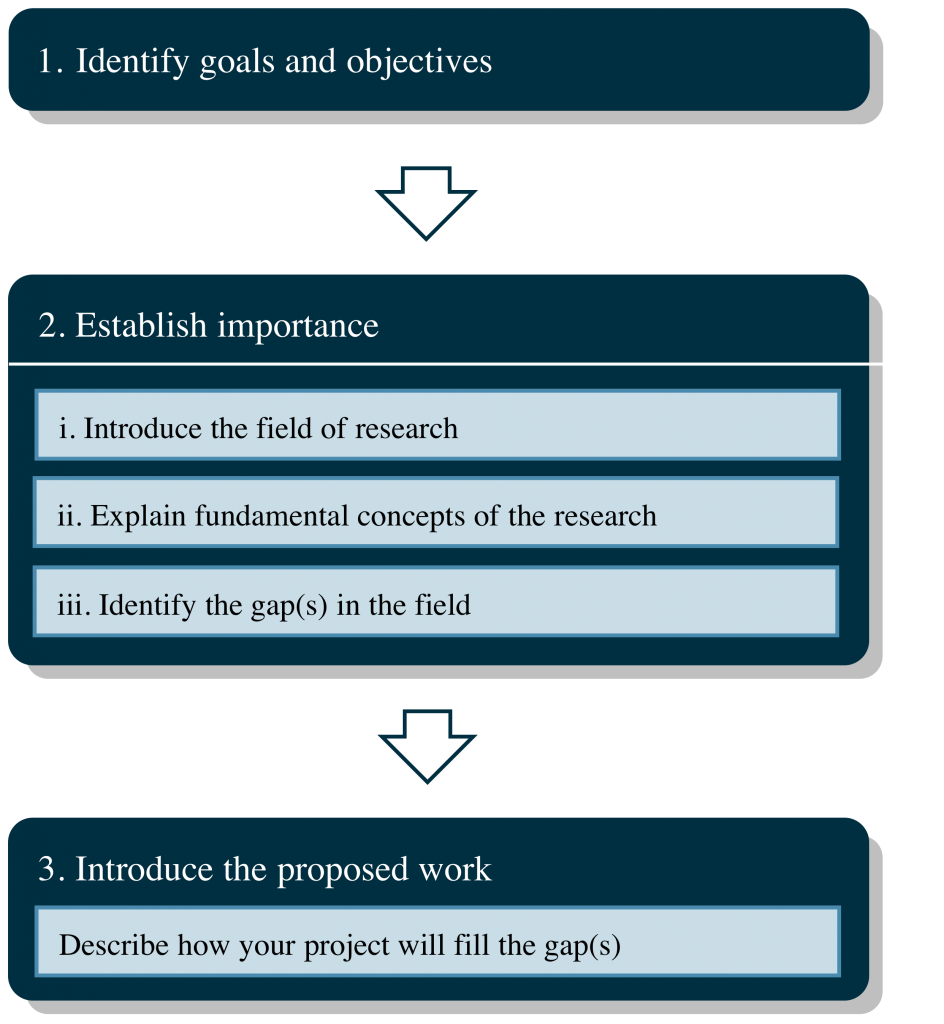
1. Identify goals and objectives. Although this section might have a narrower focus than Moves 2 and 3, it is usually important that it come first so that a funding agency can quickly determine whether or not the project will contribute to the agency’s own goals and therefore merits further review. The g oals of your study are usually broad, long-term ends toward which your project is directed but will not achieve on its own; objectives are more specific and should be directly measurable in your research. Move 1 should establish both of these aspects of your study.
2. Establish importance. Proving to your audience that your project is important is crucial to obtaining funding. Each submove contributes to establishing the importance of the research you are proposing. First, you should introduce the general topic of your project in a way that hints at its importance. For example:
Although premature birth is the leading cause of neonatal death, its contributing factors are poorly understood.
In submove (ii), the scientific literature should be used to provide background information and important details about the topic. Who else has interest in this area of research? What have they discovered that is of great importance? Who benefits or will benefit from the research? What have others stated a need for? This should set you up to identify the gap in the literature (which you intend to fill with the results your project).
3. Introduce the proposed work. Once you have established that there is a great need for a greater understanding of some kind in the general scientific topic you identified in Move 2, you can present your project, which will save the day! If Move 2 identified a challenge, explain how your project faces the challenge. If it identified a problem, your project will solve the problem. This solidifies the importance of your project while identifying what it will actually do. Move 3 is not often given a separate heading of the kind in Moves 1 and 2, but instead flows more smoothly from Move 2 in a new paragraph.
Experimental Approach
This section is the most technical of the three in the Project Description and therefore must proceed in a logical manner that is easy to follow. By starting with what you’ve already accomplished in relation to the proposed project and showing that it is already yielding favorable results, you contextualize and strengthen the reader’s confidence in your proposed methodology.
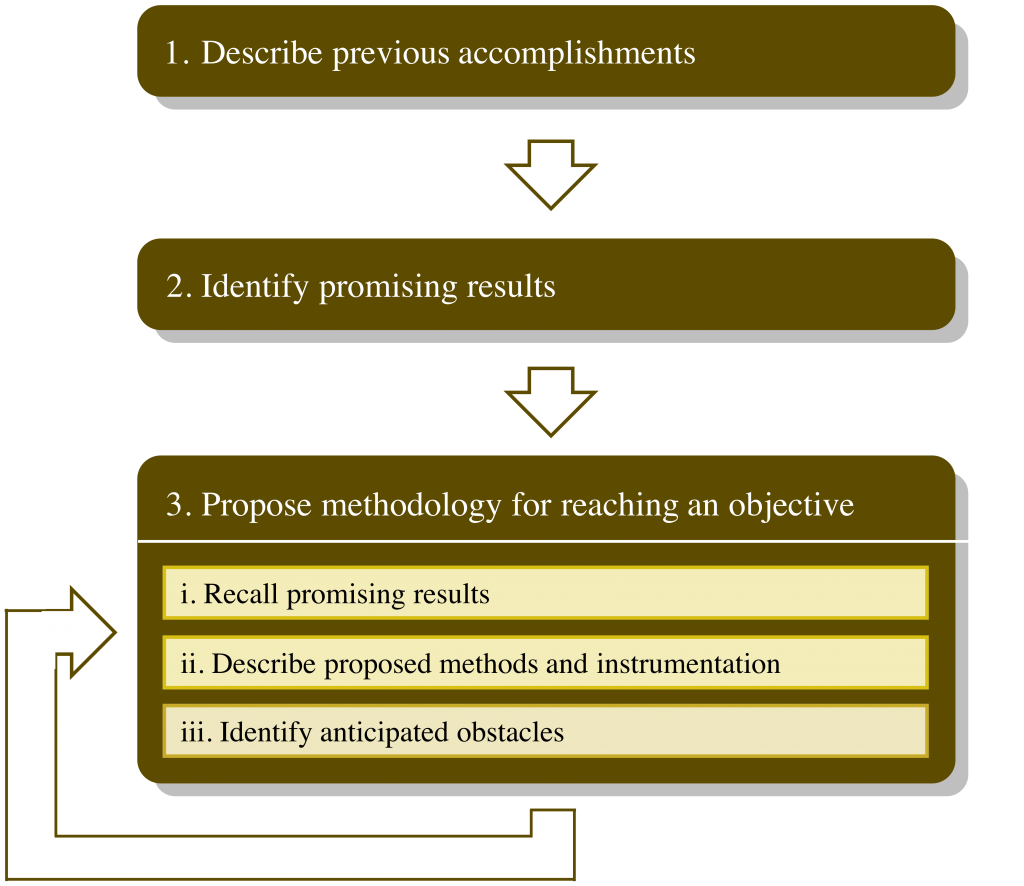
1. Describe previous accomplishments. If you have done any previous research that worked towards the same or a similar goal, this is your opportunity to share its accomplishments. Doing so will build readers’ confidence in your research abilities and current project plan.
2. Identify promising results. Most funding agencies will hope that you have some empirical reason to believe that your proposed project will work, meaning that you have conducted preliminary research that has indicated that your objectives are reasonable and achievable. In this move, you should share these results (if you have them).
3. Propose methodology for reaching an objective. This move should be distinctly made for each objective that you presented in your Goals and Importance section in the same order as you presented them. It is customary to first present simpler, more straight-forward experiments first and progress to those of higher risk or, alternatively, to group methodologies by the types of information that will be gathered, such as synthesis yields versus biproduct identifications. Start by transitioning from your preliminary work to your proposed work in submove (i) before getting into the exact methodology.
It is helpful to use a separate sub-heading for each iteration of Move 3, as well, so that each objective’s methodology is clearly distinguished from the next. These headings can be generic, such as “Objective 1,” or descriptive, such as “TENR Library Construction.”
Unlike in a journal article methods section, only provide enough detail in this section to convince your audience that you can do the work. Focus on the general approach and avoid details (e.g. instrument model numbers or reagent purities) that will take up space and distract your reader from the overall importance of your project.
In submove (iii), address potential limitations or setbacks you can foresee in your plan. You are bound to have some in any research, and acknowledging them shows that you have thought carefully about your proposed research.
Outcomes and Impacts The first two moves of this section essentially summarize what you have already presented in a new format. The end of the proposal then broadens in scope to focus on the wider impacts of the research, beyond its addressing of your individual objectives to the more general goals of the scientific area.
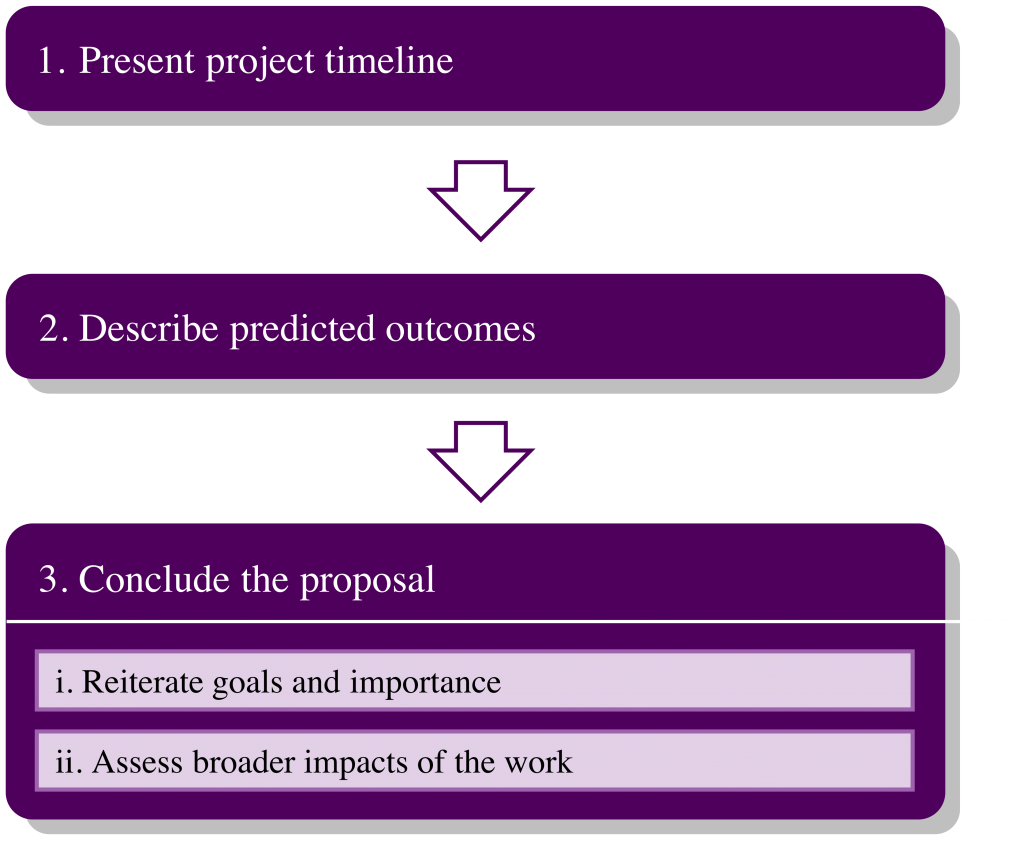
1. Present project timeline. This move allows you to summarize your experimental section in away that makes your anticipated accomplishments tangible. The timeline is presented in paragraph form but reads very list-like, with phrases like “In the spring of 2016, we will complete the Si experiments.” The timeline can be fairly general but must be realistic.
2. Describe predicted outcomes. List measurable achievements that link back to your objectives in section 1. Be as specific as possible so that readers are left with the feeling that your project will result in tangible outcomes.
3. Conclude the proposal. Because they are key components of the proposal, Move 3 begins by summarizing once again the goals and significance of the proposal. This can usually be accomplished in roughly 3 sentences and comprises its own paragraph. Make your closing remarks in submove (ii), where you tell your funding agency how your project will benefit the greater scientific community and/or general public. The broader the impact of your project and the more people it benefits, the more likely it is to be funded.
Library Research Navigator: Destination 3: Proposal Writing
- Getting Started
- Useful Library Resources
- Destination 1: Pre-Proposal Stage: Idea Development
- Destination 2: Funding
- Destination 3: Proposal Writing
- Destination 4: Registration
- Destination 5: Doing Research
- Destination 6: Publishing Your Research
- Destination 7: Increase Visibilty and Track the Impact of Your Research
- Open Access This link opens in a new window
- Finding Previous Studies or Data for Research
- Writing Your Thesis/Dissertation
- You and your Supervisor
- Contact Your Librarian
- Postgraduate Connect Blog
- Postgraduate Training Calendar
- Mendeley This link opens in a new window
- Postgraduate Welcome Days 2024
Preparing a Research Proposal

What is a research proposal?
- A document that outlines how you propose to undertake your research project
- Outlines your thinking about your research problem
- Clearly state your research question and the sub-questions that will be used to answer the research question
- What you wish to study and how it should be done
Library Resources for your Literature Review

Please click here for the resources you will need to use for your literature review include:
Elements of a Research Proposal

1. Cover or Title Page
The title is a simple summary and concise statement of the main concept/s investigated, and the proposed relationship between them. It should be self-explanatory and in title case ( all major words are capitalized, while minor words are lowercased )
2. Introduction
The purpose of the introduction is five-fold:
- the Problem is introduced, which should attract and retain the attention and interest of the reader
- the Background or Setting of the problem is provided, which will sketch the context and dynamics of the problem
- the Research Area / Topic is demarcated by identifying a target group and highlighting the impact of the problem on them
- a Motivation for the study is offered by discussing the deficiencies in the literature regarding the problem
- a General statement of the purpose of the research is stated that could lead to general and specific research questions
- Lastly, the expected value of the research contribution is described
3. Hypotheses or Research Questions
- If you state a hypothesis indicate whether it is a statistical or a non-statistical hypothesis
- If statistical, indicate at what level of statistical significance it will be accepted or rejected
- Depending on the nature of your discipline, it may not be necessary to base your research on a hypothesis but rather to explore, investigate or analyze a particular context or situation
4. Objectives of the Research
- Clarify the aims and objectives of the research
- Objectives should be divided into main and subsidiary objectives and should be numbered
- When writing the proposal, remain focused on the objectives
5. Literature Review
- Provide evidence to the Faculty Research Committee that you are well acquainted with past and current research in the field of study
- Prove that the thesis/dissertation will not duplicate past or current research (at Ph.D. level)
- Indicate how the intended research relates to similar and past research; the literature review positions your research with the existing body of knowledge
- Interlocking findings and unanswered questions
- Your preliminary work on the topic
- The remaining questions and inter-locking logic
6. Theoretical Framework
A theoretical framework consists of concepts and, together with their definitions and reference to relevant scholarly literature, existing theory that is used for your particular study. The theoretical framework must demonstrate an understanding of theories and concepts that are relevant to the topic of your research paper and that relate to the broader areas of knowledge being considered.
- An explicit statement of theoretical assumptions permits the reader to evaluate them critically.
- The theoretical framework connects the researcher to existing knowledge. Guided by a relevant theory, you are given a basis for your hypotheses and choice of research methods.
- Articulating the theoretical assumptions of a research study forces you to address questions of why and how. It permits you to intellectually transition from simply describing a phenomenon you have observed to generalizing about various aspects of that phenomenon.
- Having a theory helps you identify the limits to those generalizations. A theoretical framework specifies which key variables influence a phenomenon of interest and highlights the need to examine how those key variables might differ and under what circumstances.
- This section is written in the future tense for the proposal and re-written in the past tense for the thesis or dissertation.
- Explain how the study will be conducted, with emphasis on the following: a) participants, b) instruments to be used for data collection, c) process through which data will be collected, d) how data will be analyzed e) ethical considerations, f) timeline.
7. Expected Results
- This section should give a good indication of what you expect to get out of the research
- Please note: In the Social Sciences and Humanities this can often not be stated and therefore expected results are not needed in a propos al
- Should join the data analysis and possible outcomes to the theory and questions that you have raised
- Should be a good place to summarize the significance of the work
8. References
- This is a list of the literature referred to in your research proposal
- Do not include titles not cited, or that have no relevance to your research problem
- Clearly distinguish between a List of References and a Bibliography
- The latter includes all material consulted, including background reading not necessarily cited
https://ltl.lincoln.ac.nz/research/writing-a-research-proposal/
https://libguides.usc.edu/writingguide/theoreticalframework
Research proposal at a glance

Useful Books
- ISBN: 9783659484711
How to make a good research proposal
Visit the UJ previous research repository too see how others did their research
- << Previous: Destination 2: Funding
- Next: Destination 4: Registration >>
- Last Updated: Apr 3, 2024 1:11 PM
- URL: https://uj.ac.za.libguides.com/researchnavigator
- Affiliate Program

- UNITED STATES
- 台灣 (TAIWAN)
- TÜRKIYE (TURKEY)
- Academic Editing Services
- - Research Paper
- - Journal Manuscript
- - Dissertation
- - College & University Assignments
- Admissions Editing Services
- - Application Essay
- - Personal Statement
- - Recommendation Letter
- - Cover Letter
- - CV/Resume
- Business Editing Services
- - Business Documents
- - Report & Brochure
- - Website & Blog
- Writer Editing Services
- - Script & Screenplay
- Our Editors
- Client Reviews
- Editing & Proofreading Prices
- Wordvice Points
- Partner Discount
- Plagiarism Checker
- APA Citation Generator
- MLA Citation Generator
- Chicago Citation Generator
- Vancouver Citation Generator
- - APA Style
- - MLA Style
- - Chicago Style
- - Vancouver Style
- Writing & Editing Guide
- Academic Resources
- Admissions Resources
Verb Tenses to Use in a Research Paper
Why Using the Correct Verb Tense is Important
When writing an academic paper, writers should follow the accepted grammar and style conventions: not only to abide by the institutional and domain standards, but to communicate clearly to readers what was studied, when it took place, and from what perspective you are discussing your research (and that of others) in your paper. One crucial writing element that you must consider when composing your paper is verb tense . Which tense you use will determine the flow and coherency of your paper.
You might have found yourself thinking along these lines: “Everything in this study has already been completed, so shouldn’t I simply write everything in the simple past tense?”
The answer is no–at least not in a strict sense. The verb tense you use for a given sentence or phrase depends on your position as the author to the material you are discussing. As the author, you look at each element mentioned in your text from a distance in terms of your role: as a participant, critic, or messenger, among others. You must also take into account the chronological reasons for choosing between present and past tenses in a given instance.
Knowing which tense to use requires both knowledge of the exact guidelines set out for you in whichever formatting style you are following ( APA , AMA , etc.), as well as some discretion and savvy in choosing the tense that makes the most sense for a given statement in the paper.
While new authors should certainly familiarize themselves with the specific guidelines of the formatting style they are applying, this article will focus on the most common rules of verb tense applied to research papers in journals and at academic institutions, reflecting basic verb usage rules in academic English and encompassing all formatting styles.
Bear in mind that these grammar and verb-tense issues will largely be corrected by any competent proofreading service or research paper editing service , and thus professional revision of all academic documents is recommended before submission to journals or conferences.
Rules for Present, Past, and Perfect Tense Verbs
First, there are three basic verb tenses used in research papers: present (simple present), simple past , and present perfect . We will talk about how research paper sections determine verb tense in a minute, but first, let’s review when each tense should be used in general throughout the paper.
PRESENT TENSE VERBS
The present tense is used to talk about general facts, discuss current meanings and implications, and suggest future applications .
General facts are constant and do not change throughout time (the ultimate evolution of scientific progress notwithstanding). Always use the present when discussing general scientific facts.
Example: “Insulin and glucagon regulates blood glucose levels.”
Implications are closely related to general facts and thus the same rule is applied.
Example: “An elevated glucose level indicates a lack of glucagon hormones in the pancreas.”
Further research is called for or stressed as important through a phrase in the present tense.
Example: “Further studies about glucagon receptors are needed.”
SIMPLE PAST TENSE VERBS
The simple past is generally used to discuss events that have been c ompleted in the past at some distinct time and/or place . It is most often applied to discrete events such as studies, experiments, or observed phenomena.
Example: “Scientists in Wales discovered a new enzyme in the liver.” Example: “Protocol X was used to analyze the data.”
PRESENT PERFECT TENSE VERBS
The present perfect tense (or simply “perfect tense”) is used in research papers to refer to events or actions that have taken place at some unidentified time in the past or have started but are still ongoing or only recently completed . It often establishes a general background in the Introduction section , adding a backdrop on which you can explain the motivations for and purpose of your study.
Note that it is the least frequently used tense in most research papers and should not be over-employed–focus more on detailed actions by using the simple past.
Example: “Many studies have focused on glucagon as an important regulating hormone.” Example: “Until recently, researchers have analyzed this kind of data using Chi-Square Statistics.” Example: “Efforts have been made to understand more about this process.” (passive)
Appropriate Verb Tenses by Research Paper Section
It bears repeating that the “best” tense to use is the one that is recommended (or demanded) by whichever formatting manual you are using. However, there is a high degree of continuity between the common styles, and the following rules for usage in each section will likely apply to your research paper no matter where it will be published.
Abstract verb tenses
In general, use the simple past for the abstract of your manuscript; for a concise introductory sentence, use the present perfect. To establish a need for your study—–for instance, by explaining the current circumstances of the world or the specific area in which you are working—–you can also use the present tense.
Example of introductory sentence (present perfect): “Recent studies of glucagon and insulin production have led to breakthroughs in medicine.” Example of establishing background/circumstances/purpose (present): “Diabetes accounts for a higher number of deaths in the US than previously calculated.”
For general statements and facts, the paper itself, or analysis of findings, use the present tense.
Example of a statement of fact: “In the US, diabetes is the most common endocrine disease.”
If you are stating a fact or finding from an earlier specified time or place, use the simple past:
Example: “In 2016, diabetes was the most common endocrine disease.” Have a look at our more in-depth instruction to writing an abstract for a research paper or at these do’s and don’ts of abstract writing if you need additional input.
Introduction section verb tenses
Use a mixture of present and past tense in the introduction section .
The present tense is applied when discussing something that is always true; the simple past tense is used for earlier research efforts, either your own or those reported by another group.
Example of earlier research efforts (simple past): “This same research team discovered a similar enzyme in their 2012 study.”
If the time or location of the demonstration is unknown or not important, use the present perfect.
Example: “Prior research has indicated a correlation between X and Y.”
For the concluding statements of your introduction, use the simple past or present perfect.
Example of concluding statement (simple past): “The CalTech glucagon studies were inconclusive.” Example of concluding statement (present perfect): “Prior research in this area has been inconclusive.”
Use the past perfect when you talk about something that happened or was found to be the case in the past, but which has since been revised. Example of revised information (past perfect): “The Dublonsky study had determined that X was Y, but a 2012 study found this to be incorrect.”
Literature review verb tenses
Knowing which tenses to use for a literature review (either as part of a research paper or as a stand-alone article) can be a bit tricky, as your usage depends both on which style manual you are using (APA, AMA, MLA , or others) and on how you are discussing the literature.
The simple past is usually applied when using the researcher’s name as the subject of the sentence and discussing the methods or results of that study itself
Example of describing researcher’s actions: “Pearson (1997) discovered a new enzyme using similar methods.”
Other verbs commonly found in this usage context: investigated, compared, studied, analyzed, investigated, found, confirmed, performed, etc.
When giving your opinion on another researcher’s work or bringing up the results, discussion, and conclusions they make in their work, use the present tense.
Example of discussing another’s work: “Ryuku (2005) concludes that there are no additional enzymes present in the liver, a finding this current study directly refutes.” Other verbs commonly found in this usage context: stresses, advocates, remarks, argues, claims, posits. etc.
Methods section verb tenses
The Methods section fairly clearly delineates between sections written in past and those written in present tense.
Use the simple past tense to talk about what you did. (Note that you will generally find the passive voice used when describing the actions of the researchers. This puts more focus on the actions being completed and less on the agents completing the action. Passive voice has become the general standard for research papers in recent decades, but it is okay to mix passive and active voice in order to make your paper clearer and more readable.)
Example of methods of study: “A glucose molecule was added to the mixture to see how the peptide would respond.” Example of methods of analysis: “The results were analyzed using Bayesian inference.”
Use the present tense to refer to or explain diagrams, figures, tables, and charts.
Example: “Table 5 shows the results of this first isolated test.” Example: “The results of this first isolated test are displayed in Table 5.”
Results section verb tenses
The verb tense rules for the Results section are quite similar to those applied to the Methods section.
Use the past tense to discuss actual results.
Example: “The addition of 0.02 μg of glycogen activated receptor cells.” Example: “Receptor cells were activated by the addition of 0.02 μg of glycogen.”
Use the simple present tense to explain diagrams/figures/tables. Again, sentences may use both the active and passive voice.
Discussion section verb tenses
The Discussion section consists of an analysis of the findings and a kind of translation of the meanings and implications of these findings.
Use the simple past to summarize your own findings.
Example of summarizing own findings: “The experiment yielded a number of results associated with the processing of glucose.”
Use the present tense to interpret and discuss the significance of your findings.
Example: “[This study confirms that] synthetic glucagon is two-thirds as effective at decreasing fatty acid synthesis.”
Conclusions and further work
The conclusion and call for further work to be done are either provided in the last sentence or two of your paper or in a separate (but short) section at the end of the main text (check the target journal’s author instructions to be sure you follow the journal style) and summarize or emphasize the new insights your work offers.
Use the present perfect tense to clarify that your statements still hold true at the time of reading.
Example: “Results from this study have led to a deeper understanding about how different peptides interact in this enzyme.”
Use the present tense to apply findings, state implications, and suggest further research.
Example of wider implications: “This study confirms that endogenous glucagon is even more essential in metabolism than previously thought.”
When discussing further research that is either needed or intended to be carried out, the future or present tense (or subjunctive mood) can also be used, in addition to the present tense passive voice.
Example of call for future research: “Further clinical studies are needed/will be needed/must be carried out/should be carried out to isolate the cause of this reaction.”
Follow these general rules about tenses and your paper will be clearer, more chronologically correct, and generally easier to read—meaning the important implications of your study will be more easily understood. You can always go back and edit verb tenses—the more you practice, and the more papers you read, the easier it will be to identify which tense should be used for which kind of information.

Tenses in writing
Verb tenses.
The present tense is used to express anything that is happening now or occurring in the present moment. The present also communicates actions that are ongoing, constant, or habitual. For example:
Use the past tense to indicate past events, prior conditions, or completed processes. For example:
The future tense indicates actions or events that will happen in the future. For example:
Aspect allows you to be more precise in your selection of verbs. Aspect falls into two categories: continuous and perfect. To indicate the continuous aspect, add a form of the verb "to be" and a present participle to your main verb. The perfect aspect is created with a form of the verb "to have" and a past participle. The following chart shows twelve forms of the verb "to write" that result from combining time with aspect.
( aspect summary )
A participle is a verb form that can be used as an adjective.
Aspect in Detail
The continuous aspect is created with a form of "to be" and a present participle ( about participles ). For example:
The perfect aspect is created with a form of the verb "to have" and a past participle. For example:
The perfect aspect is often the most challenging to understand, so here's a brief overview.
Past Perfect describes a past action completed before another. For example, the next two sentences describe one action followed by another, but each achieves a different rhetorical effect by using different verb forms.
"Wrote" and "reread" sound equally important in the first sentence. In the second, the past perfect form "had written" emphasizes the action "reread."
Present Perfect refers to completed actions which endure to the present or whose effects are still relevant.
Future Perfect refers to an action that will be completed in the future.
One final note: the terms used to describe aspect have changed over time, and different terms are often used to describe the same aspect. It may help to know that the following terms are equivalent:
- "simple present" (or) "present indefinite"
- "past continuous" (or) "past progressive" (or) "past imperfect"
- "past complete" (or) "past perfect"
- "past perfect continuous" (or) "past perfect progressive"
Verb Tenses in Context
Conventions governing the use of tenses in academic writing differ somewhat from ordinary usage. Below we cover the guidelines for verb tenses in a variety of genres.
Academic Writing
- Books, Plays, Poems, Movies, etc.
Historical Contrast
Research proposals, resumes and cover letters, stories/narrative prose.
1. Academic writing generally concerns writing about research. As such, your tense choices can indicate to readers the status of the research you're citing. You have several options for communicating research findings, and each has a different rhetorical effect. For example:
- 1.3 According to McMillan (1996), the most common cause of death was car accidents.
If you choose the present tense, as in Example 1.1, you're implying that the findings of the research are generally accepted, whereas the present perfect tense in 1.2 implies not only general acceptance but also current relevance and, possibly, the continuity of the findings as an authoritative statement on the causes of death. On the other hand, the past tense in Example 1.3 emphasizes the finding at the time the research was conducted, rather than its current acceptance.
However, if you are writing about specific research methods, the process of research and data collection, or what happened during the research process, you will more commonly use the past tense, as you would normally use in conversation. The reason is that, in this instance, you are not emphasizing the findings of the research or its significance, but talking about events that occurred in the past. Here is an example:
- 1.4 During the data collection process, Quirk conducted 27 interviews with students in his class. Prior to the interviews, the students responded to a brief questionnaire.
Books, Poems, Plays, Movies
2. When you are discussing a book, poem, movie, play, or song the convention in disciplines within the humanities is to use the present tense, as in:
- 2.1 In An Introduction to English Grammar (2006), Noam Chomsky discusses several types of syntactic structures.
- 2.2 In Paradise Lost , Milton sets up Satan as a hero who changes the course of history.
3. In cases where it is useful to contrast different ideas that originate from different periods , you can use the past and the present or present perfect tense to do so. The past tense implies that an idea or a theory has lost its currency or validity, while the present tense conveys relevance or the current state of acceptance.
For example, when you want to discuss the fact that a theory or interpretation has been supplanted by new perspectives on the subject:
- 3.1 Stanley Fish (1993) maintained a reader-response stance in his analysis of Milton's L'Allegro and Il Penseroso . However, recent literary critics consider/have considered this stance to be inappropriate for the two poems.
The verb tenses used above emphasize the contrast between the old view (by Stanley Fish), which is indicated by the past tense, and the new view (by "recent literary critics"), which is indicated by the present tense or the present perfect tense. The difference between the present tense and the present perfect (i.e. between consider and have considered ) is that the present perfect suggests that the current view has been held for some time.
4. The future tense is standard in research proposals because they largely focus on plans for the future. However, when writing your research paper, use the past tense to discuss the data collection processes, since the development of ideas or experiments— the process of researching that brings the reader to your ultimate findings—occurred in the past.
5. In a resume, the past tense is used for reporting past experience and responsibilities. However, in a statement of purpose, a personal statement, or a cover letter, the present perfect tense is commonly used to relate past experience to present abilities, e.g., "I have managed fourteen employees."
6. The past tense is commonly used when writing a narrative or a story , as in:
- 6.1 Once upon a time, there was a peaceful kingdom in the heart of a jungle . . .
Some writers use the present tense in telling stories, a technique called the "historical present" that creates an air of vividness and immediacy. For example:
- 6.2 Yesterday when I was walking around downtown, the craziest thing happened. This guy in a suit comes up to me, and says , "If you know what's good for you . . . "
In this example, the speaker switches from the past tense in giving context for the story to the present tense in relating the events themselves.
Back to Grammar in College Writing
Dissertations & projects: Tenses
- Research questions
- The process of reviewing
- Project management
- Literature-based projects
On this page:
“You will use a range of tenses depending on what you are writing about . ” Elizabeth M Fisher, Richard C Thompson, and Daniel Holtom, Enjoy Writing Your Science Thesis Or Dissertation!
Tenses can be tricky to master. Even well respected journals differ in the guidance they give their authors for their use. However, their are some general conventions about what tenses are used in different parts of the report/dissertation. This page gives some advice on standard practice.
What tenses will you use?

There are exceptions however, most notably in the literature review where you will use a mixture of past , present and present perfect tenses (don't worry, that is explained below), when discussing the implications of your findings when the present tense is appropriate and in the recommendations where you are likely to use the future tense.
The tenses used as standard practice in each of these sections of your report are given and explained below.
In your abstract
You have some leeway with tense use in your abstract and guidance does vary which can sometimes be confusing. We recommend the following:
Describing the current situation and reason for your study
Mostly use the present tense, i.e. "This is the current state of affairs and this is why this study is needed."
Occasionally, you may find the need to use something called the present perfect tense when you are describing things that happened in the past but are still relevant. The present perfect tense uses have/has and then the past participle of the verb i.e. Previous research on this topic has focused on...
Describing the aims of your study
Here you have a choice. It is perfectly acceptable to use either the present or past tense, i.e. "This study aims to..." or "This study aimed to..."
Describing your methodology
Use the past tense to describe what you did, i.e. "A qualitative approach was used." "A survey was undertaken to ...". "The blood sample was analysed by..."
Describing your findings
Use the past tense to describe what you found as it is specific to your study, i.e. "The results showed that...", "The analysis indicated that..."
Suggesting the implications of your study
Use the present tense as even though your study took place in the past, your implications remain relevant in the present, i.e. Results revealed x which indicates that..."
Example abstract
An example abstract with reasoning for the tenses chosen can be found at the bottom of this excellent blog post:
Using the Present Tense and Past Tense When Writing an Abstract
In your methodology
The methodology is one of the easiest sections when it comes to tenses as you are explaining to your reader what you did. This is therefore almost exclusively written in the past tense.
Blood specimens were frozen at -80 o C.
A survey was designed using the Jisc Surveys tool.
Participants were purposefully selected.
The following search strategy was used to search the literature:
Very occasionally you may use the present tense if you are justifying a decision you have taken (as the justification is still valid, not just at the time you made the decision). For example:
Purposeful sampling was used to ensure that a range of views were included. This sampling method maximises efficiency and validity as it identifies information-rich cases and ... (Morse & Niehaus, 2009).
In your discussion/conclusion
This will primarily be written in the present tense as you are generally discussing or making conclusions about the relevance of your findings at the present time. So you may write:
The findings of this research suggest that.../are potentially important because.../could open a new avenue for further research...
There will also be times when you use the past tense , especially when referring to part of your own research or previous published research research - but this is usually followed by something in the present tense to indicate the current relevance or the future tense to indicate possible future directions:
Analysis of the survey results found most respondents were not concerned with the processes, just the outcome. This suggests that managers should focus on...
These findings mirrored those of Cheung (2020), who also found that ESL pupils failed to understand some basic yet fundamental instructions. Addressing this will help ensure...
In your introduction
The introduction generally introduces what is in the rest of your document as is therefore describing the present situation and so uses the present tense :
Chapter 3 describes the research methodology.
Depending on your discipline, your introduction may also review the literature so please also see that section below.
In your literature review
The findings of some literature may only be applicable in the specific circumstances that the research was undertaken and so need grounding to that study. Conversely, the findings of other literature may now be accepted as established knowledge. Also, you may consider the findings of older literature to be still relevant and relatively recent literature be already superseded. The tenses you write in will help to indicate a lot of this to the reader. In other words, you will use a mix of tenses in your review depending on what you are implying.
Findings only applicable in the specific circumstances
Use the past tense . For example:
In an early study, Sharkey et al. (1991) found that isoprene emissions were doubled in leaves on sunnier sides of oak and aspen trees.
Using the past tense indicates that you are not implying that isoprene emissions are always doubled on the sunnier side of the trees, just that is what was found in the Sharkey et al. study.
Findings that are still relevant or now established knowledge
Mostly use the present tense , unless the study is not recent and the authors are the subject of the sentence (which you should use very sparingly in a literature review) when you may need to use a mixture of the past and present. For example:
A narrowing of what 'graduateness' represents damages students’ abilities to thrive as they move through what will almost certainly be complex career pathways (Holmes, 2001).
Holmes (2001) argued strongly that a narrowing of what 'graduateness' represents damages students’ abilities to thrive as they move through what will almost certainly be complex career pathways
Both of these imply that you think this is still the case (although it is perhaps more strongly implied in the first example). You may also want to use some academic caution too - such as writing 'may damage' rather than the more definite 'damages'.
Presenting your results
As with your methodology, your results section should be written in the past tense . This indicates that you are accepting that the results are specific to your research. Whilst they may have current implications, that part will not be considered until your discussion/conclusions section(s).
Four main themes were identified from the interview data.
There was a significant change in oxygen levels.
Like with the methodology, you will occasionally switch to present tense to write things like "Table 3.4 shows that ..." but generally, stick to the past tense.
In your recommendations
Not everyone will need to include recommendations and some may have them as part of the conclusions chapter. Recommendations are written in a mixture of the present tense and future tense :
It is recommended that ward layout is adapted, where possible, to provide low-sensory bays for patients with autism. These will still be useable by all patients but...
Useful links
- Verb tenses in scientific manuscripts From International Science Editing
- Which Verb Tenses Should I Use in a Research Paper? Blog from WordVice
- << Previous: Writing style
- Next: Voice >>
- Last Updated: Apr 9, 2024 3:41 PM
- URL: https://libguides.hull.ac.uk/dissertations
- Login to LibApps
- Library websites Privacy Policy
- University of Hull privacy policy & cookies
- Website terms and conditions
- Accessibility
- Report a problem
An official website of the United States government
The .gov means it’s official. Federal government websites often end in .gov or .mil. Before sharing sensitive information, make sure you’re on a federal government site.
The site is secure. The https:// ensures that you are connecting to the official website and that any information you provide is encrypted and transmitted securely.
- Publications
- Account settings
Preview improvements coming to the PMC website in October 2024. Learn More or Try it out now .
- Advanced Search
- Journal List
- Indian J Anaesth
- v.60(9); 2016 Sep
How to write a research proposal?
Department of Anaesthesiology, Bangalore Medical College and Research Institute, Bengaluru, Karnataka, India
Devika Rani Duggappa
Writing the proposal of a research work in the present era is a challenging task due to the constantly evolving trends in the qualitative research design and the need to incorporate medical advances into the methodology. The proposal is a detailed plan or ‘blueprint’ for the intended study, and once it is completed, the research project should flow smoothly. Even today, many of the proposals at post-graduate evaluation committees and application proposals for funding are substandard. A search was conducted with keywords such as research proposal, writing proposal and qualitative using search engines, namely, PubMed and Google Scholar, and an attempt has been made to provide broad guidelines for writing a scientifically appropriate research proposal.
INTRODUCTION
A clean, well-thought-out proposal forms the backbone for the research itself and hence becomes the most important step in the process of conduct of research.[ 1 ] The objective of preparing a research proposal would be to obtain approvals from various committees including ethics committee [details under ‘Research methodology II’ section [ Table 1 ] in this issue of IJA) and to request for grants. However, there are very few universally accepted guidelines for preparation of a good quality research proposal. A search was performed with keywords such as research proposal, funding, qualitative and writing proposals using search engines, namely, PubMed, Google Scholar and Scopus.
Five ‘C’s while writing a literature review

BASIC REQUIREMENTS OF A RESEARCH PROPOSAL
A proposal needs to show how your work fits into what is already known about the topic and what new paradigm will it add to the literature, while specifying the question that the research will answer, establishing its significance, and the implications of the answer.[ 2 ] The proposal must be capable of convincing the evaluation committee about the credibility, achievability, practicality and reproducibility (repeatability) of the research design.[ 3 ] Four categories of audience with different expectations may be present in the evaluation committees, namely academic colleagues, policy-makers, practitioners and lay audiences who evaluate the research proposal. Tips for preparation of a good research proposal include; ‘be practical, be persuasive, make broader links, aim for crystal clarity and plan before you write’. A researcher must be balanced, with a realistic understanding of what can be achieved. Being persuasive implies that researcher must be able to convince other researchers, research funding agencies, educational institutions and supervisors that the research is worth getting approval. The aim of the researcher should be clearly stated in simple language that describes the research in a way that non-specialists can comprehend, without use of jargons. The proposal must not only demonstrate that it is based on an intelligent understanding of the existing literature but also show that the writer has thought about the time needed to conduct each stage of the research.[ 4 , 5 ]
CONTENTS OF A RESEARCH PROPOSAL
The contents or formats of a research proposal vary depending on the requirements of evaluation committee and are generally provided by the evaluation committee or the institution.
In general, a cover page should contain the (i) title of the proposal, (ii) name and affiliation of the researcher (principal investigator) and co-investigators, (iii) institutional affiliation (degree of the investigator and the name of institution where the study will be performed), details of contact such as phone numbers, E-mail id's and lines for signatures of investigators.
The main contents of the proposal may be presented under the following headings: (i) introduction, (ii) review of literature, (iii) aims and objectives, (iv) research design and methods, (v) ethical considerations, (vi) budget, (vii) appendices and (viii) citations.[ 4 ]
Introduction
It is also sometimes termed as ‘need for study’ or ‘abstract’. Introduction is an initial pitch of an idea; it sets the scene and puts the research in context.[ 6 ] The introduction should be designed to create interest in the reader about the topic and proposal. It should convey to the reader, what you want to do, what necessitates the study and your passion for the topic.[ 7 ] Some questions that can be used to assess the significance of the study are: (i) Who has an interest in the domain of inquiry? (ii) What do we already know about the topic? (iii) What has not been answered adequately in previous research and practice? (iv) How will this research add to knowledge, practice and policy in this area? Some of the evaluation committees, expect the last two questions, elaborated under a separate heading of ‘background and significance’.[ 8 ] Introduction should also contain the hypothesis behind the research design. If hypothesis cannot be constructed, the line of inquiry to be used in the research must be indicated.

Review of literature
It refers to all sources of scientific evidence pertaining to the topic in interest. In the present era of digitalisation and easy accessibility, there is an enormous amount of relevant data available, making it a challenge for the researcher to include all of it in his/her review.[ 9 ] It is crucial to structure this section intelligently so that the reader can grasp the argument related to your study in relation to that of other researchers, while still demonstrating to your readers that your work is original and innovative. It is preferable to summarise each article in a paragraph, highlighting the details pertinent to the topic of interest. The progression of review can move from the more general to the more focused studies, or a historical progression can be used to develop the story, without making it exhaustive.[ 1 ] Literature should include supporting data, disagreements and controversies. Five ‘C's may be kept in mind while writing a literature review[ 10 ] [ Table 1 ].
Aims and objectives
The research purpose (or goal or aim) gives a broad indication of what the researcher wishes to achieve in the research. The hypothesis to be tested can be the aim of the study. The objectives related to parameters or tools used to achieve the aim are generally categorised as primary and secondary objectives.
Research design and method
The objective here is to convince the reader that the overall research design and methods of analysis will correctly address the research problem and to impress upon the reader that the methodology/sources chosen are appropriate for the specific topic. It should be unmistakably tied to the specific aims of your study.
In this section, the methods and sources used to conduct the research must be discussed, including specific references to sites, databases, key texts or authors that will be indispensable to the project. There should be specific mention about the methodological approaches to be undertaken to gather information, about the techniques to be used to analyse it and about the tests of external validity to which researcher is committed.[ 10 , 11 ]
The components of this section include the following:[ 4 ]
Population and sample
Population refers to all the elements (individuals, objects or substances) that meet certain criteria for inclusion in a given universe,[ 12 ] and sample refers to subset of population which meets the inclusion criteria for enrolment into the study. The inclusion and exclusion criteria should be clearly defined. The details pertaining to sample size are discussed in the article “Sample size calculation: Basic priniciples” published in this issue of IJA.
Data collection
The researcher is expected to give a detailed account of the methodology adopted for collection of data, which include the time frame required for the research. The methodology should be tested for its validity and ensure that, in pursuit of achieving the results, the participant's life is not jeopardised. The author should anticipate and acknowledge any potential barrier and pitfall in carrying out the research design and explain plans to address them, thereby avoiding lacunae due to incomplete data collection. If the researcher is planning to acquire data through interviews or questionnaires, copy of the questions used for the same should be attached as an annexure with the proposal.
Rigor (soundness of the research)
This addresses the strength of the research with respect to its neutrality, consistency and applicability. Rigor must be reflected throughout the proposal.
It refers to the robustness of a research method against bias. The author should convey the measures taken to avoid bias, viz. blinding and randomisation, in an elaborate way, thus ensuring that the result obtained from the adopted method is purely as chance and not influenced by other confounding variables.
Consistency
Consistency considers whether the findings will be consistent if the inquiry was replicated with the same participants and in a similar context. This can be achieved by adopting standard and universally accepted methods and scales.
Applicability
Applicability refers to the degree to which the findings can be applied to different contexts and groups.[ 13 ]
Data analysis
This section deals with the reduction and reconstruction of data and its analysis including sample size calculation. The researcher is expected to explain the steps adopted for coding and sorting the data obtained. Various tests to be used to analyse the data for its robustness, significance should be clearly stated. Author should also mention the names of statistician and suitable software which will be used in due course of data analysis and their contribution to data analysis and sample calculation.[ 9 ]
Ethical considerations
Medical research introduces special moral and ethical problems that are not usually encountered by other researchers during data collection, and hence, the researcher should take special care in ensuring that ethical standards are met. Ethical considerations refer to the protection of the participants' rights (right to self-determination, right to privacy, right to autonomy and confidentiality, right to fair treatment and right to protection from discomfort and harm), obtaining informed consent and the institutional review process (ethical approval). The researcher needs to provide adequate information on each of these aspects.
Informed consent needs to be obtained from the participants (details discussed in further chapters), as well as the research site and the relevant authorities.
When the researcher prepares a research budget, he/she should predict and cost all aspects of the research and then add an additional allowance for unpredictable disasters, delays and rising costs. All items in the budget should be justified.
Appendices are documents that support the proposal and application. The appendices will be specific for each proposal but documents that are usually required include informed consent form, supporting documents, questionnaires, measurement tools and patient information of the study in layman's language.
As with any scholarly research paper, you must cite the sources you used in composing your proposal. Although the words ‘references and bibliography’ are different, they are used interchangeably. It refers to all references cited in the research proposal.
Successful, qualitative research proposals should communicate the researcher's knowledge of the field and method and convey the emergent nature of the qualitative design. The proposal should follow a discernible logic from the introduction to presentation of the appendices.
Financial support and sponsorship
Conflicts of interest.
There are no conflicts of interest.

Capstone Form and Style
Capstone multilingual writing tips: blog, january 2021: what verb tenses do you need to master for academic writing.
Grammar books often show 12 to 16 different verb tenses in English. For an overview of these tenses, see the verb tense webpage . However, not all of these verb tenses are needed to be a successful writer in U.S. academic English. Hinkel (n.d.) claimed that language learners need to learn only 10 of these verb tenses. For more instruction on verb tense and usage, her visual interactive slide show breaks down the tenses and their meanings clearly.
Other researchers have found that even fewer verb tenses need to be mastered to be successful writer. Biber et al. (1999) asserted that academic writers can choose from the simple present, the simple past, and the present perfect for more than 98% of the verbs that require tense (pp. 456-461). Similarly, Caplan (2012) stated that only three tenses are used for the majority of verb phrases in academic writing. Specifically, the simple present is used 70% of the time, the simple past is used around 23% of the time, and the present perfect is used about 5% of the time (Caplan, 2012, p. 66).
What does that mean for you? Well, it means that you really only have to focus on mastering a few English verb tenses for academic writing and for completion of your capstone study! In addition to the simple present ( I write ), simple past ( I wrote ), and present perfect ( I have written ), remember that the proposal of your capstone document will be written in the future (I will write). Choosing the correct verb tense potentially becomes complicated when writing in APA and writing to follow Walden-specific guidelines. Keep these ideas in mind:
- Once I receive IRB approval, I will conduct semistructured face-to-face interviews.
- Table 1 shows the demographic information of the participants.
- In this chapter, I describe the results.
- In summary, in this section, I presented the assumptions, limitations, and delimitations.
- Taylor (2018) asserted that the Every Student Succeeds Act is an improvement over No Child Left Behind.
- Test scores improved significantly from pretest to posttest.
- Researchers have illustrated that meaning is the most important aspect of human motivation.
- I followed the guidelines for research with human subjects.
For more information and resources on verb tenses, see these links:
- Most Common Verb Tenses in Academic Writing
- APA Style Guidelines on Verb Tense
- Verb Tense Guidelines When Referring to the Document Itself
- Simple Past Versus the Present Perfect
- Verb Tense Considerations: Proposal to Final Study
Happy Writing!
Biber, D., Johansson, S., Leech, G., Conrad, S., & Finegan, E. (1999). Longman grammar of written and spoken English . Pearson. https://doi.org/10.1162/089120101300346831
Caplan, N. A. (2012). Grammar choices for graduate and professional writers . University of Michigan Press.
Hinkel, E. (n.d.). Teaching tenses to ESL students . http://www.elihinkel.org/tips/tenses.htm
0 Comments.
search this blog, recent posts, subscribe, archive, this post is closed for further discussion..
- << Previous: Back to Main Page
- Office of Student Disability Services
Walden Resources
Departments.
- Academic Residencies
- Academic Skills
- Career Planning and Development
- Customer Care Team
- Field Experience
- Military Services
- Student Success Advising
- Writing Skills
Centers and Offices
- Center for Social Change
- Office of Academic Support and Instructional Services
- Office of Degree Acceleration
- Office of Research and Doctoral Services
- Office of Student Affairs
Student Resources
- Doctoral Writing Assessment
- Form & Style Review
- Quick Answers
- ScholarWorks
- SKIL Courses and Workshops
- Walden Bookstore
- Walden Catalog & Student Handbook
- Student Safety/Title IX
- Legal & Consumer Information
- Website Terms and Conditions
- Cookie Policy
- Accreditation
- State Authorization
- Net Price Calculator
- Contact Walden
Walden University is a member of Adtalem Global Education, Inc. www.adtalem.com Walden University is certified to operate by SCHEV © 2024 Walden University LLC. All rights reserved.
Present Past Future
Present Tense (Used in Proposal Rational Section) Discussion of prior research
Description of prior research
Future Tense (Used in Proposal Contents of Project Report Section )
Last update: November 24, 2008

How to write a Research Proposal for Scholarship Applications in 2024
Liberty Okechukwu
April 10, 2024
Research Proposal for Scholarship Applications
If you want to apply for a scholarship, you might be required to submit a thorough research proposal with your application. You will thus be able to learn about research proposals in this post and how to write one for your upcoming scholarship application in 2024.
In this article, I will show you the definition and significance of a research proposal, methods for emphasizing the originality of the research idea, the right length for various scholarships, an explanation of its components, advice on choosing a title, composing an abstract, and conclusion, and a list of helpful software tools. These are just a few of the important topics covered in this article. Students pursuing scholarships will find this guide to be quite helpful, as it provides them with comprehensive analysis and useful advice on how to improve their research ideas and raise their chances of acceptance.
Get Up to $100,000 Student Loan for Your Master in US or Canada - See if you are eligible

What is a Research Proposal?
A research proposal is a document that provides a research project’s outline. It is used to request funds or a scholarship and to propose a research endeavor. A thorough explanation of the planned study’s significance, methods, and anticipated results should be included in the proposal.
The approach of the Research Proposal
For your research proposal to be unique, you must present a novel idea or approach. This involves:
- Identifying gaps in existing research.
- Proposing innovative methodologies or perspectives.
- Demonstrating how your research can contribute to the field.
What is the ideal length of your research p roposal for scholarship applications?
The length of depends on the kind of scholarship you are applying for. For example:
- Rhodes Scholarship: Up to 1,000 words.
- China CSC Scholarship: Up to 1200 words.
- Fulbright Scholarship: Typically 3-5 pages.
- NSF Graduate Research Fellowship: Around 2-3 pages.
Note that it is important that you follow the guidelines provided by the scholarship body you are applying for.
What are the Elements of a Research Proposal ?
- Title: Brief and descriptive.
- Abstract: A summary of your work.
- Introduction: Background and significance of the study.
- Literature Review: Analysis of existing research.
- Research Questions/Hypotheses: Clear and focused questions or hypotheses.
- Methodology: A detailed description of research methods.
- Ethical Considerations: Address any ethical issues.
- Timeline: A projected schedule for the research.
- Budget: An estimated cost and justification.
- Expected Outcomes: Anticipated results and impact.
- Dissemination Plan: How you will share your findings.
- References: Citing sources used in your proposal.
- Appendices: Any supplementary material.
Read These:
- How to Write a Study Plan for Your Canadian Student Visa
- How to Write a Convincing Study Gap Statement
- How to write an effective scholarship Essay 2024 – With Examples
- How to Write a Winning Statement of Purpose (with samples) ?
How to add citations ?
Citations are essential for acknowledging the sources of your research proposal. Your references can be organized and formatted using programs like Mendeley, EndNote, and Zotero. Consequently, I advise you to familiarize yourself with these programs.
How to select the title?
Your research proposal’s title should sum up your findings clearly and succinctly. It should pique the reader’s curiosity and make the project’s main points apparent.
How to write the abstract and highlights of your Research Proposal?
- Abstract: This is a 150-250 word summary that includes your research question, methodology, and potential impact.
- Highlights: This is a 3-5 bullet point that summarizes the key aspects or innovative elements of your proposal.
How to write the conclusion?
A research proposal should conclude with a summary of the significance of the work, its potential contributions to the field, and the reasons it should be awarded a grant, scholarship, fellowship, or other financial support.
The Best Software for Writing a Research Proposal in 2024
According to Daadscholarship , if you decide to begin writing your research proposal right away, be sure you are proficient with any of the following software programs:
- Reference Management: Zotero, Mendeley, EndNote.
- Writing and Formatting: Microsoft Word, LaTeX.
- Data analysis (if applicable): SPSS, R, Python.
- Project Management: Trello, Asana.
Overall, having a strong research proposal is essential to getting funding or scholarships for your education. It calls for a solid methodology, a clear grasp of your research objectives, a comprehensive literature evaluation, and the capacity to convey your thoughts. You can improve your chances of writing a proposal that sticks out in the crowded field of academic scholarships by adhering to these principles.
subscribe to our newsletter
Most recent.
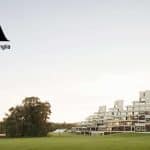
2024 Ariadne Nicolaeff Scholarship to study at the University of East Anglia

Apply for the Barcelona GSE Scholarships 2024 to Study in Spain

Bocconi University Scholarships 2024 for International Students in Italy

Apply for the POSTECH Scholarship to Study in South Korea

Germany: DAAD Leadership for Africa Scholarship Programme 2024/2025 for West and Central African Masters Students (Fully-funded)
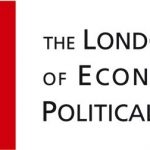
London School of Economics and Political Science (LSE) Masters Scholarships 2024/2025 for Students in sub-Sahara Africa
© 2024 AFTER SCHOOL AFRICA
Explore Opportunities
Your email will NEVER be used for any other purpose.
You can see how this popup was set up in our step-by-step guide: https://wppopupmaker.com/guides/auto-opening-announcement-popups/
Download Chapter One of The Scholarship Digest 2019!
We interviewed Multi-Scholarship Award winners and put everything we learned into this book.

- Plus More than 1,400 carefully selected opportunities for Africans
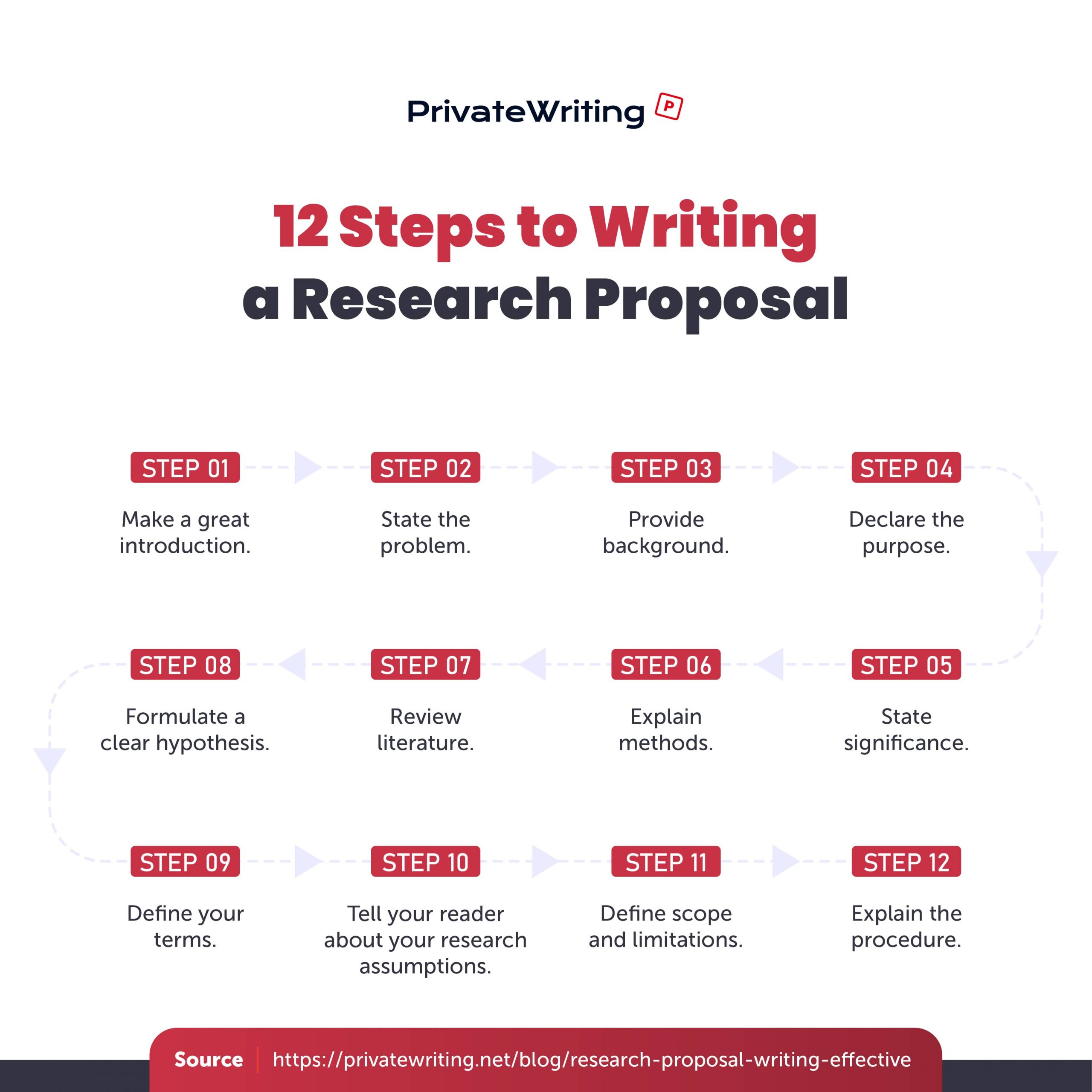
The different tenses are identified by their associated verb forms. There are three main verb tenses: past , present , and future. In English, each of these tenses can take four main aspects: simple , perfect , continuous (also known as progressive ), and perfect continuous. The perfect aspect is formed using the verb to have, while the ...
additional chapters that report research findings (Chapter 4) and conclusions, discussion, and recommendations (Chapter 5). While the majority of the research proposal is written in the present and future tenses, the methodology and findings in the final report or dissertation are written mostly in the past tense.
When citing previous research, use past tense. Whatever a previous researcher said, did or wrote happened in the past. Results relevant only in the past, or to a particular study and not yet generally accepted should also be expressed in past tense: "Smith (2008) reported that adult respondents remembered 30 percent more than children.
The introduction is written in the present tense. The literature review is written in the past tense. The methodology is written in the future tense. Cohesive ties. Cohesive ties are linguistic devices that link words, phrases and clauses into fluent sentences and paragraphs. These are important in a research proposal as they help you signpost ...
Past Simple Tense The second most commonly used tense in academic writing is the past simple tense. This tense has two main functions in most academic fields. First, it introduces existing research or academic studies. Second, it describes the methods, data, and findings of a completed experiment or research study.
Key Takeaways. Developing a research proposal involves the following preliminary steps: identifying potential ideas, choosing ideas to explore further, choosing and narrowing a topic, formulating a research question, and developing a working thesis. A good topic for a research paper interests the writer and fulfills the requirements of the ...
Voice and Tenses Unlike the journal articles that you've written until now, which are mostly written in the past tense, Research Proposals are partially in the present tense and part in the future tense. All of the introductory material (components 1 and 2) are written in the present tense, as they discuss the current state of the scienti c art.
According to corpus research, in academic writing, the three tenses used the most often are the simple present, the simple past, and the present perfect (Biber et al., 1999; Caplan, 2012). The next most common tense for capstone writers is the future; the doctoral study/dissertation proposal at Walden is written in this tense for a study that ...
If you are writing a research proposal, the tense you use will help distinguish between your proposed study and the research literature you draw upon. The APA Manual advises that "the past tense is appropriate when expressing an action or a condition that occurred at a specific, definite time in the past, such as when discussing another ...
Use the simple present tense in your research papers when referring to results presented in tables and figures in your writing. For example, "Fig.3 shows that…". The present tense an also be used to talk about the research paper as a whole, for example, "Section 4.1 discusses…". This tense in scientific writing is also used to state ...
3. Impact. Even if your research is creative and explores a novel subject, if its scope is too narrow, it will be hard to convince people to fund it. At the very least your research should be able to impact other scientists; ideally, it will impact a particular community or even all of society.
By writing your thoughts down, you will get a clearer idea about what you want to do. Pay attention to the elements that should be included in the proposal. In your second draft, you write for the text for your reader. You have to keep in mind the person who is going to read it and what effect you want it to have on the reader.
This section is written in the future tense for the proposal and re-written in the past tense for the thesis or dissertation. Explain how the study will be conducted, with emphasis on the following: a) participants, b) instruments to be used for data collection, c) process through which data will be collected, d) how data will be analyzed e ...
Rules for Present, Past, and Perfect Tense Verbs. First, there are three basic verb tenses used in research papers: present (simple present), simple past, and present perfect. We will talk about how research paper sections determine verb tense in a minute, but first, let's review when each tense should be used in general throughout the paper.
Research Proposals 4. The future tense is standard in research proposals because they largely focus on plans for the future. However, when writing your research paper, use the past tense to discuss the data collection processes, since the development of ideas or experiments— the process of researching that brings the reader to your ultimate ...
The methodology is one of the easiest sections when it comes to tenses as you are explaining to your reader what you did. This is therefore almost exclusively written in the past tense. Blood specimens were frozen at -80 o C. A survey was designed using the Jisc Surveys tool. Participants were purposefully selected.
Writing the proposal of a research work in the present era is a challenging task due to the constantly evolving trends in the qualitative research design and the need to incorporate medical advances into the methodology. The proposal is a detailed plan or 'blueprint' for the intended study, and once it is completed, the research project ...
What tenses should be used in the research paper and thesis? The most concern part is the literature review. Chapter 1 is the introduction, so combination of present and past tense should be used.
Choosing the correct verb tense potentially becomes complicated when writing in APA and writing to follow Walden-specific guidelines. Keep these ideas in mind: Use the future in the proposal to explain the research you will conduct: Once I receive IRB approval, I will conduct semistructured face-to-face interviews.
Tenses: Proposal Examples. Present Tense (Used in Proposal Rational Section) Discussion of prior research. Hispanic students tend to be overrepresented in the "judgmental" categories of special education such as learning disabilities, emotional disturbance and mental retardation. These categories are usually diagnosed by school personnel who ...
Writing a Research Need Statement or a Research Proposal - Back to the Basics' invites student researchers to rediscover the foundational principles of effective proposal writing. This presentation delineates the essential distinctions and synergies between the Statement of Needs and the Research Proposal, guiding attendees through the core ...
According to Daadscholarship, if you decide to begin writing your research proposal right away, be sure you are proficient with any of the following software programs: Reference Management: Zotero, Mendeley, EndNote. Writing and Formatting: Microsoft Word, LaTeX. Data analysis (if applicable): SPSS, R, Python. Project Management: Trello, Asana.
cal yacht club rowing
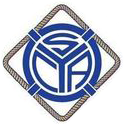
California Yacht Club (CYC)
by evandiaz | May 19, 2023 | Yacht Club Members
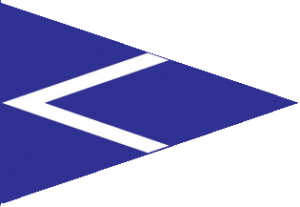
California Yacht Club (CYC) calyachtclub.com 4469 Admiralty Way Marina del Rey, CA 90292 (310) 823-4567 Fax:(310) 822-3658
Total: 950 members – 33% power, 63% sail, 4% rowers.
Facilities: Bar open Wed. thru Sun 1000 to 2400. Dining room open Wed.- Sun for lunch and dinner (breakfast on Sat. & brunch on Sun.) Snack bar open every day from Memorial Day to Labor Day 1000 to 1630. Heated Pool and Paddle Tennis Courts available to members and their guests. 320 member slips (25’ to 120’), 100+ dry storage slips (up to 25’), two 2-ton hoists and launch ramp. Guest docks are first come, first served, but call for reservations. First night free for reciprocal club members. CYC monitors channel 68.
Junior program: Year round. Junior Sailing and Rowing Program. Open to all youths in the community (ages 8-18). Full time Junior staff.
Comments: Active power, sail and rowing fleets. Family friendly Club with a full schedule of races, cruises, and social activities.
Recent Posts
- CHANGE OF COMMAND
- CHANGE OF COMMAND AWARD
- SCYA Announces the 2024 Club of the Year Criteria
- Opening Day Calendar Posted
- King Harbor Yacht Club (KHYC)
Recent Comments
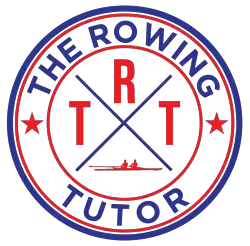
The 10 Best Rowing Clubs in Los Angeles
Los Angeles is a city with a rich history in rowing. Rowing clubs have been around in Los Angeles since the late 1800s, and many of them are still going strong today. In this blog post, we will take a look at the top 10 rowing clubs in Los Angeles and what makes them so successful. We will also discuss the different types of rowing that these clubs offer and how you can get involved. So if you’re looking for a place to row in Los Angeles , be sure to check out one of these great clubs!
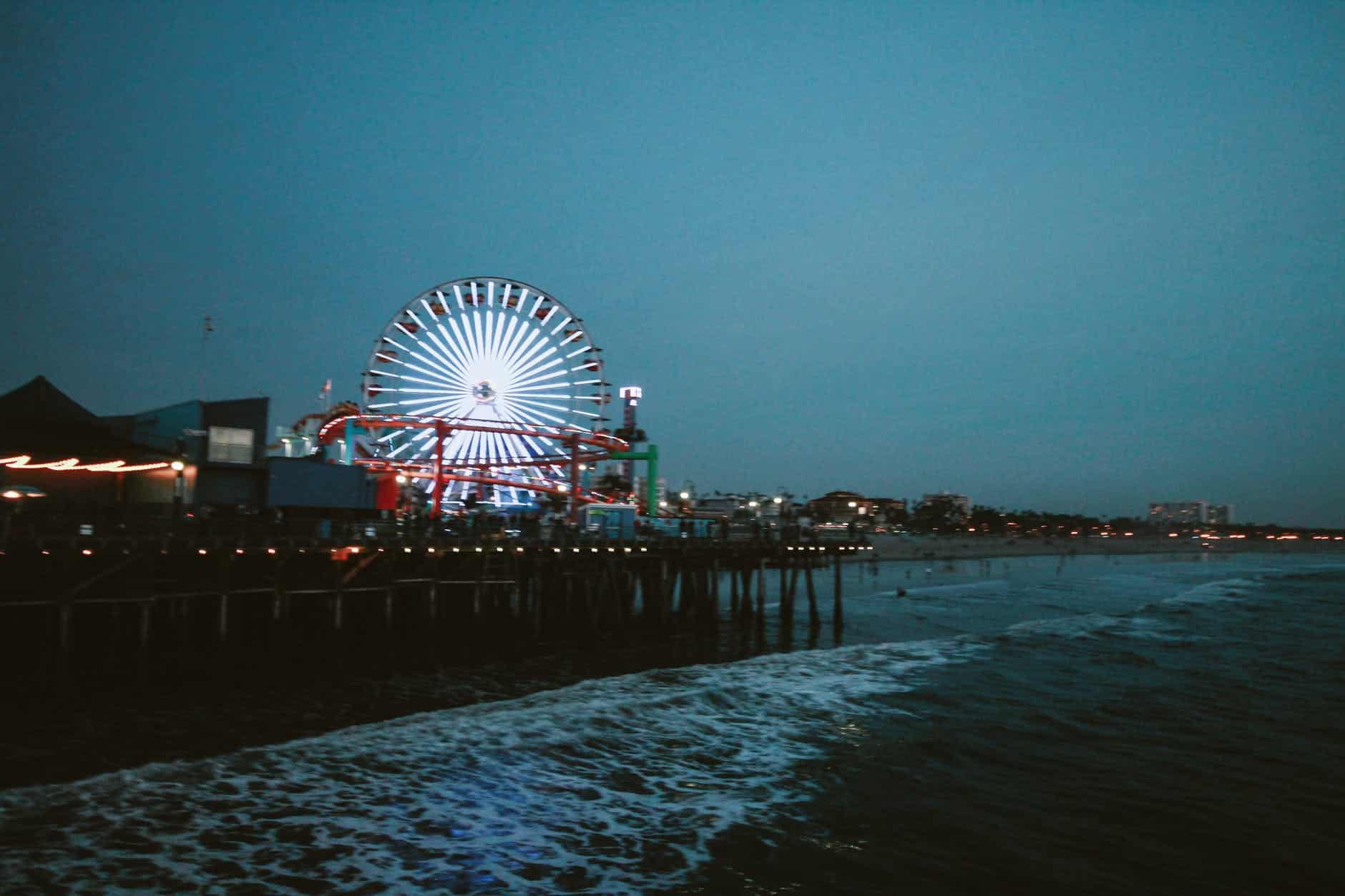
Table of Contents
1: Los Angeles Rowing Club
The Los Angeles Rowing Club was founded in 1994 and is located in Marina del Rey, California. They are a non-profit organization that is open to the public. The LARC was created with the mission to promote the sport of rowing, and they do so by providing quality rowing programs for all levels of experience. They offer both sweep rowing and sculling programs, as well as learn-to-row classes. The LARC is also home to several competitive teams that compete at the local, state, and national level.
Some of their most notable achievements include winning the US Rowing Club National Championship in 2004 and sending two athletes to the Olympic Games in 2008. In addition to their competitive teams, the LARC also has a strong community outreach program that provides free rowing lessons to underserved youth in the Los Angeles area. The LARC is truly a place for everyone, whether you’re a seasoned rower or just looking to try something new.
2: Lions Rowing Club
The Lions Rowing Club in Los Angeles, USA has a beautiful and vastly successful history. The club was established in 1887, making it one of the clubs that paved the way for the newer clubs to arrive in the 1900s. In its early years, the club was based out of a boathouse on the Los Angeles River, but today it is located on Grand Canal in Long Beach. The Lions Rowing Club has produced many national champions and Olympic champions over the years, including Olympic gold medalist John Larissa and world champion rower Sarah Trowbridge.
The club is also linked to several colleges and universities in the area, including UCLA, USC, and Pepperdine. As a result of its successes both on and off the water, the Lions Rowing Club is widely regarded as one of the premier rowing clubs in the United States.
3: Long Beach Rowing Association
The Long Beach Rowing Association Rowing Club in Los Angeles, USA has an extremely interesting history. Founded in 1872, the club started to attract rowers in vast numbers. Throughout its history, the club has been dedicated to promoting the sport of rowing and developing its members into successful athletes. Today, the club is home to a diverse group of rowers of all ages and abilities. The club offers a variety of programs for both beginners and experienced rowers, making it one of the most inclusive rowing clubs in the area.
In addition to its excellent programs, the club is also linked to several colleges and universities, making it a great place for college rowers to train and compete. The Long Beach Rowing Association Rowing Club has a proud tradition of excellence and is committed to continuing to develop world-class rowers.
4: California Yacht Club
The California Yacht Club Rowing Club in Los Angeles is a rowing club with an impressive pedigree. Founded in 1994, the club has been home to many famous and successful rowers over the years. The club is located in Marina del Rey, just a short drive from downtown Los Angeles, and it remains one of the premier rowing clubs in the country.
The club is closely linked to UCLA, which is just down the road, and many of its members are student-athletes who row for the university. In recent years, the club has produced several Olympians and national champions, cementing its place as a top rowing destination in the United States.
The Importance of Hydration When Rowing
5: Metropolitan Rowing Club
The Metropolitan Rowing Club in Los Angeles has an interesting and storied history. The club was originally founded in 1884, making it one of the first rowing clubs to welcome people through their doors. In its early years, the club was based out of a boathouse on the banks of the Los Angeles River. The club quickly gained a reputation for excellence, and in 1886 they won their first National Championship. In the years since, the club has produced numerous national champions and Olympic rowers.
Today, the Metropolitan Rowing Club is based out of a state-of-the-art facility in Marina del Rey. The club is open to rowers of all ages and abilities, and they offer a variety of programs for both recreational and competitive rowers. Whether you’re looking to get fit, compete at the highest level, or just enjoy a day on the water, the Metropolitan Rowing Club is the perfect place for you.
6: Whitehall Spirit
The Whitehall Spirit Club in Los Angeles was founded in 1997. The club has produced many national and international champions, including two Olympic gold medalists. The Whitehall Spirit Club is also linked to several colleges and universities, making it a great place for students to learn and compete. If you’re looking for a top-notch rowing club with a rich history and plenty of success, the Whitehall Spirit Club is the perfect choice.
The Row LA Rowing Club in Los Angeles is a historic rowing club that was founded in 1985. The club is based out of Marina del Rey and is one of the most well-known rowing clubs in Southern California. The club is also linked to several colleges, including the University of Southern California and UCLA. The Row LA Rowing Club is a respected and prestigious rowing club that has a rich history and tradition of success.
8: Rivanna Rowing Club
Rivanna Rowing Club is located in Los Angeles, USA. The club has produced several successful rowers, including Olympians and national champions. The club is also linked to a college nearby, which provides access to facilities and equipment. The club has a strong focus on developing young rowers and providing them with opportunities to compete at the highest level.
The club has a rich history and tradition of winning, and this is reflected in the success of its members. Rivanna Rowing Club is a highly respected and well-known club, and it continues to produce champions and contribute to the sport of rowing.
9: Open Water Rowing Center
The Open Water Rowing Center is located in Los Angeles, USA and is a rowing club that is open to the public. The club has produced several famous and successful rowers, such as Olympian rower Sue Enquist and national champion rower George Plimpton. The club is also linked to several colleges nearby, such as the University of Southern California and UCLA.
The club has been very successful in producing Olympic champions and national champions. In addition, the club has also been successful in developing young athletes into professional rowers. The Open Water Rowing Center is an excellent place for anyone interested in learning how to row or for anyone looking to improve their rowing skills.
10: Duluth Rowing Club
Founded in 1966, the Duluth Rowing Club is a popular club in LA. Located in Los Angeles, the club has produced several national and international champions, including two Olympic gold medalists. The Duluth Rowing Club is also affiliated with the University of California, Los Angeles, one of the top rowing programs in the country. As a result, the Duluth Rowing Club is considered one of the premier rowing clubs in the United States.
The Duluth club has produced numerous national champions and Olympic medalists. In addition to its competitive success, the Duluth Rowing Club is also known for its beautiful rowing facility, which overlooks downtown Los Angeles. The club is open to rowers of all levels of experience, from beginners to experienced athletes. Whether you’re looking to compete at the highest level or simply enjoy a leisurely row on a beautiful day, the Duluth Rowing Club is the perfect place for you.
Application
Cyc jr. rowing inquiry form.
We are looking forward to hearing from you
CYC Rowing Participant Information
California Yacht Club is located at: 4469 Admiralty Way, Marina del Rey, CA 90292 .
- If driving, please park in the CYC visitor’s lot adjacent to Admiralty Way and accessed from the driveway which is between Café del Rey and the Warehouse Restaurant.
- Once parked, proceed by foot and enter the member’s parking lot by passing by the main entry gate.
- After passing the main entry gate, continue walking, bearing hard left along the chain link fence at the north end of the large parking lot until it ends at a dark green shade cloth covered rowing shed.
- We meet, at the rowing sheds which are opposite the tall bamboo plants separating the Warehouse Restaurant and CYC.
If you will be late or unable to attend, PLEASE text (and identify yourself) as soon as possible: Craig Leeds 310.948.1456 and/or Anna Wilczek 818.523.2987.
If the main entry gate is locked when you arrive, please text us.
Participants should bring: athletic shoes (running shoes), socks, shorts, shirts, sunscreen, water, a change of clothes,
towel and personal items (hats, sunglasses, orthotics, inhalers, etc).
To keep all the gear organized, a small duffel bag or back pack is recommended.
Clothes should fit reasonably tightly so while rowing, hands won’t get caught in shirts and shorts won’t get caught in the sliding seats.
Dressing in layers and using wicking type fabrics is recommended.
Here are some links that will be helpful (you may need to copy and paste into a browser):
- This is a video from Concept2 regarding technique on the rowing machine which is where we begin. Please watch the video before the first session.
- World Rowing
- This is a great pictorial representation of the rowing stroke as taught at CYC:
- This is a great video showing Australian world champion scullers and sweep rowers in a beautiful setting.
- Here’s a link to the US Women winning the quad at the 2015 World Championship:
Please don’t hesitate to ask for more information.
California Yacht Club-Junior Rowing

2021 J/70 WORLDS : CHAMPION
Peter duncan and relative obscurity return to the podium as j/70 world champion at cal yacht club.
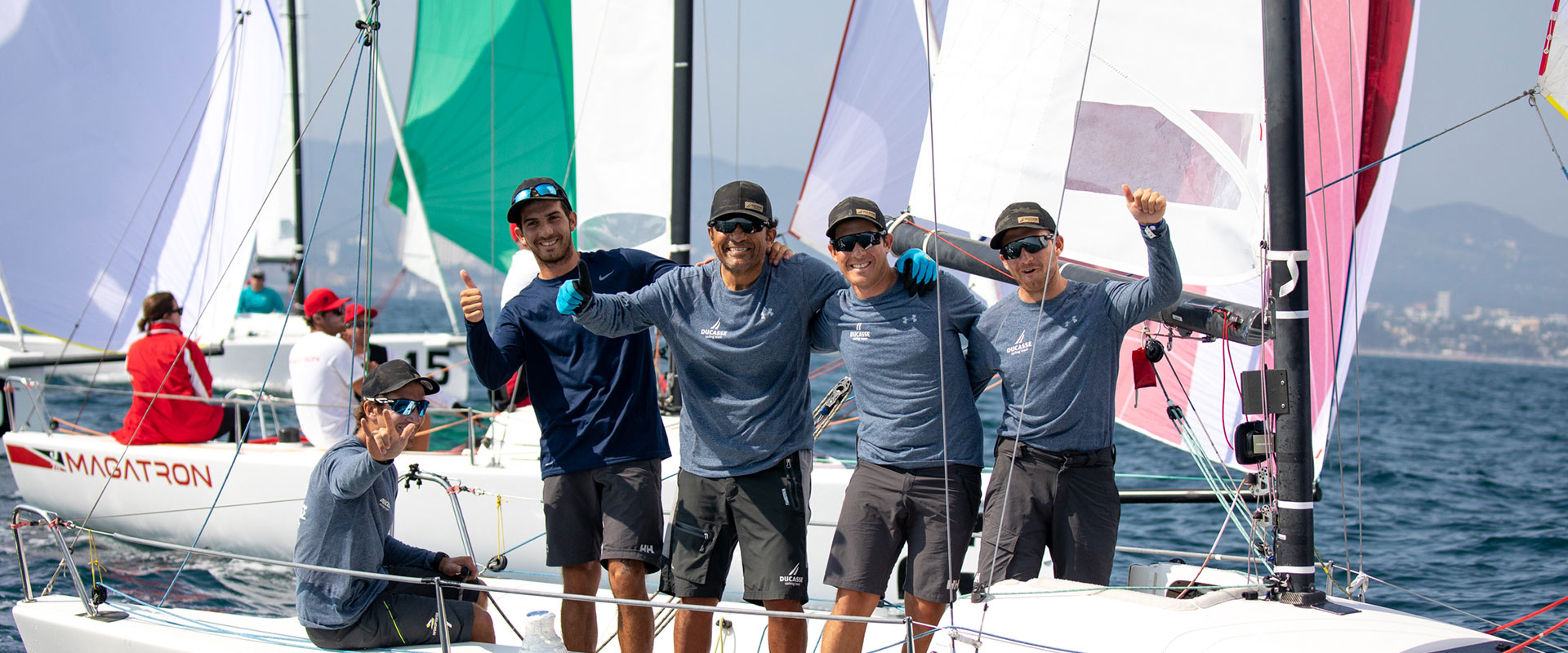
2021 J/70 WORLDS : CORINTHIAN CHAMPIONS
The ducasse sailing team of santiago, chile, triumphed in the corinthian division..
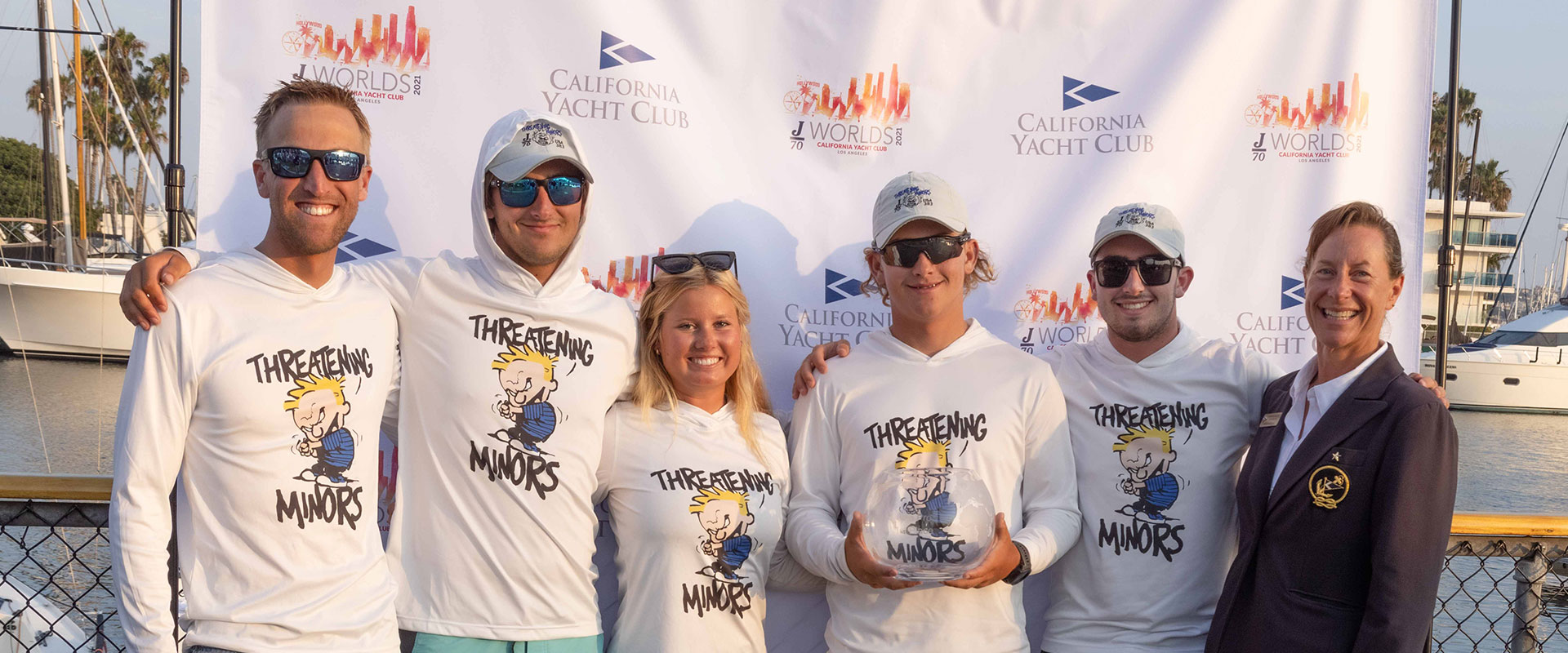
2021 J/70 WORLDS : ONE PRO CHAMPIONS
Threatening minors wins one pro..

PETER DUNCAN AND RELATIVE OBSCURITY WIN THE 2021 J/70 WORLDS
Peter Duncan and Relative Obscurity Return to the Podium as J/70 World Champion at California Yacht Club
Peter Duncan’s Relative Obscurity has prevailed over 60 other teams and challenging wind conditions to capture the 2021 J/70 World Championship title at California Yacht Club, today. In a five-day series that tested the skill and patience of top-notch competitors from 11 nations, Duncan – sailing with Willem van Waay, Morgan Trubovich and Victor Diaz de Leon – secured a top five position in the beginning of the regatta and never let go.
“I’m elated!” said Duncan as he returned to the dock, bustling with activity. “That was a tough day out there. We didn’t start very well but had a bit of a break with a header on the first run of the second race that let us get close to everybody and sail through some folks we need to sail through,” he explained. “We have a lot of fun onboard – joke and laugh and keep it light – and that worked in our favor when we had to grind through. Everybody knows what their job is, and these guys do them exceptionally well.”
WELCOME TO THE J/70 WORLDS 2021
Cal Yacht Club is proud to host the 2021 racing of the J/70 Worlds.
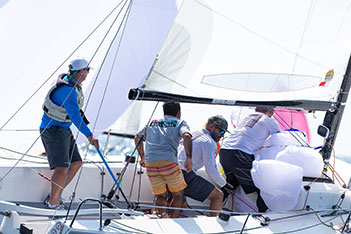
RECAP / NEWS
Peter Duncan’s Relative Obscurity has prevailed over 60 other teams and challenging wind conditions to capture the 2021 J/70 World Championship title at California Yacht Club, today.
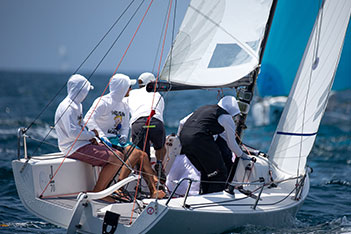
DAILY PHOTO / VIDEO
Threatening Minors sailed by Jordan Janov, Grant Janov, Ryan Janov, Reddin Kherli and Willie Mcbride, took honors.
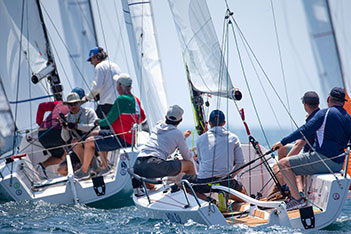
SOCIAL MEDIA
The J/70 is 22.75 feet with an 11 foot long cockpit and deck-stepped carbon mast for easy rigging and stepping.
The crew shall consist of 3 or more persons. The number of crew shall not be changed during an event.
The J/70 Class has been created as a strict one-design Class where the true test when racing is between crews and not boats and equipment.
Well, chances are it will not be like Day 1 of the Pre-Worlds. Maybe more like Day 2. But then again, this is MdR—anything can happen.
SANTA MONICA BAY
The Santa Monica Bay is dominated by an onshore breeze that typically doesn't kick in until around noon. Watch out for the oscillations!
CAL YACHT CLUB
CYC has a long history of excellence in race management. We host everything from Championship-level regattas to more casual weekend random leg races.
SAY WHAT? : THE J/70 WORLDS 2021
"Cal Yacht Club did an awesome job."
Peter Duncan | Relative Obscurity
“It was very cool that there were four boats who could have won this thing in the last race...”
CALIFORNIA YACHT CLUB
Founded originally in 1922 by yachtsmen including Charles Hathaway and Frank Garbutt, the California Yacht Club's first clubhouse was built in Wilmington, CA in Los Angeles' inner harbor (berths nos. 192 & 193), just opposite Terminal Island. Close by were the yards of renowned yacht builders Wilmington Boat Works and Fellows & Stewart (second location). In the club's inaugural year, member yachtsmen formed the first Star class fleet on the Pacific coast. Involved in all aspect of the sport, the club has encouraged a variety of pleasure boating, first in Los Angeles Harbor, and now in Santa Monica Bay.
Over the years CYC has been the club for numerous prominent yachtsmen including Merritt Adamson, Pierpont Davis, Roy E. Disney, J. Paul Getty, Samuel K. Rindge, William Stewart, James Kilroy and navigator extraodinaire, Ben Mitchell. Movie mogul Cecil B. DeMille once served as a trustee of the club and donated a gold cup for powerboat racing. Comedy film producers Al Christie and Hal Roach were both deeply involved in club activities in the twenties and thirties.
Power boating has always been a part of the club's mission along with sailing and rowing. The first CYC powerboat regatta was run in 1922 and the winner was none less than the famous Gar Wood in his Harmsworth Trophy winner Miss America. CYC's Catalina Challenge race for powerboats has been run annually since 1922.
A fire on Thanksgiving Day, 1930 severely damaged the original clubhouse although the heroic efforts of some members saved all of the trophies.
In 1932, several CYC members figured prominently in the sailing events at the Los Angeles Olympic Games. Owen Churchill, inventor of the SwimFin, won the gold medal in the Eight-Metre Class with Angelita.
Unfortunately, the club was forced to relinquish its key location in the East Basin to the Coast Guard for the war effort in 1941. A dormant period followed.
With the development of the long-awaited Marina Del Rey in the early 1960s, the club reformed in '63 and elected Fritz Overton, Commodore in 1923, as head of the "new" club. In 1966, they opened the modern clubhouse and marina facility that is their home today. The radial design of the building allows sweeping panoramic views of the marina.
The California Yacht Club is owned by the Hathaway family, owners of the Los Angeles Athletic Club. The annual "Great Catalina to Marina del Rey Rowing and Paddling Event" pays tribute to Charles Hathaway's row in 1976 from Catalina Island to the club on his 50th birthday.
The unique combination of private ownership and annually elected flag officers has worked well to establish California Yacht Club as one of the outstanding clubs in the nation.
‘Nothing left’: After California Yacht Club fire, residents mourn loss of a beloved spot
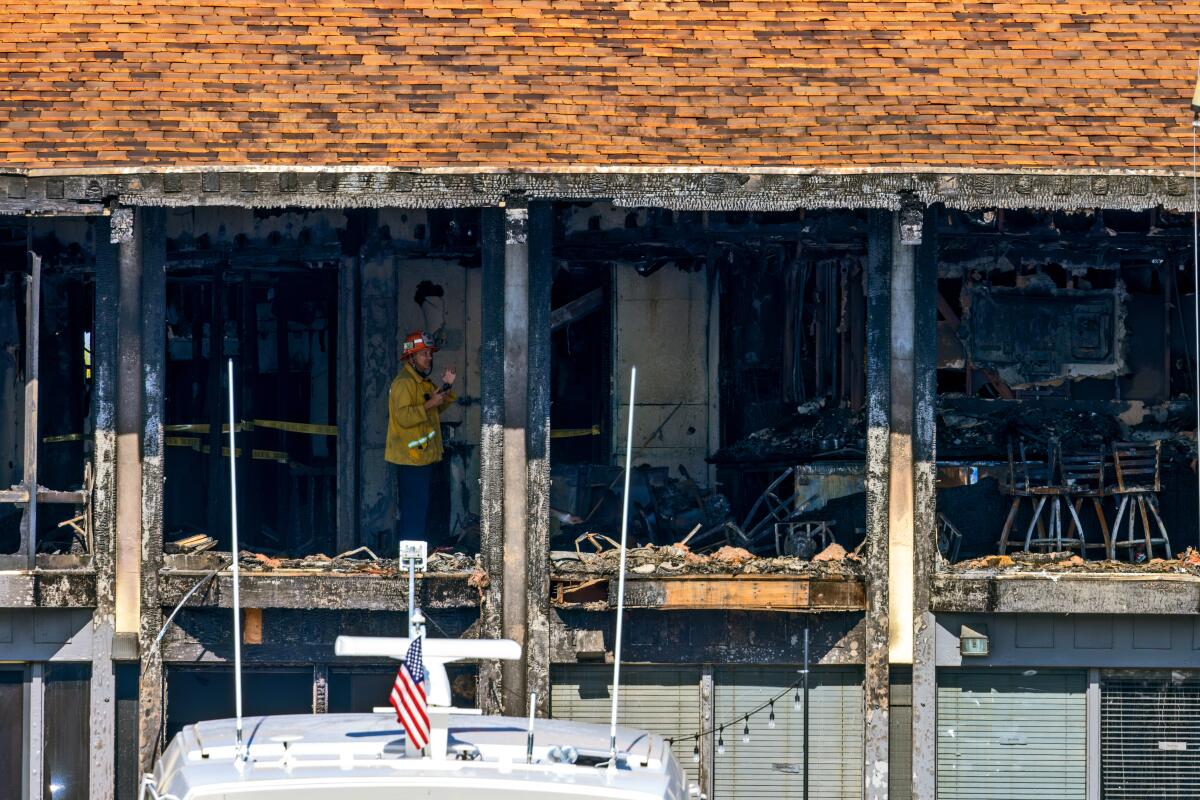
- Show more sharing options
- Copy Link URL Copied!
In an instant, an overnight seaside blaze engulfed decades’ worth of boating trophies, historical artifacts and cherished memorabilia at the California Yacht Club in Marina del Rey on Monday.
Fire crews attempted to control the blaze as heavy smoke and flames consumed the two-story building. By the time they had subdued the fire two hours later, only the skeletal remnants of the clubhouse were left standing.
John Myers, senior vice president of the club, said the blaze had been reported by an employee working late in the clubhouse Monday night. The fire spared the remainder of the facilities on the ground, including the docks and the yachts moored there. But the clubhouse, and particularly its second floor, was all but wiped out.
“We are working closely with the Los Angeles County Fire Department in their investigation of the cause of the incident and will share those findings when they become available to us,” Myers said.

Members are left mourning, comparing the loss to the death of a loved one.
Jennifer Dakoske Koslu awoke in Rancho Mirage at 5:30 a.m. Tuesday, before the sun had risen, to find her phone inundated with text messages from club members.
The first message she read simply stated, “The CYC is gone.”
“As soon as I opened my phone, it went to a link on the Citizen app and saw a video of the club burning. I was shocked,” Dakoske Koslu said.
For the last 24 years, Dakoske Koslu and her family have been dedicated members of the CYC, whose clubhouse is a few miles away from their home in Playa del Rey. She said it is where her children have grown up, familiarizing themselves with every inch.
“I remember taking my son there on the Fourth of July when he was just 3 weeks old. It was the first place we went with him as a newborn,” Dakoske Koslu said.
She and her husband biked to the club in the aftermath of the fire, greeted by the charred remains of the building on Wednesday afternoon.
“The destruction is unbelievable. It’s clear that the fire was burning intensely on the second floor,” Dakoske Koslu said. “There’s nothing left.”
The second floor once housed a collection of the club’s prestigious racing trophies, kept on display for members and visitors. The fire melted all but a single salvageable California Cup. Most notably, the priceless King of Spain Trophy, acquired in 1929 from King Alfonso XIII, was lost.
Additionally, the club lost cherished photographs of every past commodore, a significant position within a yacht club. Members said they didn’t know if anyone had digitized the images of the commodores or of the club’s founders.
“We would tell yachting stories at the bar around lots of memorabilia, and the yachting artifacts behind the bar are all gone now,” Tom Materna said. “The yacht club provided us a facility for the off-the-water celebrations after hard-fought competition on the water.”
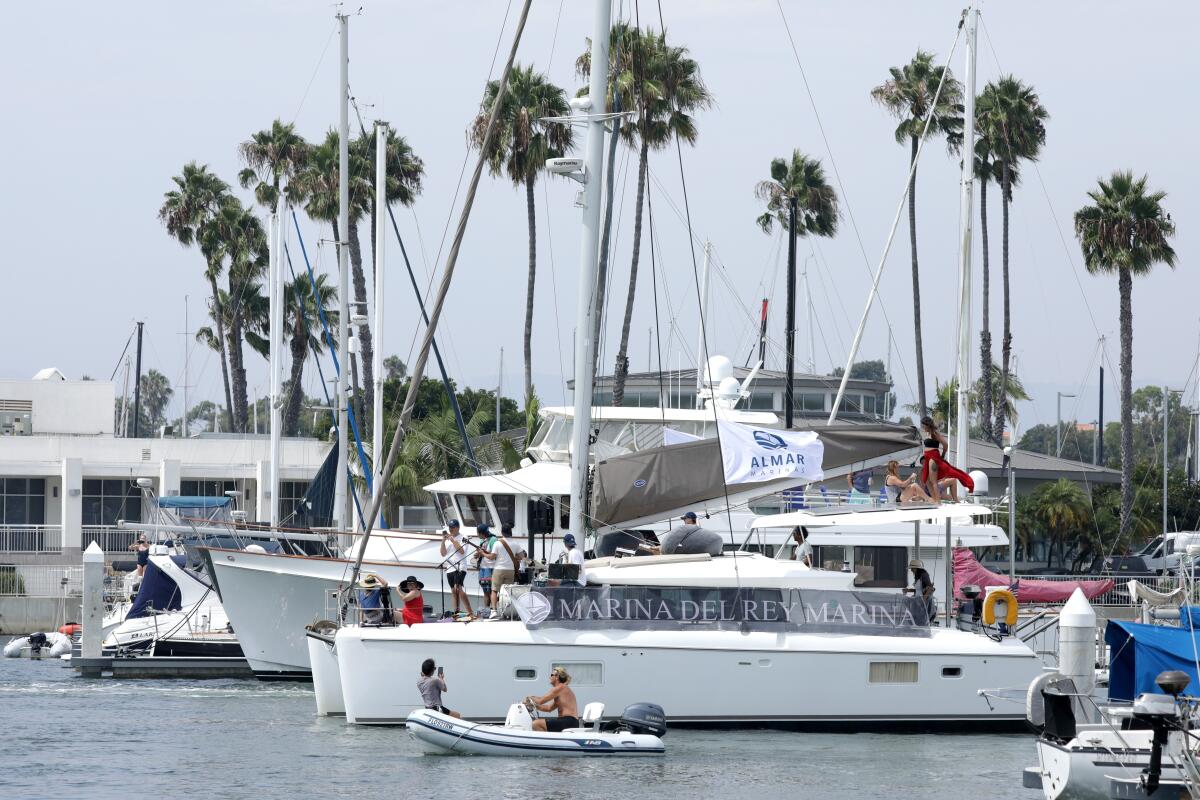
The CYC dates to the early 1920s, started by boat owners from the Los Angeles Athletic Club and other yacht clubs. The Board of Harbor Commissioners approved the first clubhouse in 1922, designed by famed architect Edwin Bergstrom, co-designer of the Pentagon.
In 1965, the yacht club submitted a proposal for an all-encompassing $1-million, two-story, 10,000-square-foot clubhouse on four acres off Admiralty Way. Members envisioned a state-of-the-art facility with 170 boat slips, a guest dock, a small boat hoist and a dry land storage facility for boats. The clubhouse that resulted was dedicated on June 10, 1967.
Then-Commodore William A. DeGroot Jr. told The Times that the triangular parcel of land on which the clubhouse still sits is a “perfectly logical place for a club facility, and a commanding view down the main channel of the marina.”
Though the building has historical significance to its members, it does not have a historic designation, according to Linda Dishman, president of the Los Angeles Conservancy.
“We are deeply saddened by this tragedy and so grateful for the outpouring of support from the community and our members,” Myers said. “CYC has been a beacon for the nautical community for the past 101 years.”
Materna, 68, first found out about the fire through Facebook as friends posted videos and photos of the damage Tuesday morning. Then he began receiving calls and text messages from friends.
“Everybody woke up in the morning and realized we’d lost a significant part of the sailing community,” Materna said.
His connection to the club dates back nearly 52 years, to when he was just 16 years old. After spending 30 years sailing professionally with Hobie Cats, mainly racing catamarans — a watercraft with two parallel hulls of equal size — he recently served as a crew member on other club members’ racing yachts.
The CYC is pivotal in the boat racing community, organizing and hosting events such as the Optimist National Championship and Junior Olympic trials, Materna said. He fondly remembers the hundreds of people from across the globe converging on the marina for similar events.
The main topic among members now is what’s next for the club. Dakoske Koslu noted that the club’s ownership changed over the last few years, and many are unsure and concerned about the club’s continuation after the fire.
The club relocated to the marina in 1967, leasing the land it sits on from the county.
“I don’t think the county has really valued the contributions of the California Yacht Club as an important part of the Marina. They value Trader Joe’s because it’s more money for them,” Dakoske Koslu said.
Dakoske Koslu said she’s seen numerous small marine-oriented businesses displaced from the marina, making way for more commercialized developments such as Trader Joe’s and Recreational Equipment Inc.
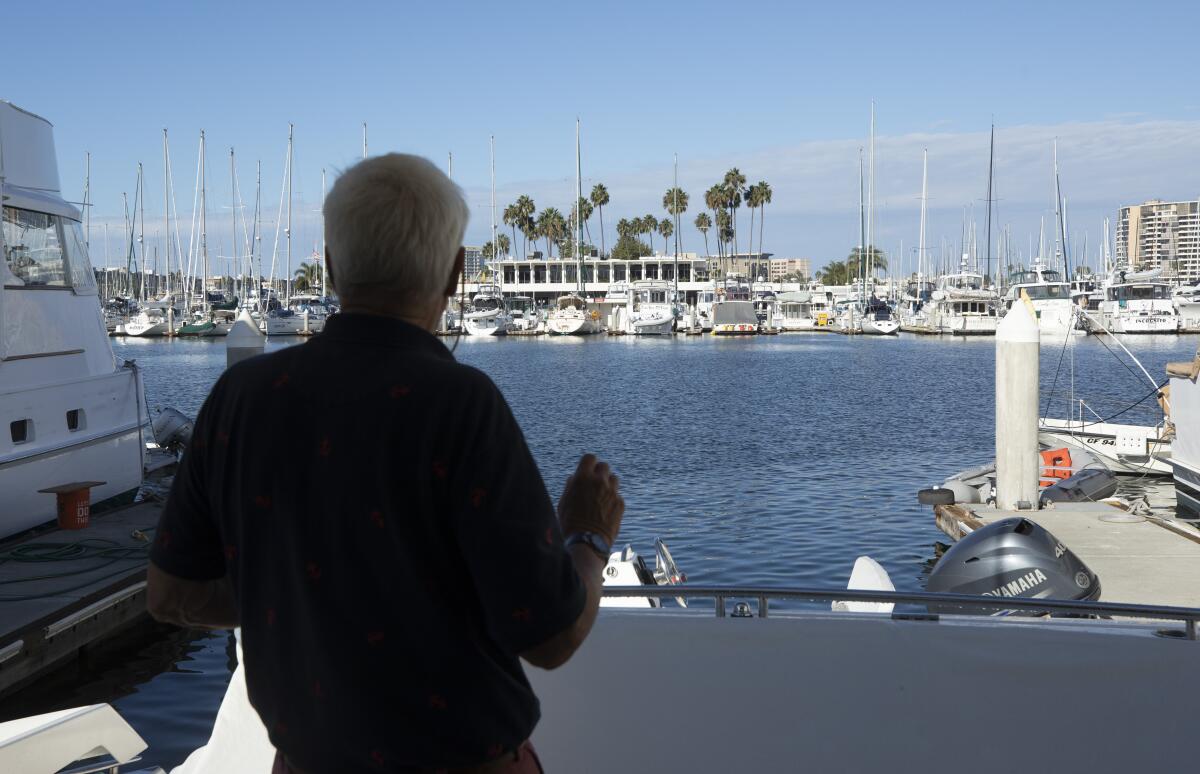
More to Read

Monterey Park shooting survivors dance again in sadness, solidarity: ‘Nothing can kill our spirit’
Jan. 22, 2024
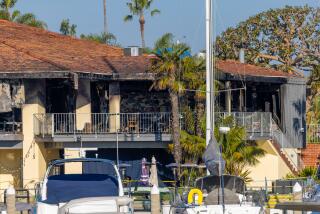
Fire guts historic California Yacht Club in Marina del Rey
Dec. 12, 2023
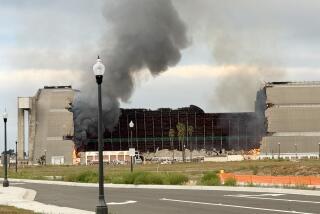
After 24 days, officials declare Tustin hangar fire ‘fully extinguished’
Dec. 2, 2023
Start your day right
Sign up for Essential California for news, features and recommendations from the L.A. Times and beyond in your inbox six days a week.
You may occasionally receive promotional content from the Los Angeles Times.

Anthony De Leon is a 2023-24 reporting fellow at the Los Angeles Times. Born in Fresno to a Chicano family, he pursued his higher education in his hometown, earning an associate‘s degree in journalism from Fresno City College and then completing a bachelor’s in media, communications and journalism at Fresno State. He went on to complete his master’s in media innovation at the University of Nevada, Reno.
More From the Los Angeles Times

Migrant arrests are up along the border in California and dropping in Texas. Why?

The informant next door: A quiet L.A. life masked Kremlin ties for FBI source accused of lying about Bidens
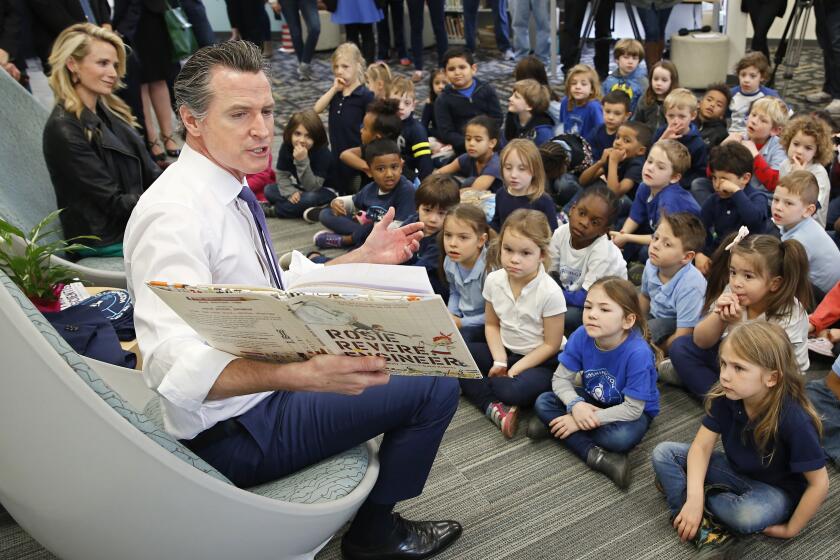
Opinion: Should California schools stick to phonics-based reading ‘science’? It’s not so simple
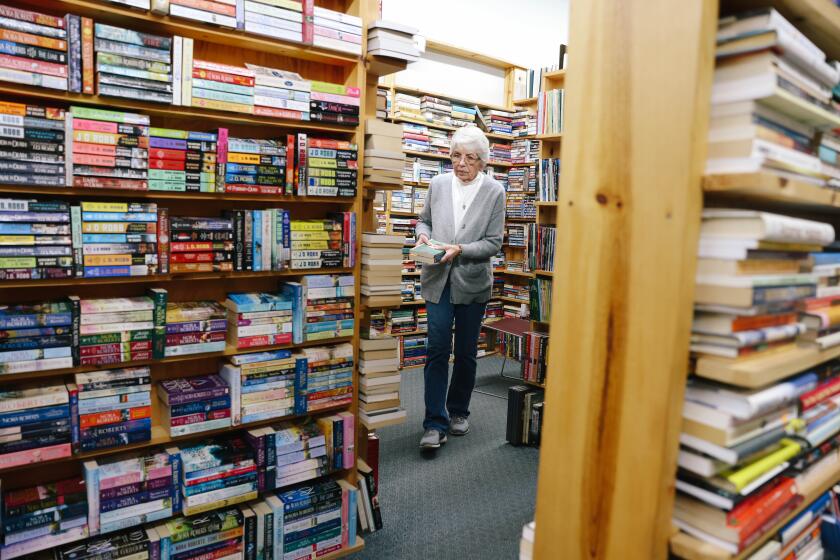
She poured her heart into Arcadia’s Book Rack. Now the small bookstore is closing
Rowing club los angeles: everything you need to know.
If you’re interested in rowing and live in Los Angeles, you’re in luck. Los Angeles has a long history of rowing, and there are many rowing clubs to choose from. Rowing is an excellent way to stay in shape, meet new people, and enjoy the beautiful outdoors. In this article, we’ll take a closer look at rowing clubs in Los Angeles, their history, benefits, and how to join them.
History of Rowing Club in Los Angeles
Rowing has been a popular sport in Los Angeles for over a century, with the first rowing club, the Los Angeles Rowing Club, established in 1908. The club was founded by a group of rowing enthusiasts who wanted to promote the sport in Southern California. The first boathouse was located in the Venice Canals, and the club quickly gained popularity.
Over the years, many other rowing clubs have been established in Los Angeles, including the California Yacht Club, the Long Beach Rowing Association, and the Marina Aquatic Center. These clubs have played a significant role in promoting rowing in Los Angeles, and their members have achieved many successes in local and national competitions. Despite many challenges, including funding, maintenance, and environmental issues, rowing clubs in Los Angeles continue to thrive and attract new members.
Rowing is a low-impact, full-body workout that is suitable for people of all ages and fitness levels. Joining a rowing club in Los Angeles offers many benefits, including improving your physical and mental health, socializing with like-minded people, and competing in rowing events.
Health Benefits
Rowing is an excellent way to improve your cardiovascular health, build muscle strength, and burn calories. According to a study by Harvard Health Publishing, rowing burns more calories than running or cycling, making it an effective way to lose weight and get in shape. Rowing also helps to reduce stress, improve sleep quality, and boost your mood.
Social Benefits
Joining a rowing club in Los Angeles provides an opportunity to meet new people, make friends, and socialize. Rowing clubs often organize social events such as barbecues, parties, and team-building exercises, allowing you to connect with other members outside of the boat. Rowing also promotes teamwork, communication, and leadership skills, which can be applied to other areas of your life.
Next, we will discuss how to join a rowing club in LA and popular rowing clubs in the area.
The Benefits of Joining a Rowing Club in Los Angeles
Rowing is an excellent way to stay active and healthy, but joining a rowing club in Los Angeles offers many additional benefits beyond physical fitness.
Rowing is a low-impact, full-body workout that improves cardiovascular health, builds muscle strength, and burns calories. Regular rowing can help reduce the risk of chronic diseases such as diabetes, heart disease, and obesity. Additionally, rowing is an excellent way to improve flexibility and balance, which is essential for maintaining mobility as you age.
Joining a rowing club in Los Angeles provides an opportunity to meet new people, make friends, and develop a sense of community. Rowing clubs often organize social events such as barbecues, parties, and team-building exercises, allowing you to connect with other members outside of the boat. Rowing also promotes teamwork, communication, and leadership skills, which can be applied to other areas of your life.
Competitive Benefits
For those who enjoy competition, joining a rowing club in Los Angeles provides opportunities to participate in local and national rowing events. Rowing clubs often have teams that compete in regattas, races, and other events, giving members a chance to test their skills against other rowers. Participating in rowing competitions can be a fun and rewarding experience, and it can help you set and achieve personal goals.
How to Join a Rowing Club in Los Angeles
Joining a rowing club in Los Angeles is relatively easy, but there are some requirements you need to meet before you can become a member. Here’s what you need to know:
Requirements for Joining
Most rowing clubs in Los Angeles require that you be at least 18 years old and have a basic level of fitness. Some clubs may also require that you have previous rowing experience or complete a rowing class before you can join. Additionally, you may need to pass a swim test to ensure that you can safely navigate the water.
Application Process
To join a rowing club in Los Angeles, you will need to fill out an application form and pay a membership fee. The application form will typically ask for your contact information, rowing experience (if any), and emergency contact information. Once your application is approved, you will be given access to the club’s facilities and equipment. Some clubs may also require that you attend an orientation session to learn about the club’s rules and safety procedures.
Popular Rowing Clubs in LA
There are many rowing clubs to choose from in Los Angeles, each with its unique features, facilities, and programs. Here are some of the most popular rowing clubs in the area:
1. Los Angeles Rowing Club
The Los Angeles Rowing Club is the oldest rowing club in the city, founded in 1908. The club is located in a historic boathouse in the Marina del Rey harbor and offers programs for rowers of all levels, from beginners to advanced. The club has a competitive racing team, a recreational rowing program, and hosts many social events throughout the year.
2. California Yacht Club
The California Yacht Club is located in Marina del Rey and has a dedicated rowing program with a focus on competitive racing. The club has a state-of-the-art boathouse and equipment and offers programs for juniors and adults.
3. Long Beach Rowing Association
The Long Beach Rowing Association is located in Long Beach and offers programs for all levels, including recreational, competitive, and adaptive rowing. The club has a large boathouse and a fleet of boats, including singles, doubles, quads, and eights.
4. Marina Aquatic Center
The Marina Aquatic Center is located in Marina del Rey and is affiliated with the University of Southern California. The center offers rowing programs for USC students and the general public, including recreational and competitive rowing. The center has a large boathouse, a fleet of boats, and a team of experienced coaches.
In conclusion, joining a rowing club in Los Angeles is an excellent way to stay in shape, make new friends, and enjoy the beautiful outdoors. Rowing offers many health benefits, including improving cardiovascular health, building muscle strength, and reducing stress. By joining a rowing club, you can also develop teamwork, communication, and leadership skills, which can be applied to other areas of your life.
If you’re interested in joining a rowing club in Los Angeles, there are many options to choose from, each with its unique features and programs. We encourage you to check out the clubs we’ve listed and find one that suits your needs and interests. Remember, rowing is a lifelong sport that can be enjoyed at any age and fitness level, so why not give it a try and see what it can do for you? Join a rowing club in Los Angeles today and experience the benefits of this fantastic sport!

- CLASSIFIEDS
- NEWSLETTERS
- SUBMIT NEWS
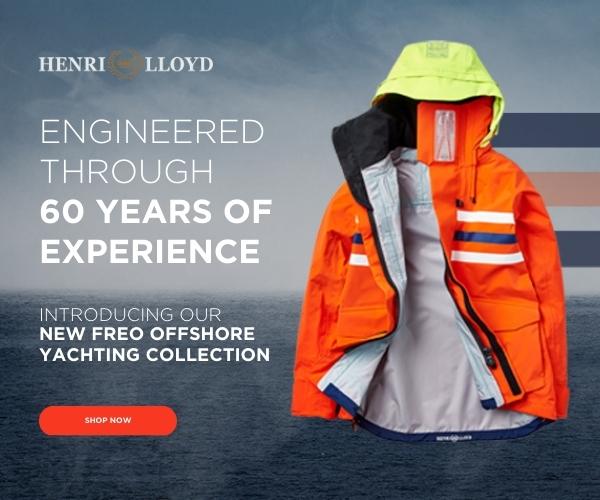
2024 Puerto Vallarta Race at San Diego Yacht Club - Day 1
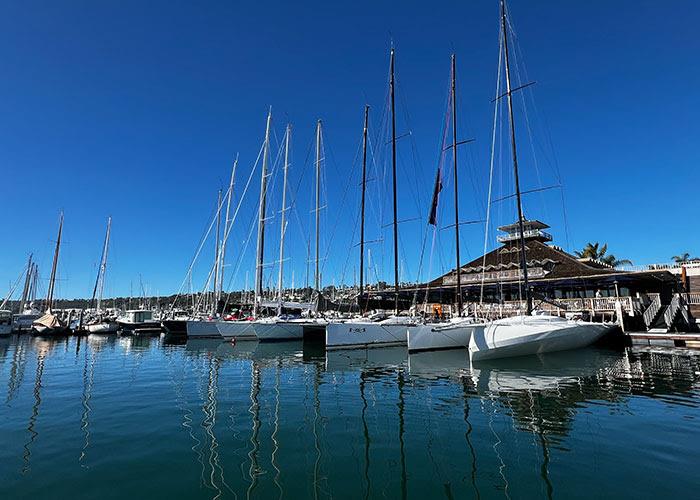
Related Articles
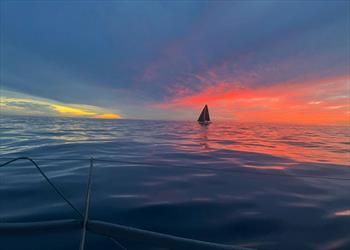
News from non-English countries
"They fell to the ground with screams": Russian Guards fired at children single near Moscow - there is a casualty
2023-08-20T20:58:57.477Z
Highlights: In Russia, in the city of Elektrostal (Moscow region), during demonstrations, Rosgvardia soldiers began shooting at spectators with children from machine guns with blank cartridges. One child received serious damage from a rebounded cartridge case. In the video, a child can be heard crying and screaming violently. It is also interesting that Russia recently arranged a solemn farewell to Vladimir Shestakov, convicted for the murder of a child, who became a mercenary of PMC "Wagner" and was liquidated in the war in Ukraine.

In Russia, in the city of Elektrostal (Moscow region), during demonstrations, Rosgvardia soldiers began shooting at spectators with children from machine guns with blank cartridges.
So far, one injured child is known.
This was reported by the local Telegram channel of the Cheka-OGPU.
"Small children were clutching their heads screaming and falling to the ground. Not without injuries. The child received serious damage from a rebounded cartridge case," the report said.
One of the witnesses to the incident posted a video. It was her child who was shot by the Russian Guards. In the video, a child can be heard crying and screaming violently.
After the woman realized that her child had been wounded, she called her husband and doctor.
Meanwhile, Russian occupier Ivan Alekseev in the war in Ukraine after a drunken quarrel killed his colleague and tried to cover up the crime, saying it was the work of "Ukrainian saboteurs."
It is also interesting that Russia recently arranged a solemn farewell to Vladimir Shestakov, convicted for the murder of a child, who became a mercenary of PMC "Wagner" and was liquidated in the war in Ukraine.
- The suspect in the murder of a military volunteer was released from custody
- They will teach "patriotism": Russians in the occupied territories launch cadet classes
- Russia has created another training ground near Mariupol: how many soldiers are in the city
Source: tsn
All news articles on 2023-08-20
Lebanese economist: More than $5 billion in economic losses as a result of the Israeli bombing in the south 2024-02-22T19:51:47.940Z
Alexey Navalny died of natural causes, according to a medical report shown to his mother 2024-02-22T19:51:40.552Z
Ukraine deters powerful Russian aviation, but missiles are running out - Western analysts 2024-02-22T19:51:34.062Z
Rumen Petkov: Why is there no commission for Alexei Petrov, is he less murdered? - Politics 2024-02-22T19:41:54.985Z
Indexation of pensions: who is waiting for an increase and what is the maximum amount 2024-02-22T19:41:47.569Z
El presidente de Ecuador explica por qué cambió de idea y no va a triangular armamento con Estados Unidos 2024-02-22T19:41:40.057Z
The US announced sanctions against Russian oligarchs - US 2024-02-22T19:41:33.285Z
The threat is real: Zhorin on the "accession" of Transnistria to the Russian Federation and ways to solve the problem 2024-02-22T19:31:41.099Z
In pictures: Israel destroys Yasser Arafat's house in Gaza 2024-02-22T19:31:33.225Z
Yavor Bozhankov: Through the memorandum, we offer non-politicized figures - Politics 2024-02-22T19:22:34.868Z
Russia poses a threat to Western countries underwater — Bloomberg 2024-02-22T19:22:28.686Z
Resumption of flights from Ukraine: how long will it take and will anyone be able to fly 2024-02-22T19:22:20.429Z
Russia: Israel is deliberately working to expel the Palestinians from Gaza 2024-02-22T19:21:47.736Z
Kuleba is in Warsaw to ensure the smooth passage of military aid to Kiev - EU 2024-02-22T19:21:40.328Z
"Project": Putin repressed more people than Brezhnev over the past 6 years 2024-02-22T19:11:40.960Z
Peter Stano: Medvedev should take care of his psyche - US 2024-02-22T19:11:33.489Z
USA: Houthi missiles hit British ship in Red Sea - Middle East 2024-02-22T19:01:40.890Z
A second summit in Paris to exchange prisoners.. Will it succeed in stopping the Israeli war on Gaza? 2024-02-22T18:51:55.880Z
"The military should feel needed": how well-known activists offer to help the defenders of Ukraine 2024-02-22T18:51:46.860Z
The EP calls for an investigation into the spyware found on the phone of an MEP - EU 2024-02-22T18:51:39.323Z
The Armed Forces of Ukraine were hit by motorized riflemen from Transbaikalia near Volnovakha: at least 60 Russian occupiers were killed - mass media News/Politics 2024-02-21T01:01:05.199Z
Russia faces the biggest drone assault on its own territory since the start of the invasion of Ukraine News/Politics 2023-08-30T19:20:25.125Z
Mayor: Houses in Kharkiv survive Russian missile attack News/Politics 2024-01-08T04:35:43.208Z
Volleys from Grady, DRG hunting and drones: how do the residents of Semenivka live, who see Russia from the windows News/Politics 2024-01-25T17:38:35.096Z
Jiuba MMA. There is a piece | Two women beat each other, kicked their stomachs and screamed, and one person roared: The shirt was rotten Life/Entertain 2023-08-29T12:21:13.624Z
Friendly fire: in Russia, a soldier shot his friend while hunting News/Politics 2023-09-19T18:06:18.501Z
Massive UAV raid on Russia: there were reports of "arrivals" on military facilities News/Politics 2023-11-26T20:07:15.992Z
Ukrainian army: Russia launches large-scale attack on Ukraine News/Politics 2024-01-08T09:35:57.571Z
Change of tactics, dangerous drones and where a "major offensive" of the Russian Federation is expected: what is known about the situation at the front News/Politics 2024-01-08T11:06:34.048Z
AT&T customers report massive service outage. Verizon and T-Mobile also report failures News/Politics 2024-02-22T12:51:36.220Z
E-cigarette explodes in man's pocket - EU News/Politics 2024-02-22T10:32:47.254Z
Jordan airdrops medical aid into Gaza in cooperation with Britain News/Politics 2024-02-22T00:31:35.733Z
4 thousand victims in 2023. Africa hosts half of the global “terrorism” activities News/Politics 2024-02-22T00:41:24.515Z
Explainer: Battle of constitutional recognition and identity crisis! 'Don't want Rajasthani language' trending on Twitter News/Politics 2024-02-22T05:31:39.885Z
The State Department stated that the Russian Federation could not gain an advantage in the war against Ukraine News/Politics 2024-02-21T23:41:18.927Z
300,000 tons of sugar are coming - Bashe News/Politics 2024-02-22T12:32:38.087Z
Canada is going to help finance massive shipments of ammunition to Ukraine - CBC News News/Politics 2024-02-21T21:51:18.263Z
Air alert in the Israeli city of Eilat on the Red Sea - Middle East News/Politics 2024-02-22T05:01:49.555Z
Putin at the inauguration of the Future Games: “Sport should unite people” News/Politics 2024-02-22T04:42:06.063Z
© Communities 2021 - Privacy
- Sport Betting
- Yearly calendar
- Latest results
- English Español French Italiano Nederlands
TheSports.org
All sports Site

Field hockey - Dinamo Elektrostal Moscow

Hockey Club Dinamo Elektrostal is a field hockey team from Russia, based in Moscow. The club was founded in 1994.
Dinamo Elektrostal Moscow - Results
2021/2022 2018/2019 2017/2018 2017 2015/2016 2013/2014 2011/2012 2007/2008
Men's Euro Hockey League - Final Round - 2021/2022
Dinamo elektrostal moscow - identity.
- Official name : Hockey Club Dinamo Elektrostal
- Country : Russia
- Location : Moscow
- Founded : 1994
- Wikipedia link : http://nl.wikipedia.org/wiki/Dinamo_Elektrostal
Dinamo Elektrostal Moscow - Titles, trophies and places of honor
- Best result : First Round in 2021/2022
- Best result : 1st
- 1 times first in 2010
- 1 times second in 2009
- 1 times third in 2017
Postal Address
- © Info Média Conseil : 419 Rue Lemelin, St-François QC G0A3S0, Canada
- Vacation Rentals
- Restaurants
- Things to do
- Moscow Tourism
- Moscow Hotels
- Moscow Bed and Breakfast
- Moscow Vacation Rentals
- Flights to Moscow
- Moscow Restaurants
- Moscow Attractions
- Moscow Travel Forum
- Moscow Photos
- All Moscow Hotels
- Moscow Hotel Deals
- Moscow Motels
- Moscow Campsites
- Moscow Hostels
- Business Hotels Moscow
- Moscow Family Hotels
- Spa Resorts Moscow
- Moscow Luxury Hotels
- Romantic Hotels Moscow
- Moscow Green Hotels
- Moscow Ski-In / Ski-Out Hotels
- Moscow Resorts
- 5-stars Hotels in Moscow
- 4-stars Hotels in Moscow
- 3-stars Hotels in Moscow
- Radisson Blu Hotels in Moscow
- Hampton by Hilton Hotels in Moscow
- AZIMUT Hotels in Moscow
- Marriott Hotels in Moscow
- Novotel Hotels in Moscow
- Holiday Inns in Moscow
- ibis Hotels in Moscow
- Crowne Plaza Hotels in Moscow
- Rotana Hotels in Moscow
- Accor Hotels in Moscow
- InterContinental (IHG) Hotels in Moscow
- Radisson Hotels in Moscow
- Moscow Hotels with a Pool
- Pet Friendly Hotels in Moscow
- Moscow Hotels with Parking
- 3rd Transport Ring (TTK) Hotels
- District Central (TsAO) Hotels
- Garden Ring Hotels
- Tverskoy Hotels
- Boulevard Ring Hotels
- Zamoskvorechye Hotels
- Arbat Hotels
- Meshchanskiy Hotels
- District Eastern (VAO) Hotels
- Red Square & Kitay-gorod Hotels
- Moscow Affordable Hotels
- Boutique Hotels Moscow
- Moscow Heritage Hotels
- Downtown Moscow Hotels
- Hotels with Hot Tubs in Moscow
- Moscow Horseback Riding Hotels
- Moscow Hiking Hotels
- Moscow Hotels with Game Room
- Moscow Hotels with Lounge
- Moscow Hotels with Bridal Suite
- Hotels near Red Square
- Hotels near Moscow Metro
- Hotels near Saint Basil's Cathedral
- Hotels near Moscow Kremlin
- Hotels near High-Speed Train Sapsan
- Hotels near GUM
- Hotels near State Tretyakov Gallery
- Hotels near Tsaritsyno Museum-Reserve
- Hotels near Armoury Chamber
- Hotels near Bolshoi Theatre
- Hotels near (ZIA) Zhukovsky International Airport
- Hotels near (VKO) Vnukovo Airport
- Hotels near (DME) Domodedovo Airport
- Grand Bavaro Princess
- Grand Sirenis Riviera Maya Resort
- Hotel Playa Vista Azul
- Iberostar Selection Varadero
- Bahia Principe Luxury Akumal
- Barcelo Maya Palace
- Sanctuary At Grand Memories Varadero
- Grand Memories Varadero
- Paradisus Princesa Del Mar Resort & Spa
- Melia Internacional Varadero
- Serenade Punta Cana Beach & Spa Resort
- Grand Muthu Cayo Guillermo Hotel
- Royalton Cayo Santa Maria
- BlueBay Grand Esmeralda
- Barcelo Bavaro Palace All Inclusive Resort
- Popular All-Inclusive Resorts
- Popular Beach Resorts
- Popular Family Resorts
- Popular All-Inclusive Hotels
- Popular Hotels With Waterparks
- Popular Honeymoon Resorts
- Popular Luxury Resorts
- Popular All-Inclusive Family Resorts
- Popular Golf Resorts
- Popular Spa Resorts
- Popular Cheap Resorts
- All Moscow Restaurants
- American Restaurants with Buffet in Moscow
- Cafés in Moscow
- Eastern European Restaurants with Outdoor Seating in Moscow
- Fast Food Restaurants in Moscow
- Italian Restaurants in Moscow
- Japanese Restaurants in Moscow
- Mediterranean Restaurants in Moscow
- Pizza in Moscow
- Russian Restaurants in Moscow
- Seafood Restaurants in Moscow
- Sushi Restaurants with Private Dining in Moscow
- Vegan Restaurants in Moscow
- Vegetarian Restaurants in Moscow
- Best Hummus in Moscow
- Best Green Curry in Moscow
- Best Sandwiches in Moscow
- Best Tempura in Moscow
- Best Pad Thai in Moscow
- Best Hot Dogs in Moscow
- Best Burritos in Moscow
- Best Salad in Moscow
- Best Lobster in Moscow
- Best Pancakes in Moscow
- Best Noodle in Moscow
- Best Salmon in Moscow
- Best Tortellini in Moscow
- Best Focaccia in Moscow
- Best Juice & Smoothies in Moscow
- Breakfast Restaurants in Moscow
- Lunch Restaurants in Moscow
- Dinner Restaurants in Moscow
- Bakeries in Moscow
- Buffet Restaurants in Moscow
- Coffee & Tea in Moscow
- Desserts in Moscow
- Food Delivery Restaurants in Moscow
- Kid Friendly Restaurants in Moscow
- Late Night Restaurants in Moscow
- Restaurants for Special Occasions in Moscow
- Restaurants with Outdoor Seating in Moscow
- Romantic Restaurants in Moscow
- Arbat Restaurants
- Basmanny Restaurants
- Buffet Restaurants in Khamovniki
- Desserts in Presnensky
- Hamburgers in Presnensky
- International Restaurants in Basmanny
- Khamovniki Restaurants
- Late Night Mediterranean Restaurants in Tverskaya
- Maryina Roshcha (Jewish Quarter) Restaurants
- Patriarch Ponds Restaurants
- Presnensky Restaurants
- Red Square & Kitay-gorod Restaurants
- Tverskaya Restaurants
- Yakimanka Restaurants
- Zamoskvorechye Restaurants
- GreenLeaders
- Things to Do
- Travel Stories
- Rental Cars
- Add a Place
- Travel Forum
- Travellers' Choice
- Help Centre
- Europe
- Russia
- Central Russia
- Moscow
- Moscow Restaurants
Club Risovalshchikov
Ratings and reviews, food and ambience, location and contact.

CLUB RISOVALSHCHIKOV, Moscow - Butovo South - Restaurant Reviews, Photos & Phone Number - Tripadvisor
- Service: 4.5
Every item on this page was chosen by an ELLE editor. We may earn commission on some of the items you choose to buy.

Yacht Rock: ELLE’s February 2024 Shopping Guide
From the rowing club to the runway, preppy classics are making a splash.
It’s time to recruit your own team of sporty staples. Go all in on the throwback aesthetic by pairing collegiate standbys with rope bracelets and loafers.
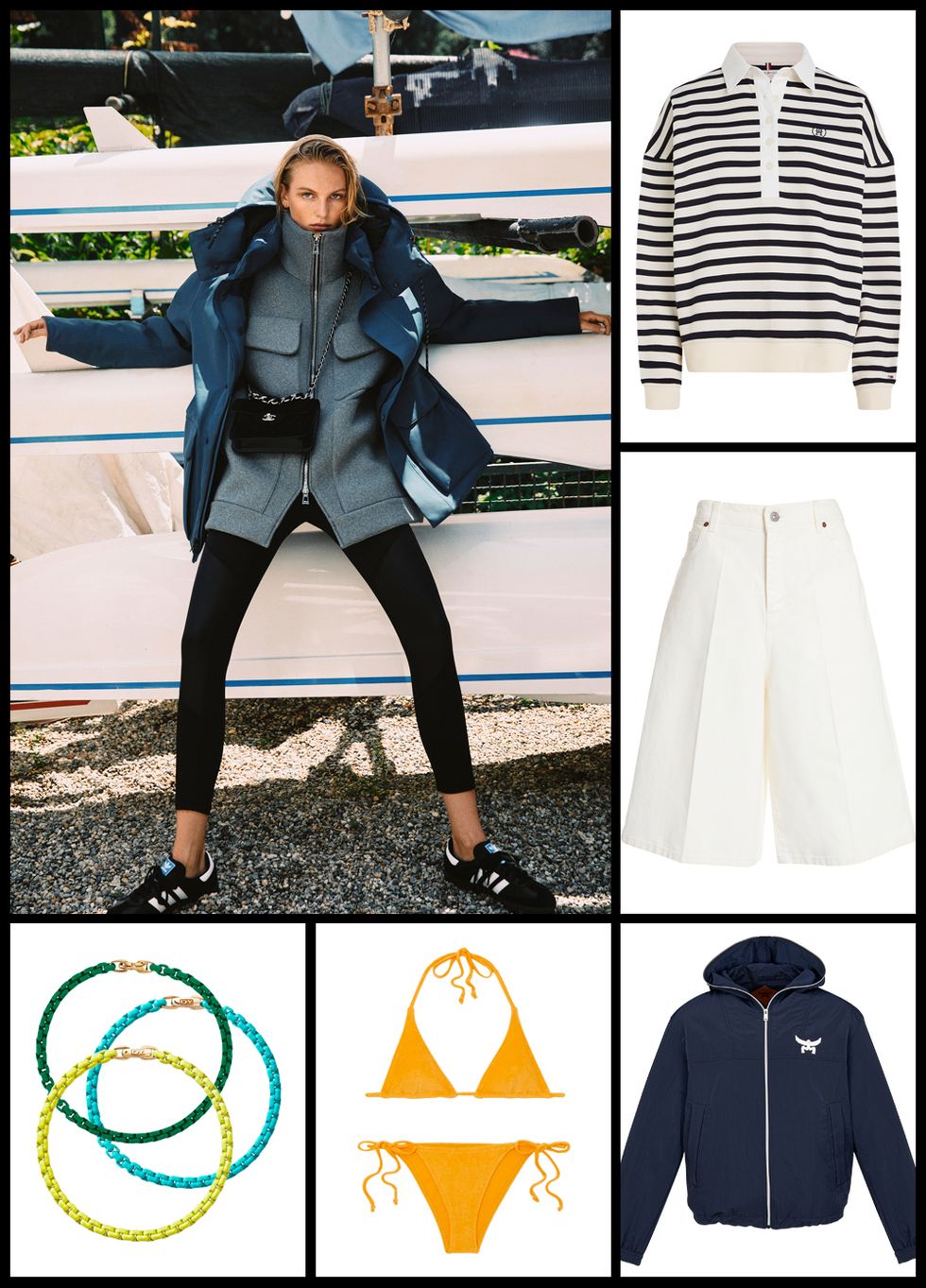
Dries Van Noten Retro Runner Sneakers
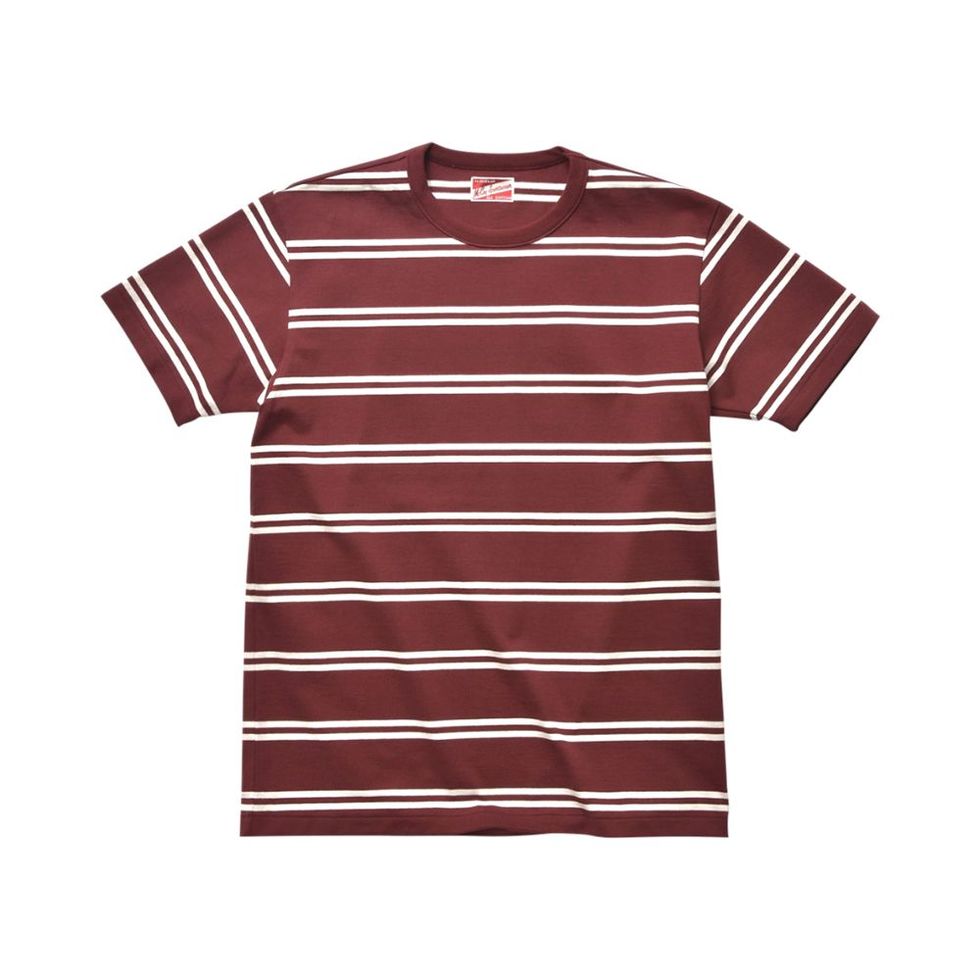
Joe McCoy Double Stripe Tee
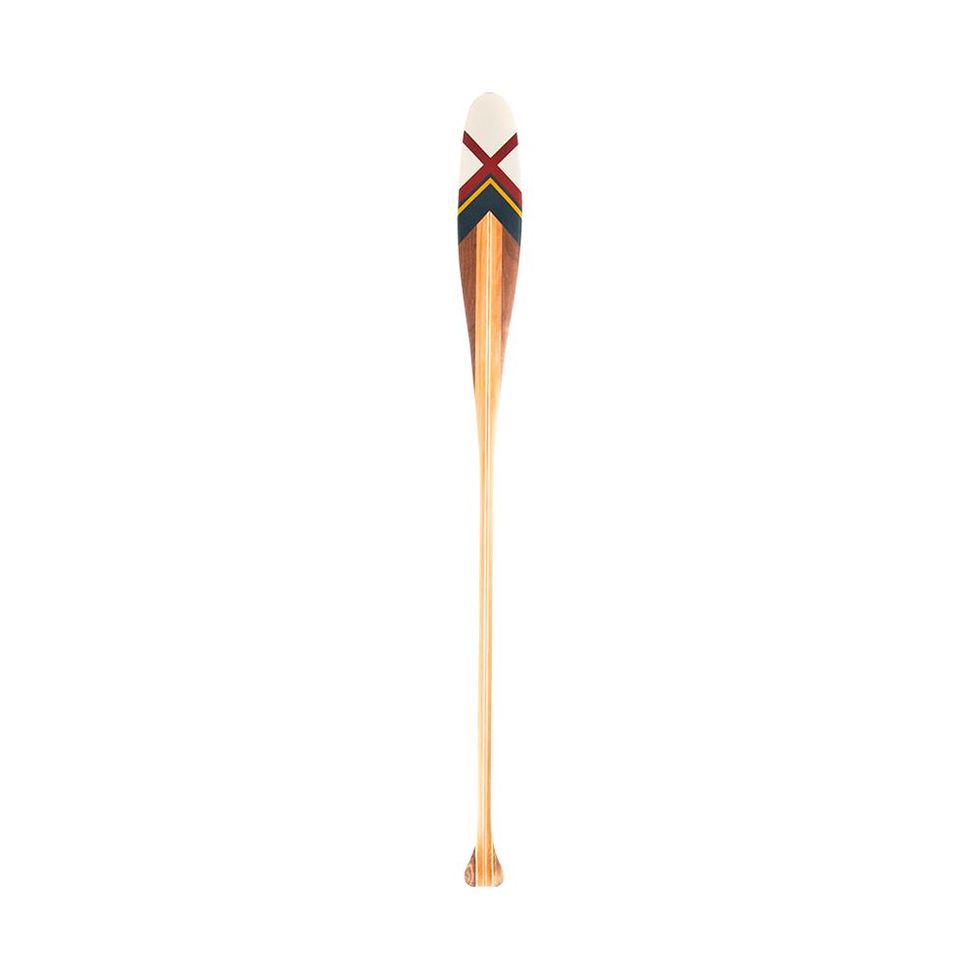
Sanborn Canoe Maquoketa Canoe Paddle
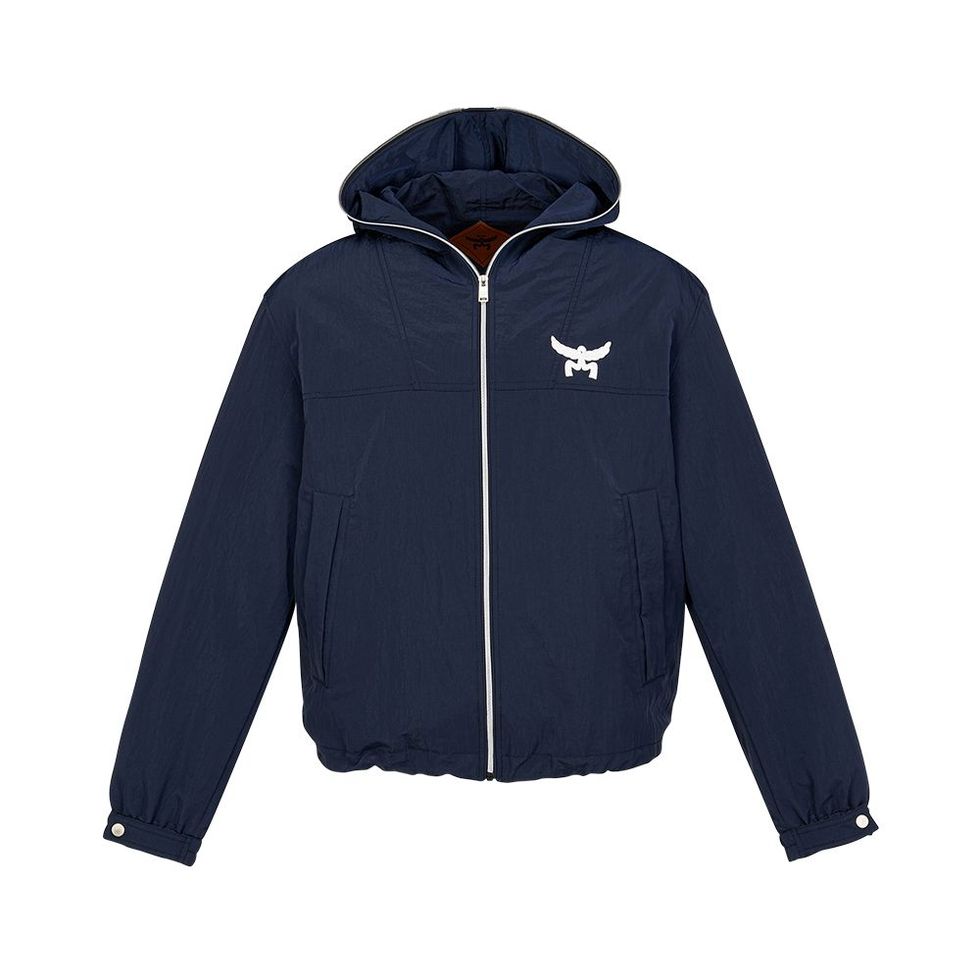
MCM Laurel Logo Windbreaker
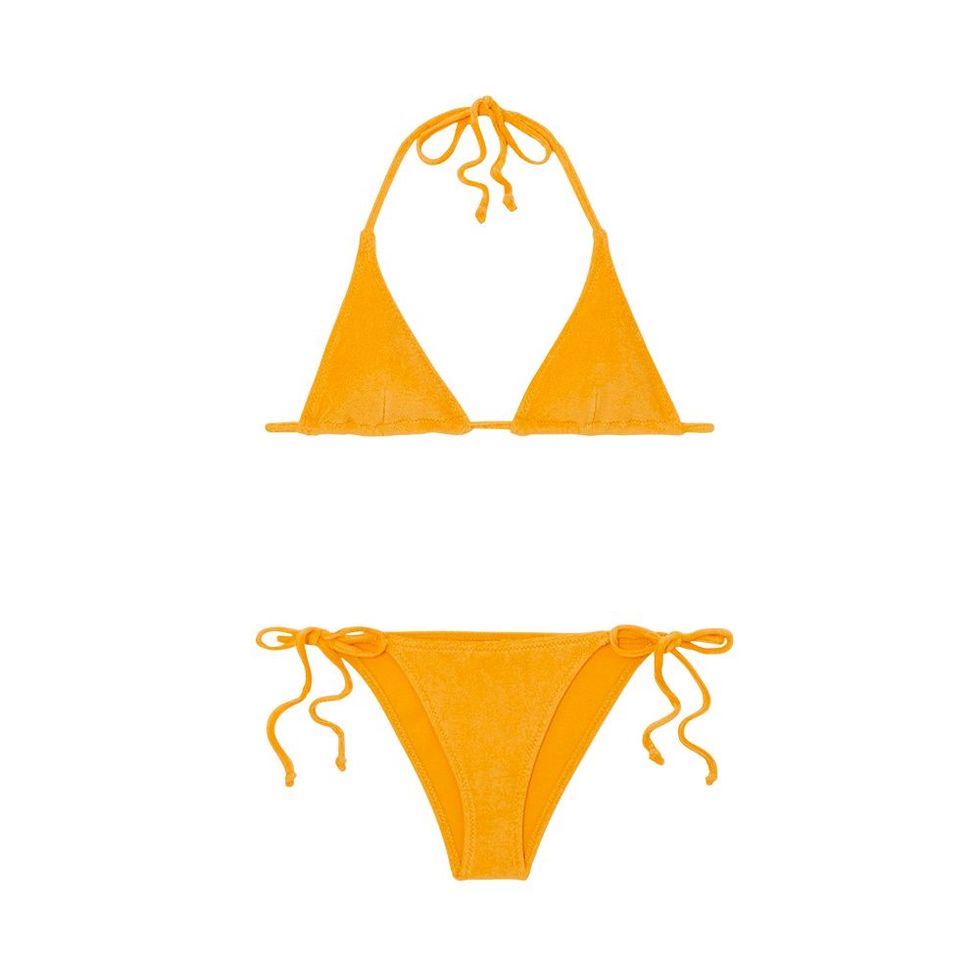
Lisa Marie Fernandez Pamela Terry Bikini
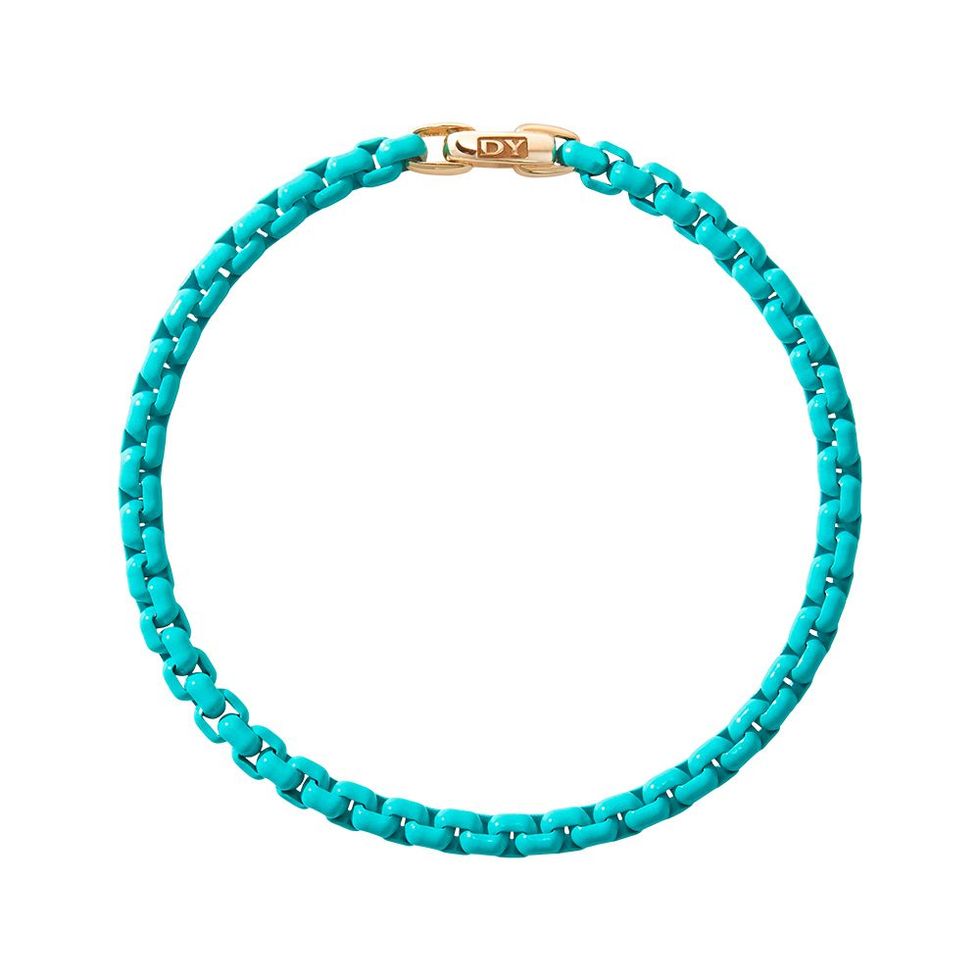
David Yurman DY Bel Aire Color Box Chain Bracelet
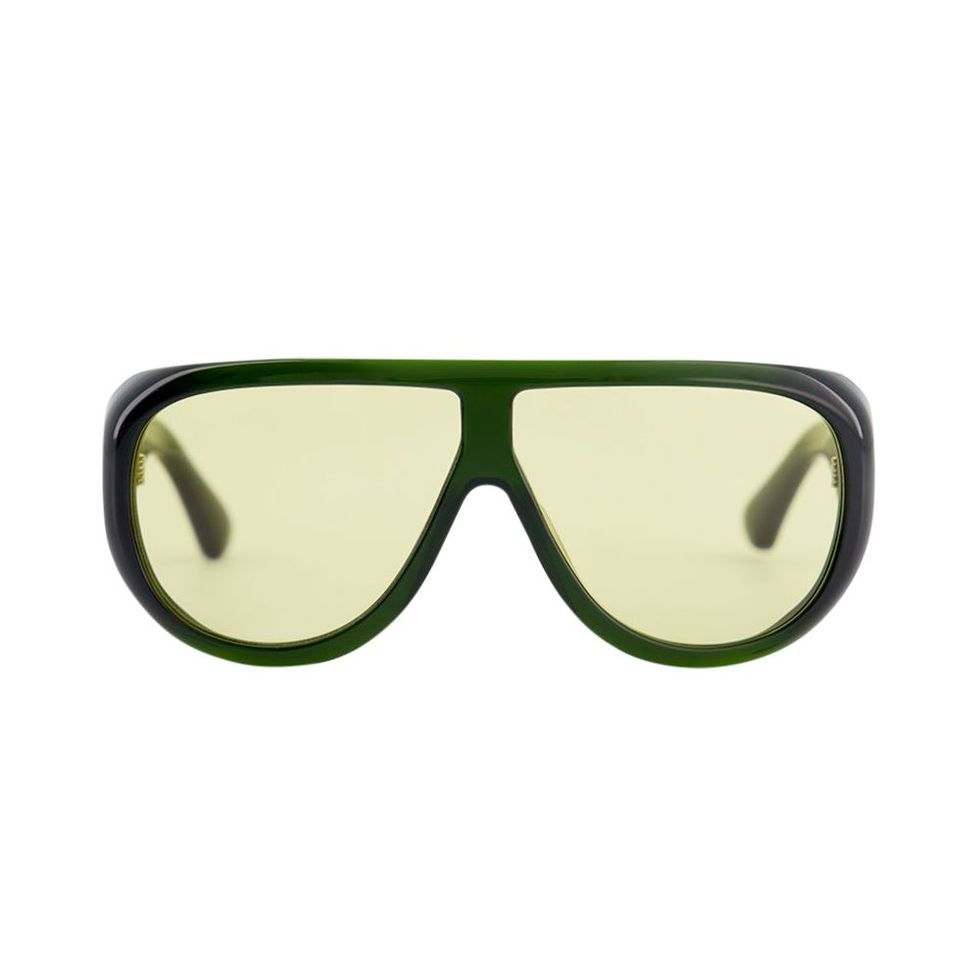
Port Tanger Gambia Sunglasses
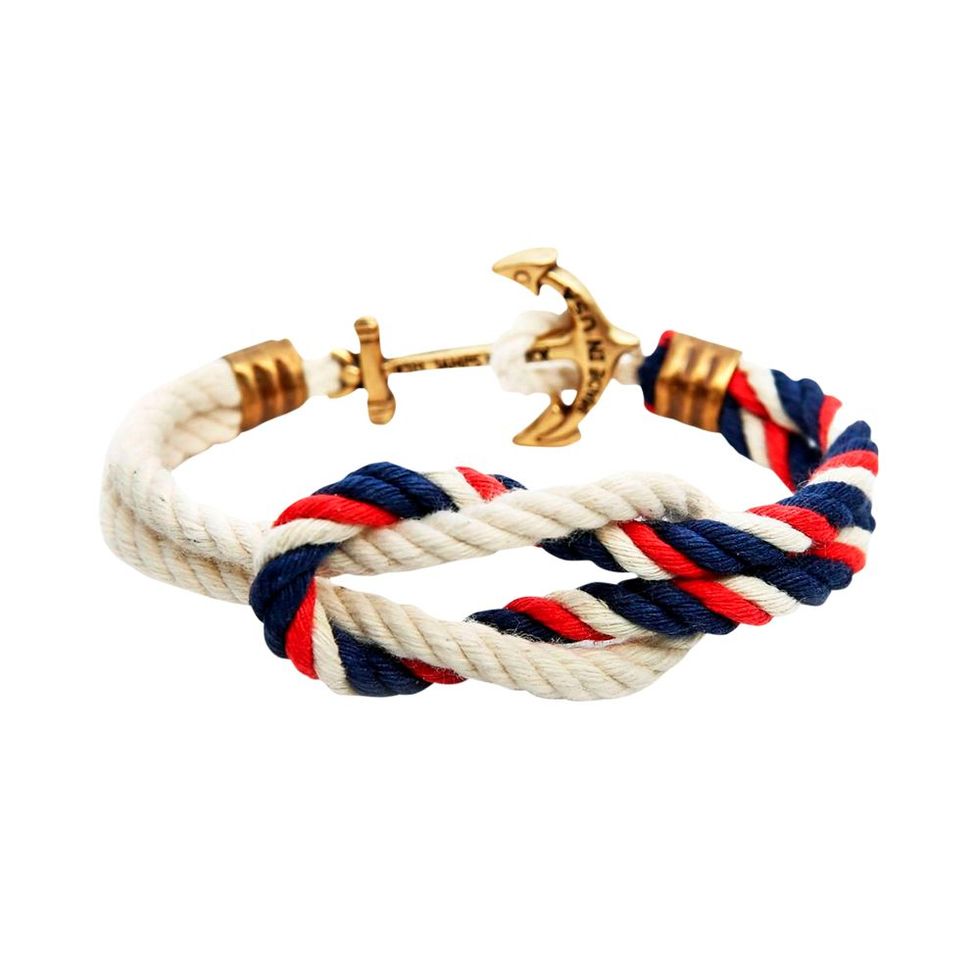
Kiel James Patrick American Classic

Marant Étoile Alec Open-Knit Sweater
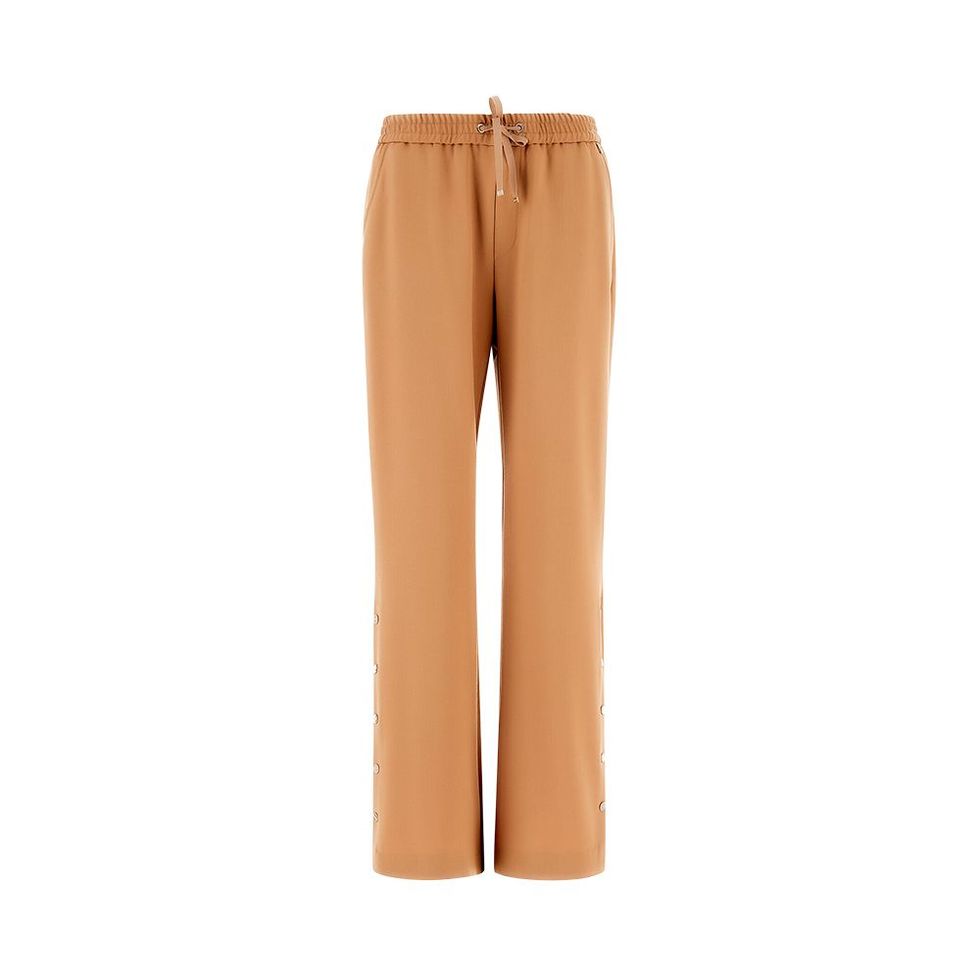
Herno Stretch Trousers
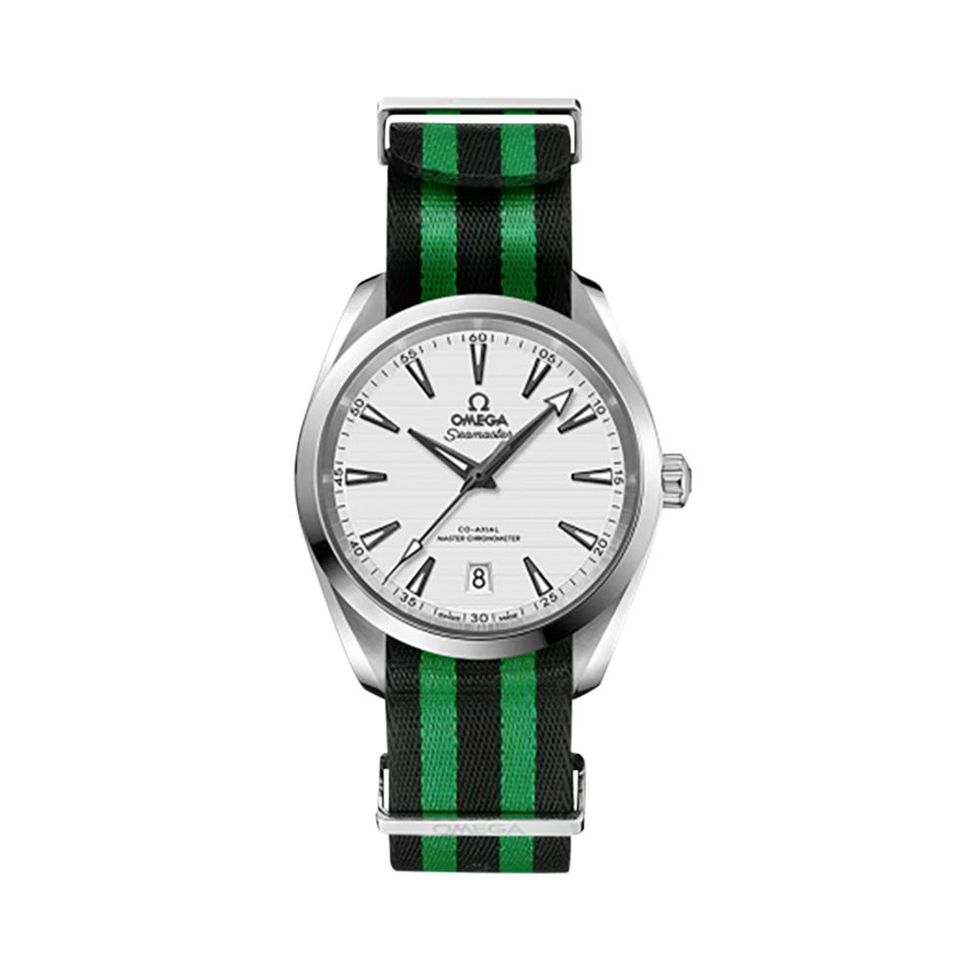
Omega Seamaster Aqua Terra 150m
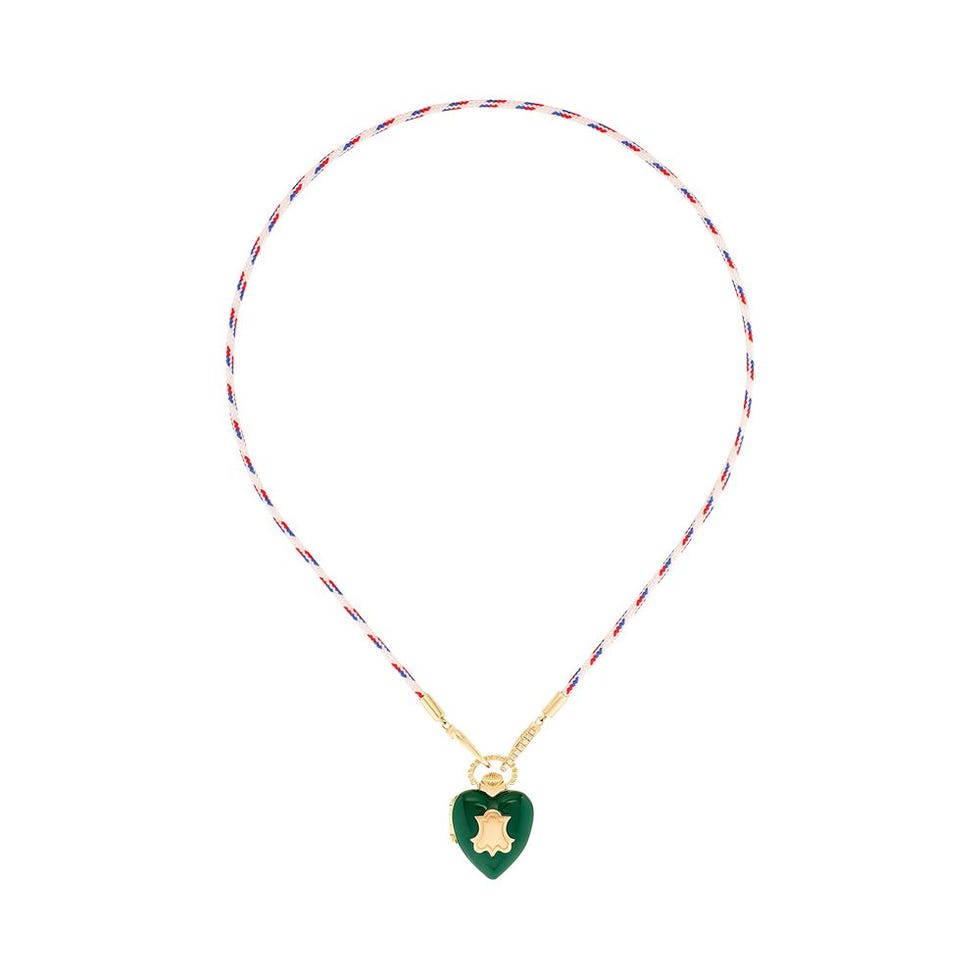
Ben The You Vault Pendant Necklace
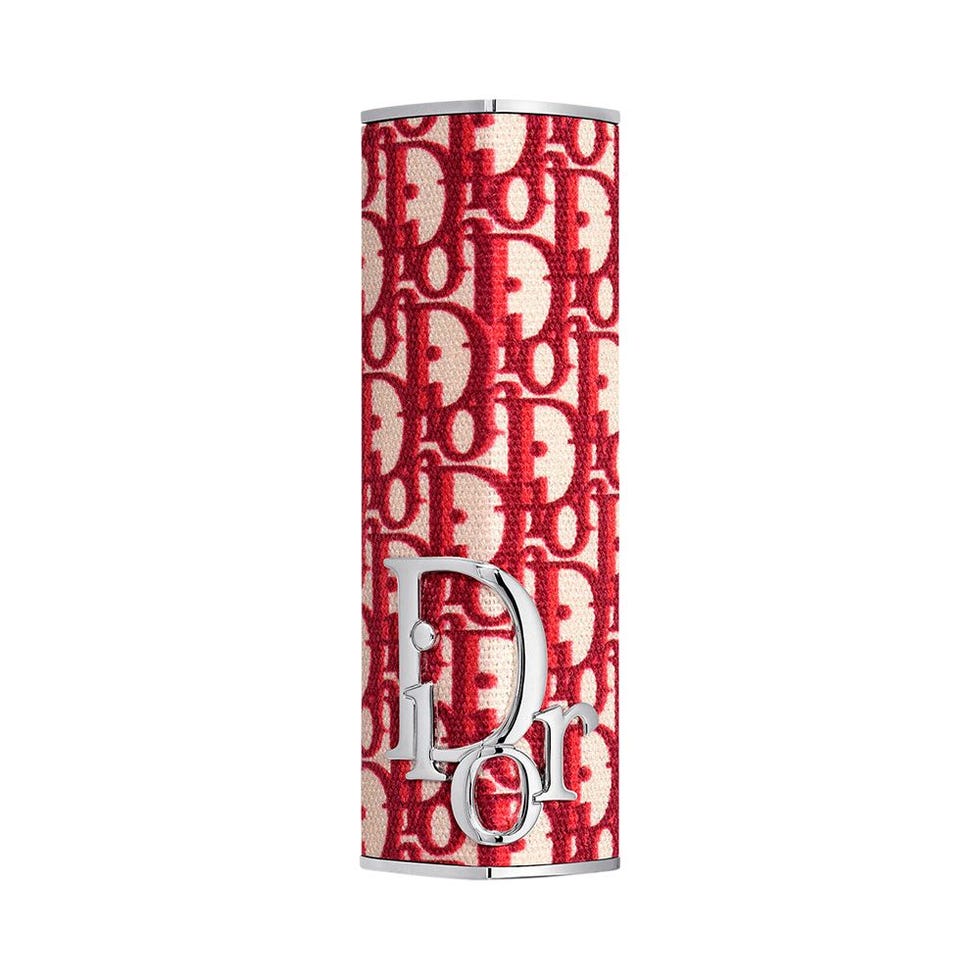
Dior Dior Addict Case
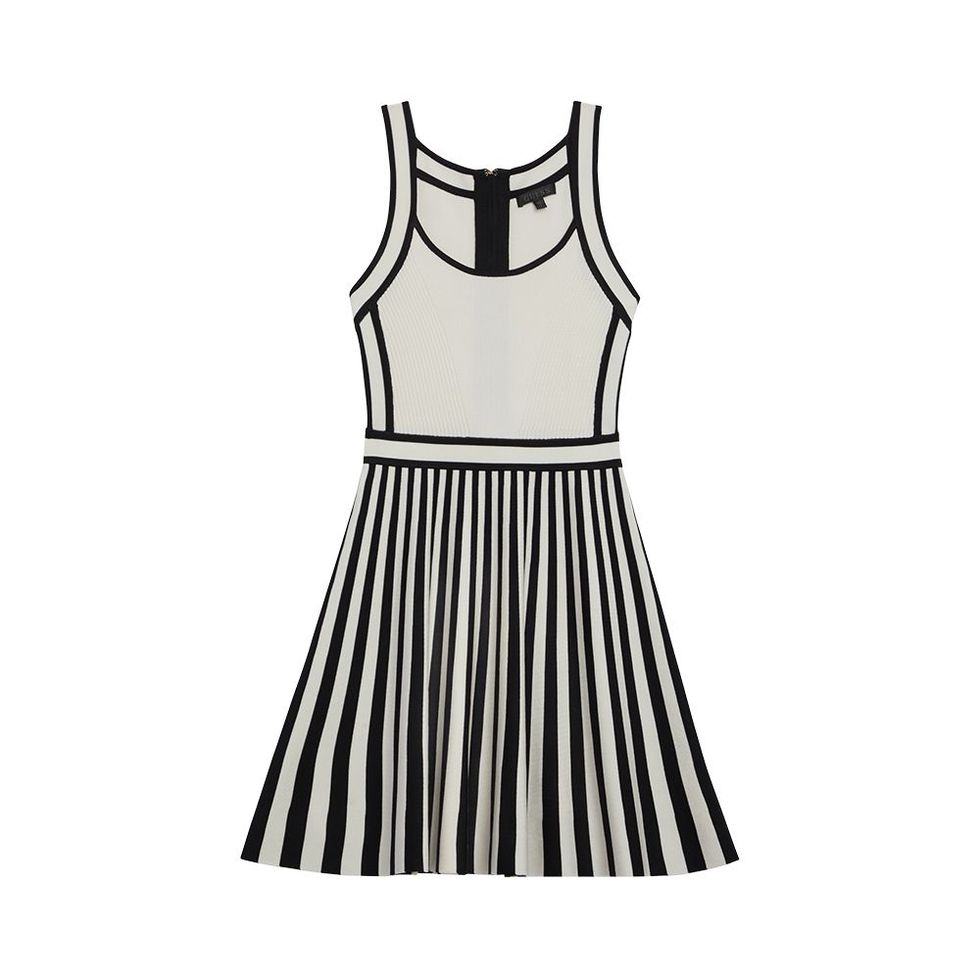
Guess Mirage Nautical Sweater Dress
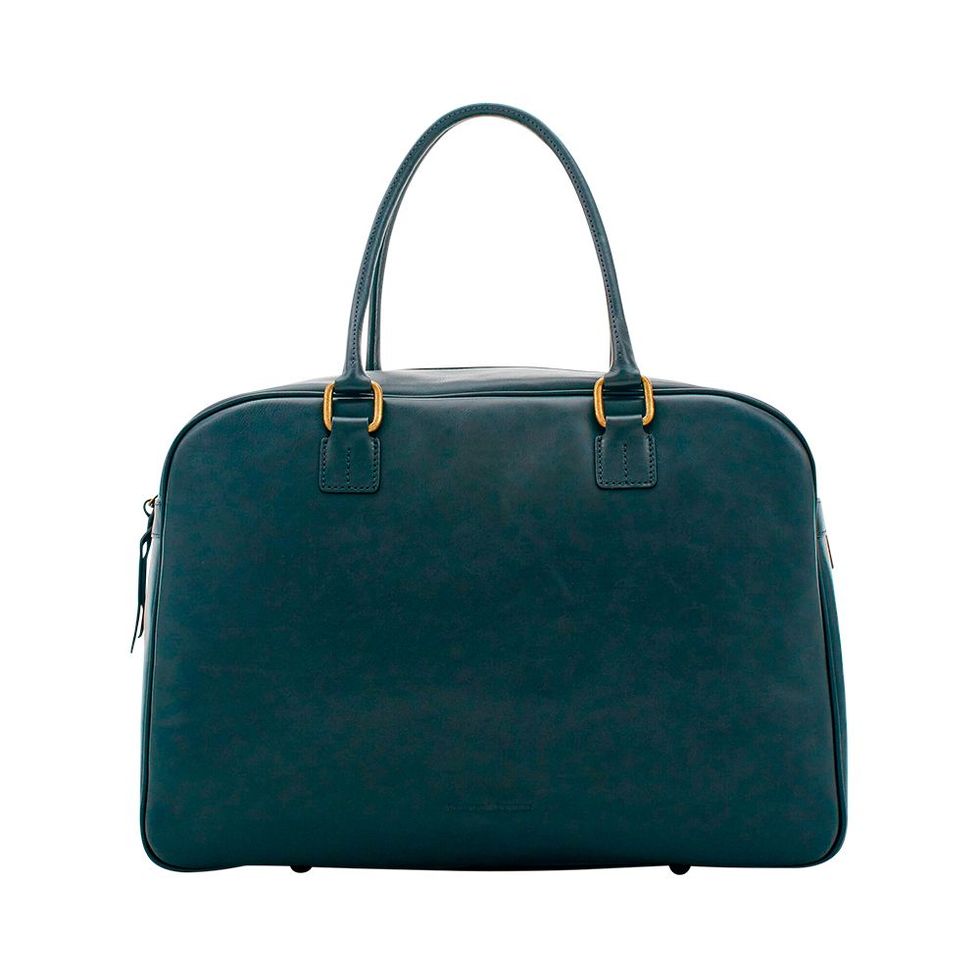
Dooney & Bourke Florentine Bowler Duffle
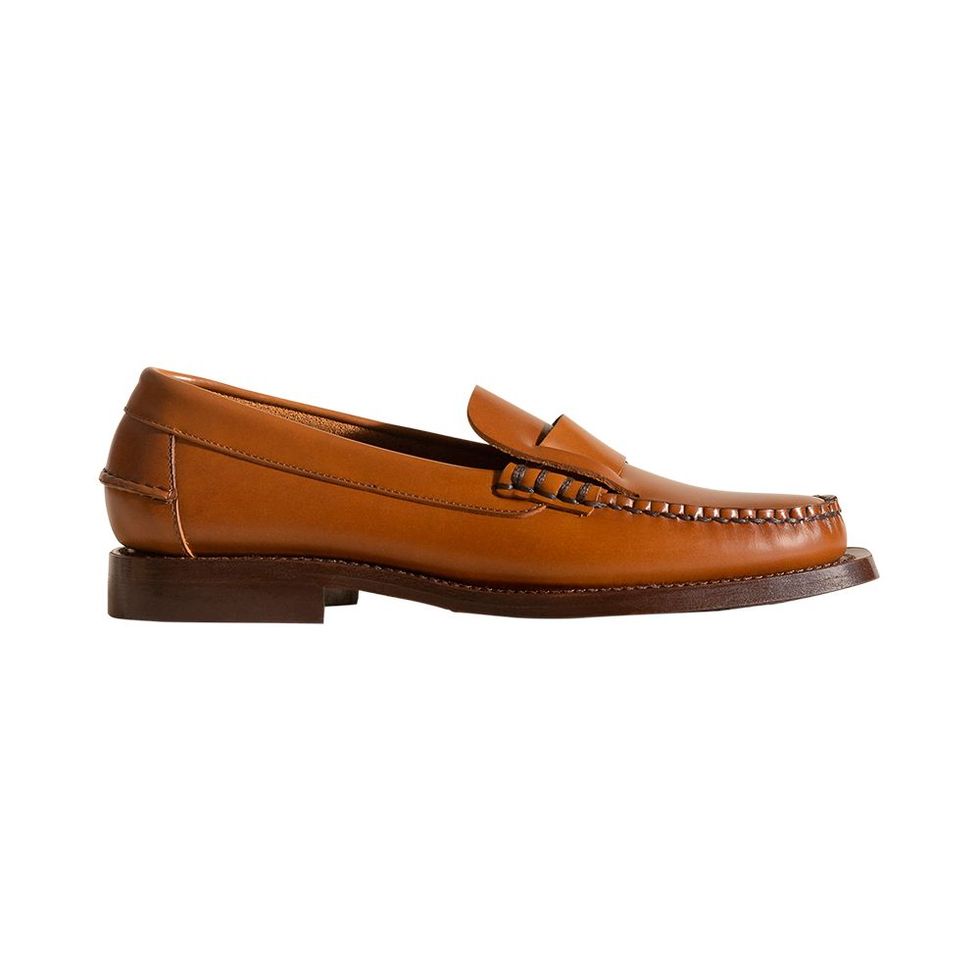
Hereu Sineu Slip-on Loafers
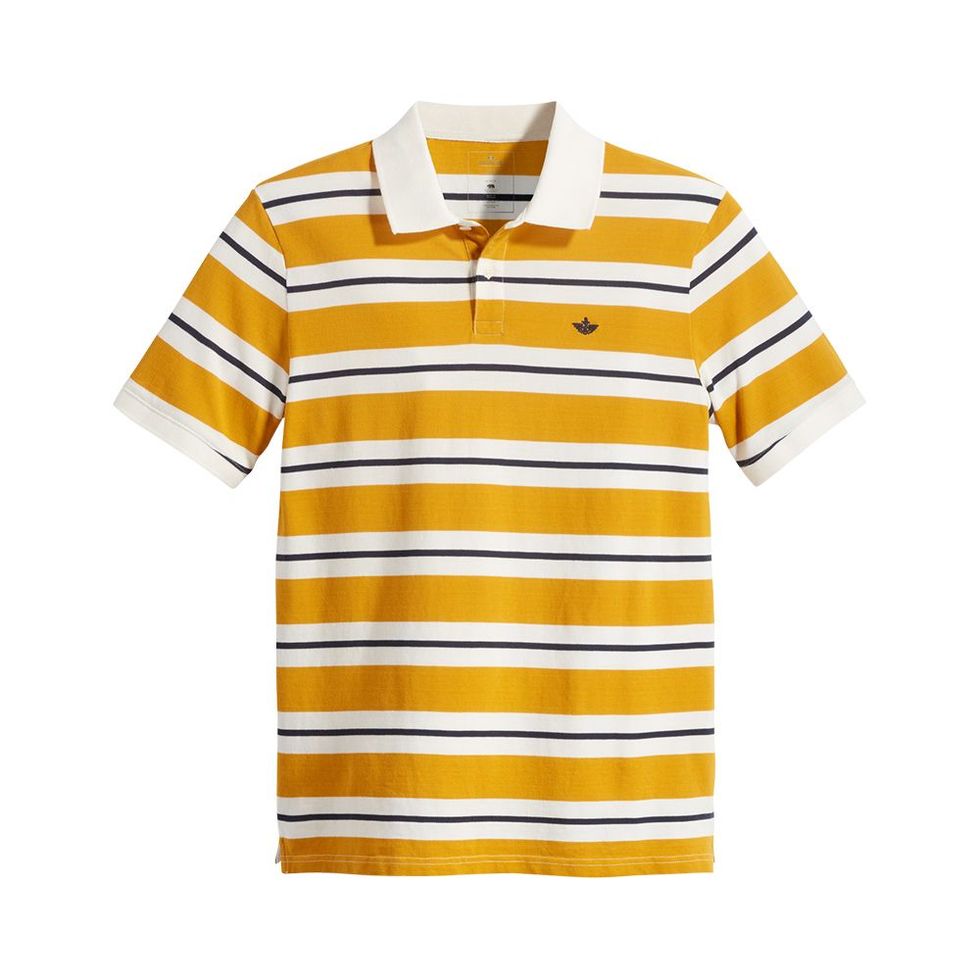
Dockers Rib Collar Polo
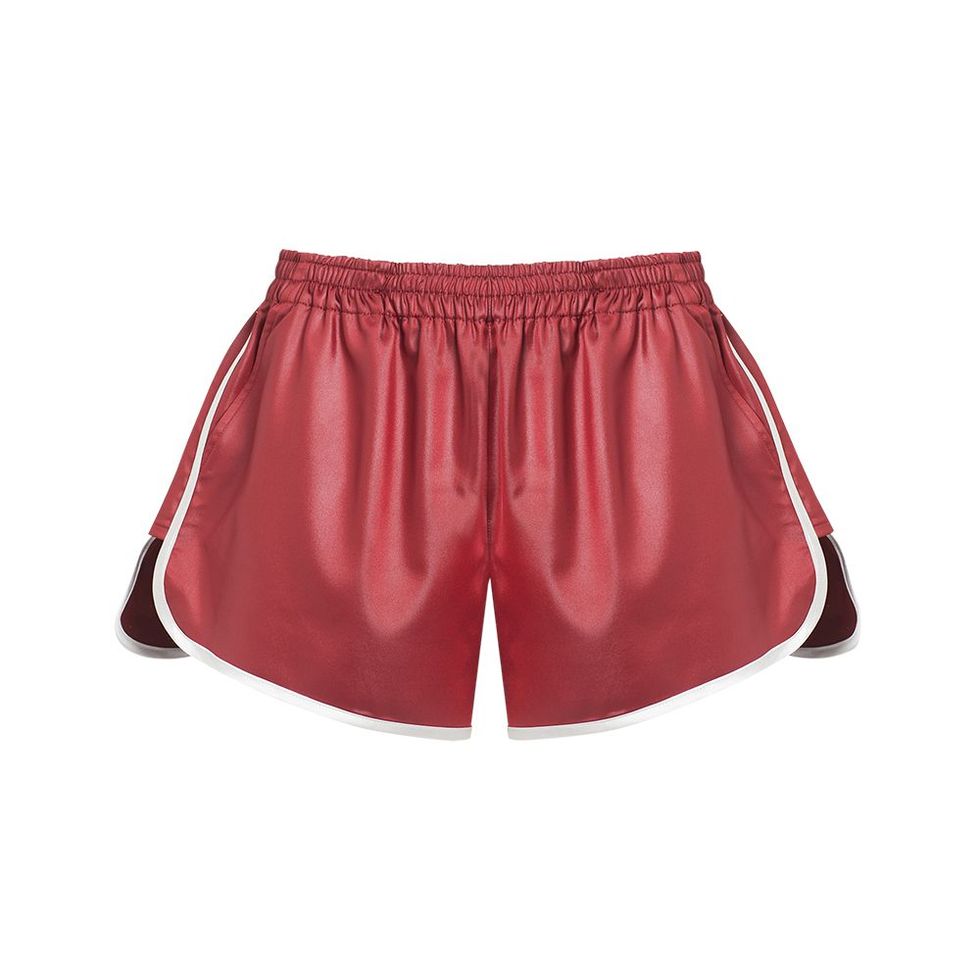
Mango Satin Shorts

The Best-Dressed Celebrities at the 2024 SAGs

17 Area Rugs

A First Look at Jhoan Sebastian Grey for HSN

The Best Street Style From Milan Fashion Week

The Launch: Fashion News to Know This February

Shop the 16 Best Hobo Bags for Effortless Style
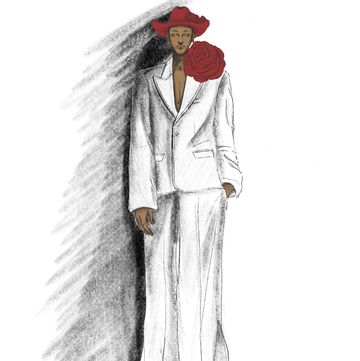
Willy Chavarria Reacts to His First ELLE Cover

This Spring, Fashion Gets Bold and Bright
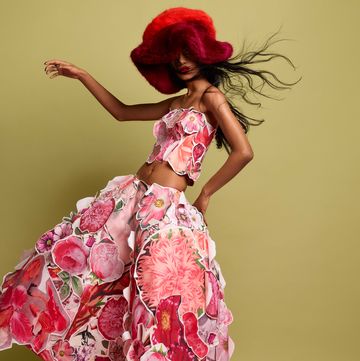
Spring Is for the Shape Shifters
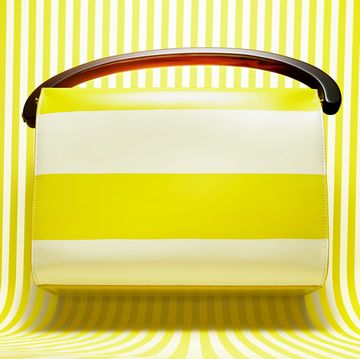
Spring’s Must-Have Striped Accessories

Vittoria Ceretti Is the Ultimate Supermodel
- Tomilino Tourism
- Tomilino Hotels
- Tomilino Bed and Breakfast
- Tomilino Vacation Rentals
- Flights to Tomilino
- Tomilino Restaurants
- Things to Do in Tomilino
- Tomilino Travel Forum
- Tomilino Photos
- Tomilino Map
- All Tomilino Hotels
- Tomilino Hotel Deals
- Hotels near Museum of Moscow Helicopter Plant of Mil
- Hotels near Museum Zvezda
- Hotel Xcaret Mexico
- The LINQ Hotel + Experience
- Flamingo Las Vegas
- Mandalay Bay Resort & Casino
- Hyatt Ziva Cancun
- Dreams Macao Beach Punta Cana
- Hotel Riu Montego Bay
- Moon Palace Cancun
- Excellence Oyster Bay
- Secrets Cap Cana Resort & Spa
- Beaches Turks & Caicos
- Secrets Moxche Playa del Carmen
- Hotel Riu Republica
- Secrets Maroma Beach Riviera Cancun
- Hotel Riu Palace Kukulkan
- All Tomilino Restaurants
- Arabic Restaurants in Tomilino
- Chinese Restaurants in Tomilino
- Japanese Restaurants in Tomilino
- Korean Restaurants in Tomilino
- Middle Eastern Restaurants in Tomilino
- Russian Restaurants in Tomilino
- Travelers' Choice
- Help Center
- Moscow Oblast
- Tomilino
- Tomilino Restaurants
Ratings and reviews
Location and contact, california, tomilino - restaurant reviews - tripadvisor.

California Yacht Club was established in 1922 and boated its' first competitive rowing team back in the 1930's. In 1977, after a long hiatus, Stan Mullin, Ken Jacobs and Charles Hathaway reactivated rowing at the Club. CYC rowers now number about 60, and represent all abilities, ages and motivations.
Adult Rowing - California Yacht Club CYC is a great place for adults of all ages and skills to row out of Marina Del Rey. We have more than 60 active adult rowers with a wide range of interests and motivations varying from recreational, fitness, social, open water, and racing.
CYC Rowing - California Yacht Club - Rowing About us CYC Junior Rowing CYC offers a range of rowing programs suitable for girls and boys ages 12 - 18. CYC membership is not required to participate. Our junior rowing programs include: a highly successful competitive rowing team, a recreational program and private lessons.
Everyone at the California Yacht Club is devastated by the fire that took place at the structure of our historic club on Monday, December 11, 2023. We want to extend our sincere thanks to the Los Angeles County Fire Department for their rapid response and intensive efforts to extinguish the fire. We are committed to working with the fire ...
Junior Sailing and Rowing Program. Open to all youths in the community (ages 8-18). Full time Junior staff. Comments: Active power, sail and rowing fleets. Family friendly Club with a full schedule of races, cruises, and social activities.
California Yacht Club's Junior Rowing Program runs seasonally from September through June, and extends into Summer with several two week "Learn to Row" camps. The core instruction of the program is sculling. Singles, doubles and quads are the on the water tools for quality learning, and our inventory of ergometers are used for land training.
California Yacht Club, Marina del Rey, California. 4,778 likes · 133 talking about this · 24,313 were here. The California Yacht Club mission is to...
California Yacht Club was established in 1922 and boated its first competitive rowing team back in the 1930's. In 1977, after a long hiatus, Stan Mullin, Ken Jacobs and Charles Hathaway reactivated rowing at the Club and it has grown since then.
The California Yacht Club has a wonderful community of members who enjoy a packed social calendar of over 400 events throughout the year that features water activities, wine tastings, movies...
California Yacht Club is located at: 4469 Admiralty Way, Marina del Rey, CA 90292. ... California Yacht Club-Junior Rowing. Craig Leeds [email protected] 310.948.1456. and. Anna Wilczek [email protected] 818.523.2987. CYC offers a variety of summer programs for junior age (13 - 18) boys and girls. CYC membership is not required to enroll.
J/70 Worlds 2021 : Peter Duncan's Relative Obscurity has prevailed over 60 other teams and challenging wind conditions to capture the 2021 J/70 World Championship title at California Yacht Club, today. In a five-day series that tested the skill and patience of top-notch competitors from 11 nations, Duncan - sailing with Willem van Waay, Morgan Trubovich and Victor Diaz de Leon - secured ...
Congratulations to the California Yacht Club Rowing Team on an impressive showing at the Long Beach Christmas regatta! 27 medals is an incredible achievement, and we are so proud of all of your hard...
The California Yacht Club is owned by the Hathaway family, owners of the Los Angeles Athletic Club. The annual "Great Catalina to Marina del Rey Rowing and Paddling Event" pays tribute to Charles Hathaway's row in 1976 from Catalina Island to the club on his 50th birthday.
3,429 Followers, 1,052 Following, 637 Posts - See Instagram photos and videos from California Yacht Club (@calyachtclub) 3,429 Followers, 1,052 Following, 637 Posts - See Instagram photos and videos from California Yacht Club (@calyachtclub) Something went wrong. There's an issue and the page could not be loaded. ...
515 Followers, 265 Following, 67 Posts - See Instagram photos and videos from California Yacht Club Rowing (@calyachtclubrowing)
• 1st US Rowing Coach to win back-to-back Gold medals in the Mens Eight (97,98,99) (04,05). ... RC and California Rowing Club • Advisory coach at Cambridge University in England for their annual Boat Race since 1993 • U.S. Men's Olympic Head Coach from 2009-2012 London Olympic Games (Bronze - M4-)
When the California Yacht Club burned in Marina del Rey, prestigious awards, a priceless trophy and cherished photos were lost. Members mourn the club's loss.
The Los Angeles Rowing Club is the oldest rowing club in the city, founded in 1908. The club is located in a historic boathouse in the Marina del Rey harbor and offers programs for rowers of all levels, from beginners to advanced. The club has a competitive racing team, a recreational rowing program, and hosts many social events throughout the ...
Related Articles J/Teams Silver in Southern California Islands Race J/130 1st, J/111 2nd, & J/125 2nd The annual Southern California offshore and coastal racing season kicked off with the 2024 Islands Race, a coastal race co-hosted by Newport Harbor Yacht Club and San Diego Yacht Club since 2010. Posted on 19 Feb BadPak wins 2024 Islands Race Rio100 sets course record The annual Southern ...
The moment of the explosion in Moscow was broadcast on the rowing championship: video. News/Politics 2023-08-11T12:06:55.387Z. 8-Year-Old Boy Killed in Russian Strike on Western Ukraine. News/Politics 2023-08-11T14:26:57.994Z. They were going to reconnaissance the territory: border guards "landed" the occupiers' UAVs near Avdiivka.
Dinamo Elektrostal Moscow - Titles, trophies and places of honor. Men's Euro Hockey League since 2007/2008 (7 participations) . Best result : First Round in 2021/2022; EuroHockey Men's Club Trophy since 2008 . Best result : 1st
Club Risovalshchikov, Moscow: See 7 unbiased reviews of Club Risovalshchikov, rated 4.5 of 5 on Tripadvisor and ranked #4,585 of 15,890 restaurants in Moscow.
Yacht Rock: ELLE's February 2024 Shopping Guide From the rowing club to the runway, preppy classics are making a splash. By Rosie Jarman Published: Feb 21, 2024
California, Tomilino: See unbiased reviews of California, one of 16 Tomilino restaurants listed on Tripadvisor.

IMAGES
VIDEO
COMMENTS
The Aquila 54 Yacht Power Catamaran embodies the reliable features and construction methods of the hundreds of Aquila yachts and boats cruising the waters of the world. This model also enhances on board luxuries with full-size refrigeration and layouts that include 3, 4, and 5 cabin options as well as skipper's quarters and "galley-down ...
Find Aquila 54 boats for sale in your area & across the world on YachtWorld. Offering the best selection of Aquila boats to choose from. ... 2023 Aquila 54 Power Catamaran. US$2,795,000. HMY Yacht Sales Bahia Mar | Pompano Beach, Florida. Request Info; New Arrival; 2024 Aquila 54 Yacht. Request price. MARINE 360 - CANADA | Saint Catharines ...
I ran its most recent launch, the Aquila 54 Yacht Power Catamaran, in Clearwater, Florida—and learned firsthand why 27 hulls were sold before the boat even launched. "We're one of only three companies that design powercats this size," says Lex Raas, head of Aquila's product development. "The others come from sailing cats, so size ...
The Aquila 54 Yacht Power Catamaran has a length overall of 54'2" (16.5 m), a beam of 25'2" (7.68 m) and a draft of 4'5" (1.37 m). With an empty weight of 49,659 lbs. (22,525 kg), 45% fuel and five people onboard, we had an estimated test weight of 56,339 lbs. (24,120 kg). With a pair of Volvo Penta 480-hp D6 diesels turning 4 ...
The Aquila 54 Power Catamaran embodies the reliable features and construction methods of the hundreds of Aquila Power Catamarans cruising the waters of the world. This model, set to debut in 2020, enhances on-board luxuries with full size refrigeration and layouts that include 3, 4, and 5 cabin options as well as skipper's quarters and ...
54 The Aquila 54 Yacht Power Catamaran represents the reliable features and construction methods of the hundreds of Aquila yachts and boats cruising the waters of the world. This model enhances on-board luxuries with full size refrigeration and layouts that include 3, 4, and 5 cabin options as well as skipper's quarters and "galley-down ...
The Aquila 54 power catamaran offers owners a range of options to create their ideal cruising vessel. Sporting a 25-foot, 2-inch beam, the Aquila 54 power catamaran is not lacking when it comes to room for long-distance cruising and entertaining. Everything about this boat is spacious: The flybridge features an outdoor kitchen and room for toys ...
Find Aquila 54 Yacht for sale in your area & across the world on YachtWorld. Offering the best selection of Aquila boats to choose from.
The Aquila 54 catamaran yacht is ideally designed for long range cruising in a variety of sea conditions and for entertaining, with multiple social areas that are loaded with amenities. Owners will delight in panoramic views that fill the master cabin with natural light through large hull side windows, adding to the spacious feeling of the full ...
In all other respects, the Aquila 54 motor catamaran is impeccable: from ease of driving to performance, from comfort for passengers and helmsman (crew) to huge areas for recreation. Unusually comfortable, if the owner wishes, it is a luxury yacht, close in spirit and appearance to superyachts. At the same time, it has excellent driving ...
MarineMax is proud to introduce the all new Aquila 54 Power Catamaran to our current Aquila fleet. Find Your Aquila 54: https://bit.ly/2SbwiNv The Aquila 54 ...
2024. Request Price. The Aquila 54 Yacht Power Catamaran embodies the reliable features and construction methods of the hundreds of Aquila yachts and boats cruising the waters of the world. This model also enhances on-board luxuries with full size refrigeration and layouts that include 3, 4, and 5 cabin options as well as skipper's quarters and ...
Aquila 54 is Open for Inspection. Saturday 17th to Friday 30th, December. We invite you to inspect the Award-winning Aquila 54 on the Gold Coast for a limited time. ... Yacht Power Catamaran. The Aquila A54 is a game changer. Crowned the Multihull of the Year, the options are endless. Select from three, four or five cabin layouts.
The award-winning Aquila 54 power catamaran delivers a world-class cruising experience with the highest CE Class A rating for recreational open ocean capability. LIQUID is durably constructed and features Aquila's signature Portuguese bridge deck with full walkaround enclosed climate-controlled bridge helm and lounge. This sumptuously ...
Learn About Aquila 54: https://bit.ly/3sEEFxfAquila's rapid growth and global success has challenged our international design and engineering teams to elevat...
Find Aquila 54 boats for sale near you, including boat prices, photos, and more. Locate Aquila boat dealers and find your boat at Boat Trader! Sell Your Boat; Find. ... 2023 Aquila 54 Power Catamaran. $2,795,000. $21,871/mo* Pompano Beach, FL 33062 | HMY Yacht Sales Bahia Mar. Request Info; 2021 Aquila 54. $2,167,492.
54 aquilaboats.com Aquila 54 Yacht Power Catamaran Specifications Tankage Accommodation CE certification (internationally recognized) Length overall w/swim platform (exc. anchor roller) 16.5 M / 54' 2" Beam overall 7.68 M / 25' 2" Height above waterline w/ hard top (excluding electrics and electronics) 6.15 M / 20' 2"
Reporting from the 2023 Palma Boat Show, MBY editor Hugo Andreae takes us on a full tour of the Aquila 54 power catamaran...Aquila 54 specificationsLOA: 54ft...
Request Info; Price Drop; 2021 Aquila 54. US$1,599,000. ... Power Catamaran boats for sale on YachtWorld are available in a range of prices from $37,790 on the more modest side up to $11,153,771 for the rarest of yachts. Remember the cost ..... Description. 2019 Serenity 64 Hybrid. Glide Through Paradise in Blissful Silence: The Eco-Luxurious ...
The Aquila 54 Yacht Power Catamaran embodies the reliable features and construction methods of the hundreds of Aquila yachts and boats cruising the waters of the world. Owners will delight in panoramic views that fill the master cabin with natural light h large hull side windows, adding to the spacious feeling of the full-beam forward master ...
There are a wide range of Power Catamaran boats for sale from popular brands like World Cat, Aquila and Twin Vee with 533 new and 701 used and an average price of $457,008 with boats ranging from as little as $18,176 and $7,244,759. High performance boats for sale.
Built by the famous Dynamique Yachts shipyard and having undergone a refit in 2018, sailing Yacht Amadeus was designed to please the most demanding of yachtsmen. Built for smooth sailing, this elegant cutter rigged sloop has a sleek hull design, comfortably reaching top speeds of 12 knots and ensuring excellent sailing performance. ..... The 33.5m/109'11" 'Amadeus' sail yacht built by the ...
California Yacht Club was established in 1922 and boated its' first competitive rowing team back in the 1930's. In 1977, after a long hiatus, Stan Mullin, Ken Jacobs and Charles Hathaway reactivated rowing at the Club. CYC rowers now number about 60, and represent all abilities, ages and motivations.... Adult Rowing - California Yacht Club CYC is a great place for adults of all ages and skills ...